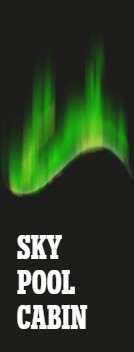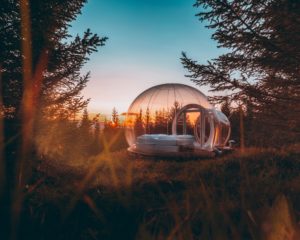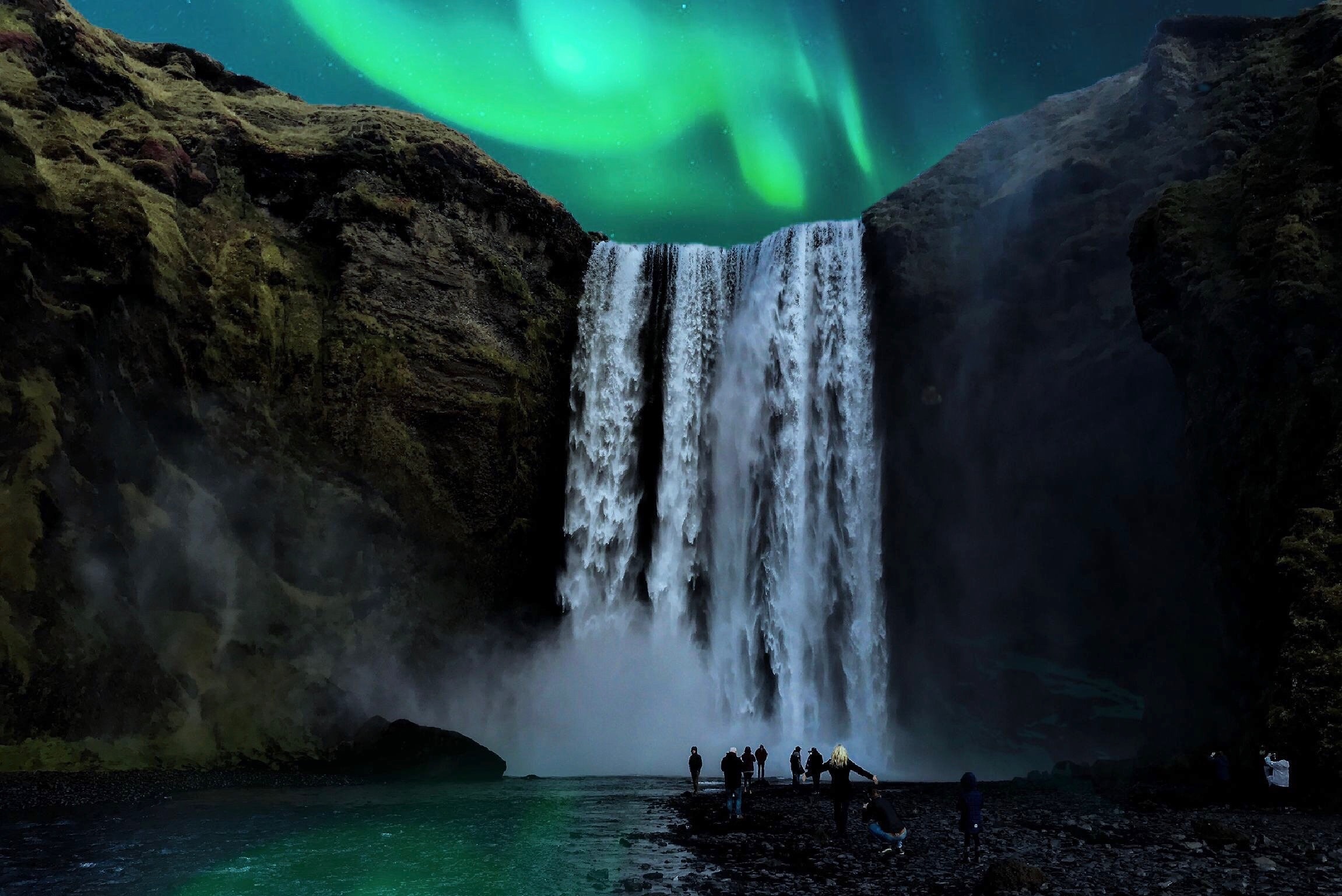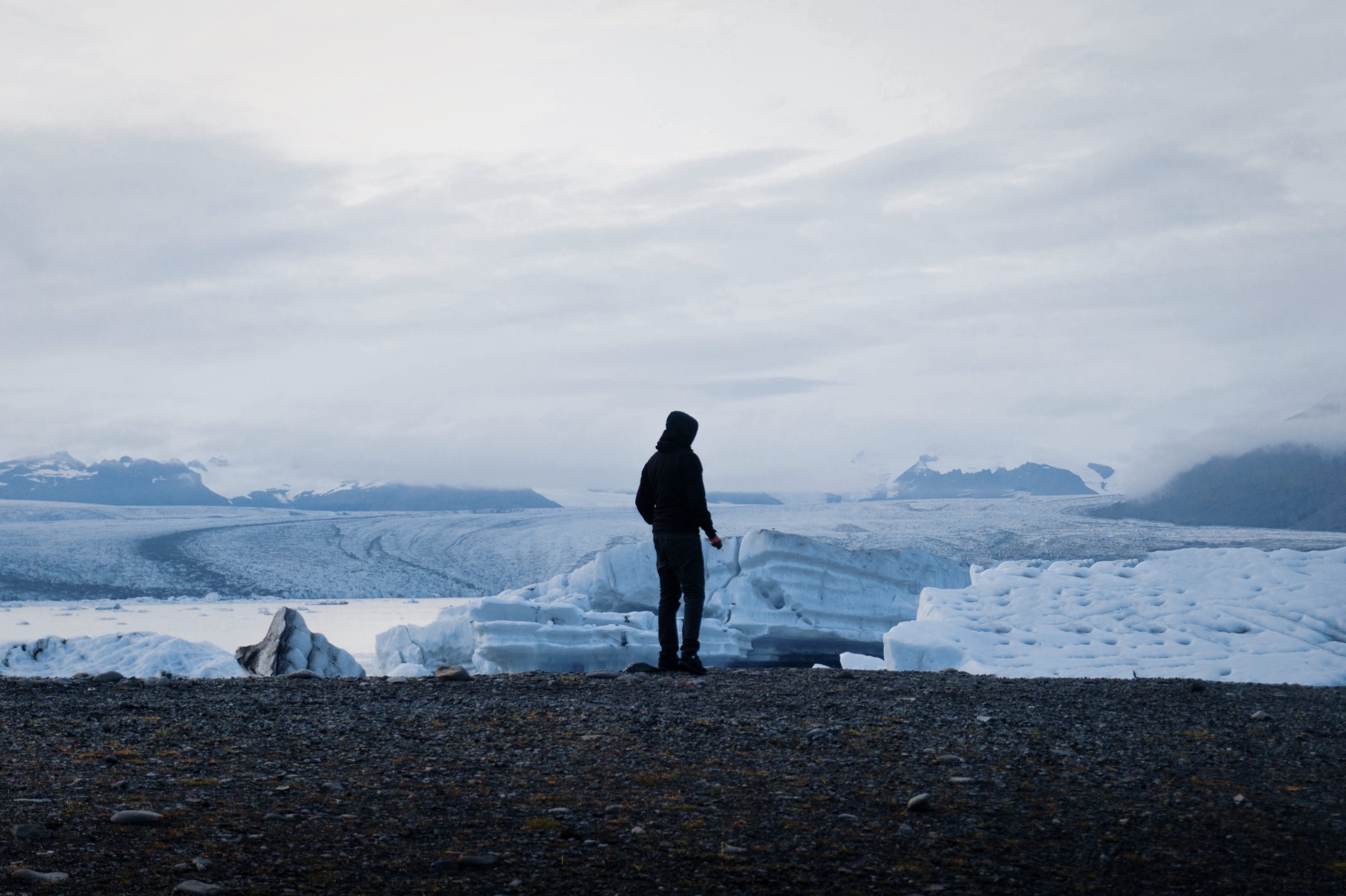Mælifell Volcano | Secret Treasures of the Icelandic Highlands
Mælifell Volcano
By Michael Chapman
An extinct volcano with an unforgettable character
Mælifell Volcano
By Michael Chapman
An extinct volcano with an unforgettable character
You may not know Mælifell volcano by name, but chances are you’ve seen photographs of this iconic Icelandic mountain at some point whilst researching your trip. Such is its prevalence as a subject in tourism campaigns and Iceland photo albums; it has become a de-facto mascot of the Highlands region.
The volcano stands at 791 metres tall, towering like an emerald pyramid far above the obsidian wastes surrounding it. Mælifell’s height is staggering to consider given the entire mountain was once covered by the impenetrable ice sheet of Mýrdalsjökull, 10,000 years before the glacier began its slow retreat.
Where is Maelifell volcano in Iceland?

The Icelandic Highlands cover an enormous chunk of this country’s interior, a genuine and untouchable wilderness where time remains still, and Mother Nature rules without question.
Surrounded by Mælifellssandur black desert, itself intercut with shallow ribbons of glacial meltwater, the steep and visually-inescapable outline of Mælifell is a treat for any visitor looking to discover the area’s greatest treasures.
The region is not as popular with guests as the more famous South Coast and Golden Circle sightseeing routes, but it is without a doubt where Iceland’s environment shines the brightest. Those who make an effort to venture into this untameable realm of shimmering geothermal hills and open-mouth canyons will secure themselves an experience impossible to forget.
PLAN YOUR JOURNEY
Travelling to Iceland?
Check our overnight tours with a driver guide that includes a one night stay in a bubble.
*Starting from ISK 59.900 per person
What does the name Maelifell mean?
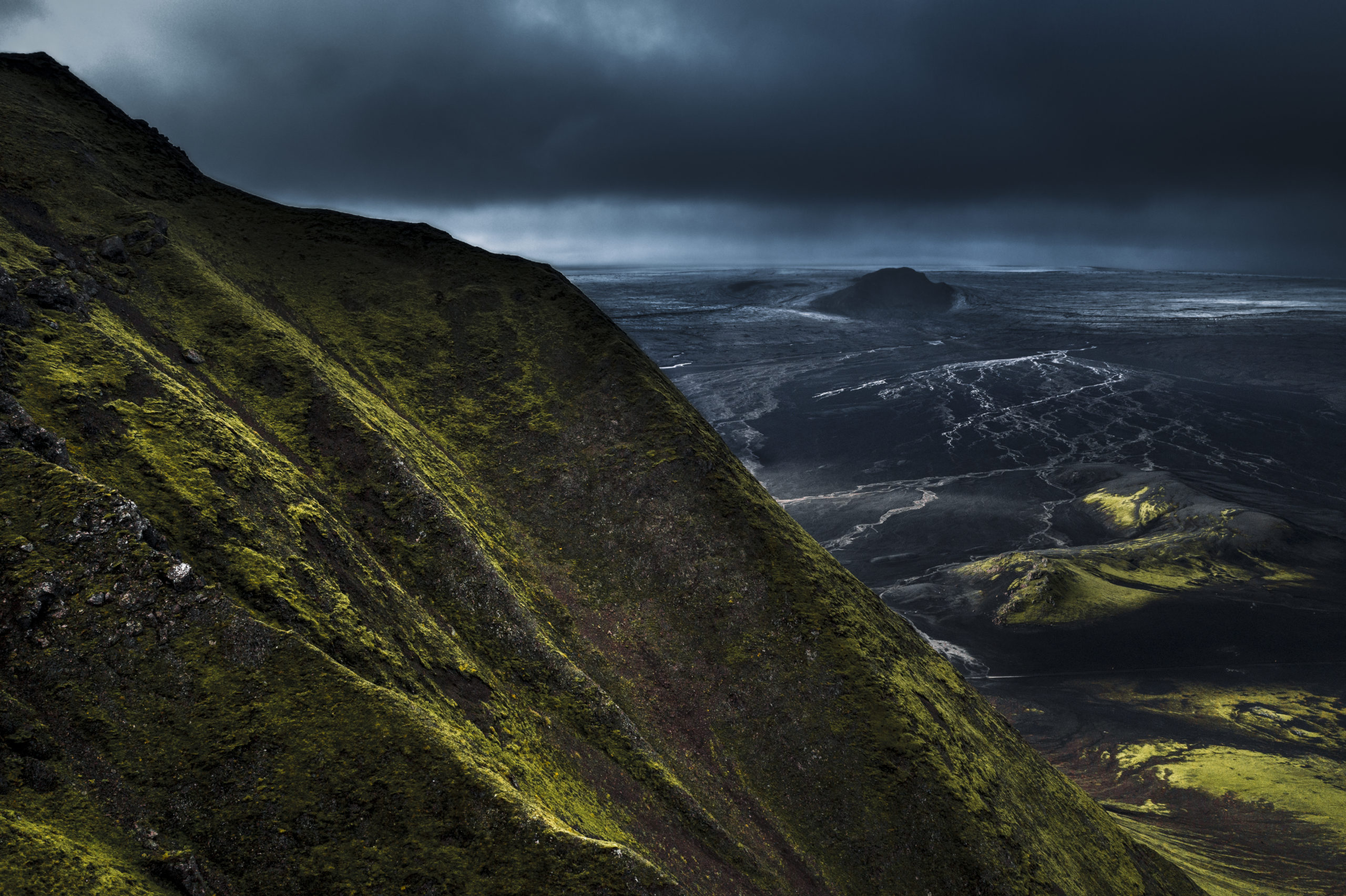
From the emptiness of its surroundings, Maelifell takes its name, ‘Measuring Hill’, with ‘fell’, or ‘fjall’ serving as the Icelandic word for ‘mountain’. In prior centuries, travellers would have used the feature as a distinctive and reliable landmark when moving from one region to another.
Nine other mountains share Maelifell’s name, as early settlers used the term for navigation throughout the years. While this can be a touch confusing, know that it is this Maelifell in particular that has long been held in high-esteem among nature-lovers and landscape photographers.
It is not just Maelifell’s shape that draws the eye, but also its dark green slopes, rising from the middle as if drawn by a master artist. The mountain’s colour is derived from the particular type of cushion moss covering the volcano from its base to its peak.
How to get to Maeilfell volcano in Iceland?
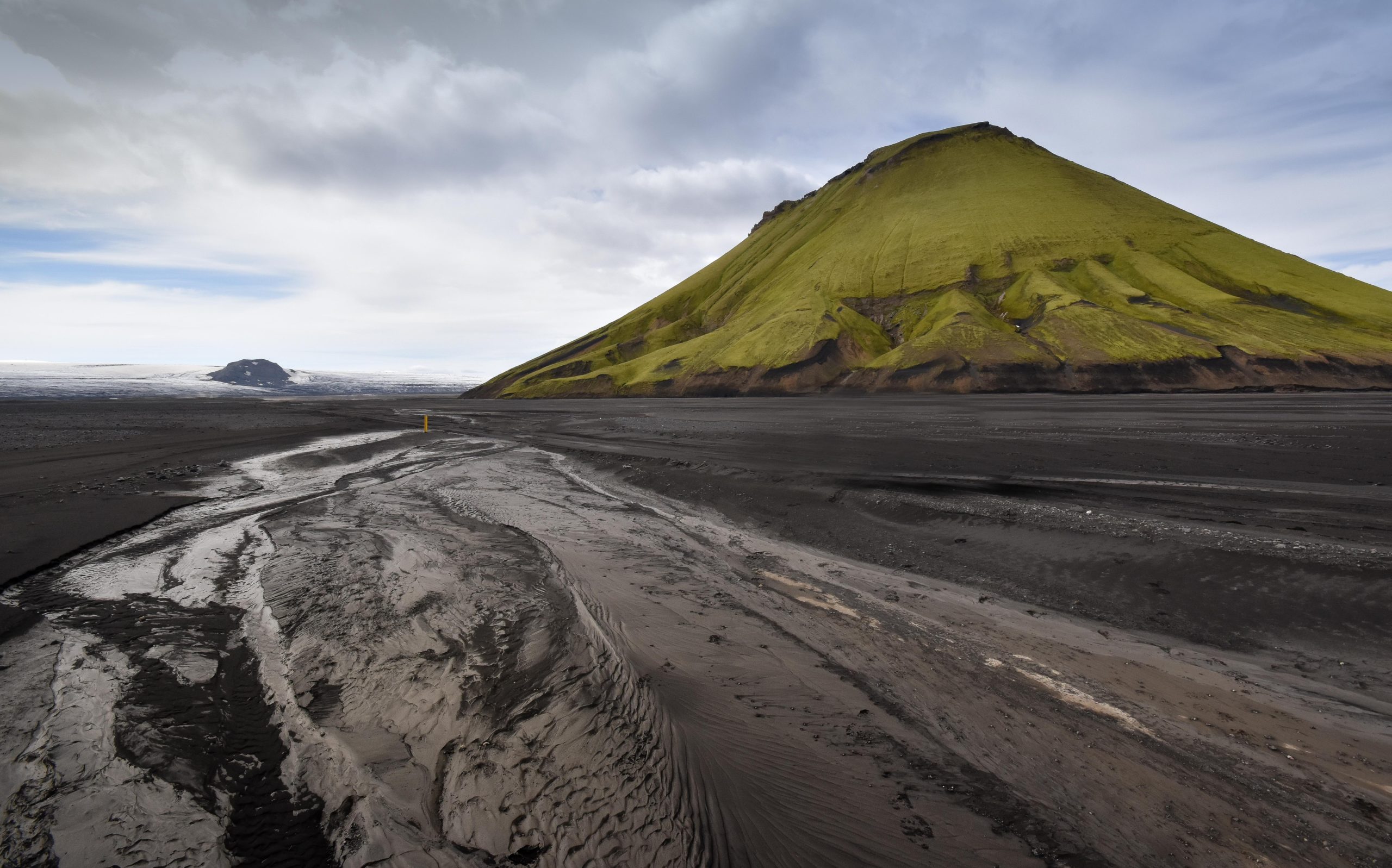
Like all Icelandic Highland locations, Maelifell is only accessible to summer guests, as the winter weather makes the area entirely unpassable. It is always recommended that a tour guide accompany you into the Highlands, and a 4×4 off-road vehicle is a downright necessity for anyone venturing in alone.
There are several access points to the volcano. One could arrive via the F232 gravel road or from the south or west along the F210. Both routes are rough terrain—what did we say about 4x4s?—but are breathtaking journeys.
Guided tours will typically take you to the mountain by SuperJeep, which can handle anything the Icelandic Highlands throw at them. As a passenger en route, you will press your nose to the window looking at the visual delights of Tröllagjáa valley and, of course, the fantastical Mt. Einhyrningur (“Unicorn.”)
Mýrdalsjökull lies north of Vik i Myrdal and Reynisfjara beach and can easily be seen when travelling down the Ring Road along the South Coast. It is the fourth largest glacier in the country, best explored when travelling the Fimmvörðuháls pass hiking route. Travellers on this fabulous trail will see a wide host of other attractions, including Skogafoss waterfall and Eyjafjallajökull glacier.
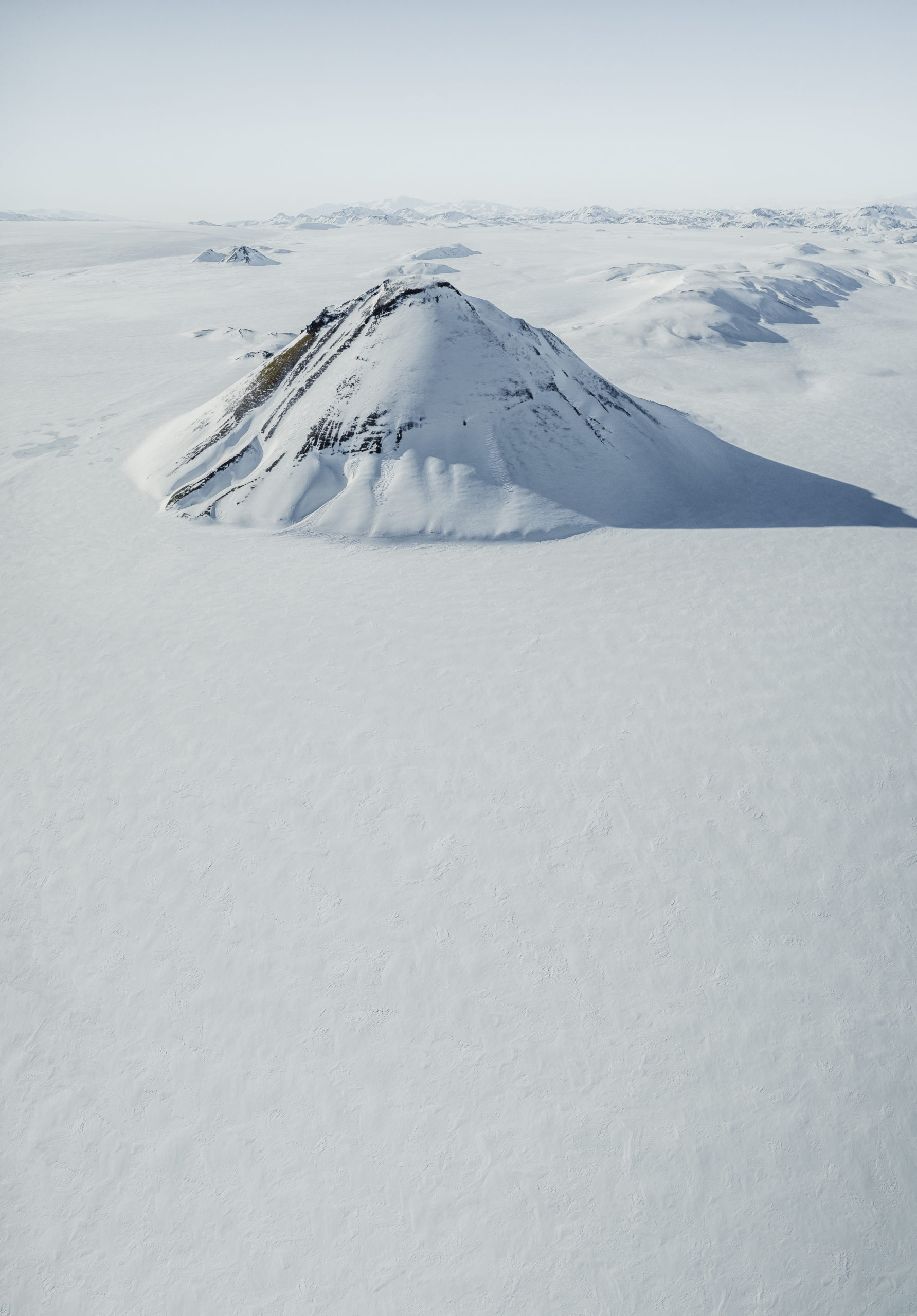
PLAN YOUR JOURNEY
Travelling to Iceland?
Check our overnight tours with a driver guide that includes a one night stay in a bubble.
*Starting from ISK 59.900 per person
What's happening with the explosive Iceland volcano?
What's happening with the Iceland volcano?
By Michael Chapman
Fagragdalsfjall volcano awakens from its slumber
What's happening with the Iceland volcano?
By Michael Chapman
Fagragdalsfjall volcano awakens from its slumber
Last Friday, a volcanic eruption began near Iceland’s capital city, Reykjavik, following weeks of earthquakes across the region.
Forever living up to its nickname, the Land of Ice and Fire, Iceland has again captured the world’s attention after the international media’s reporting on this latest eruption.
What is the Iceland volcano called?
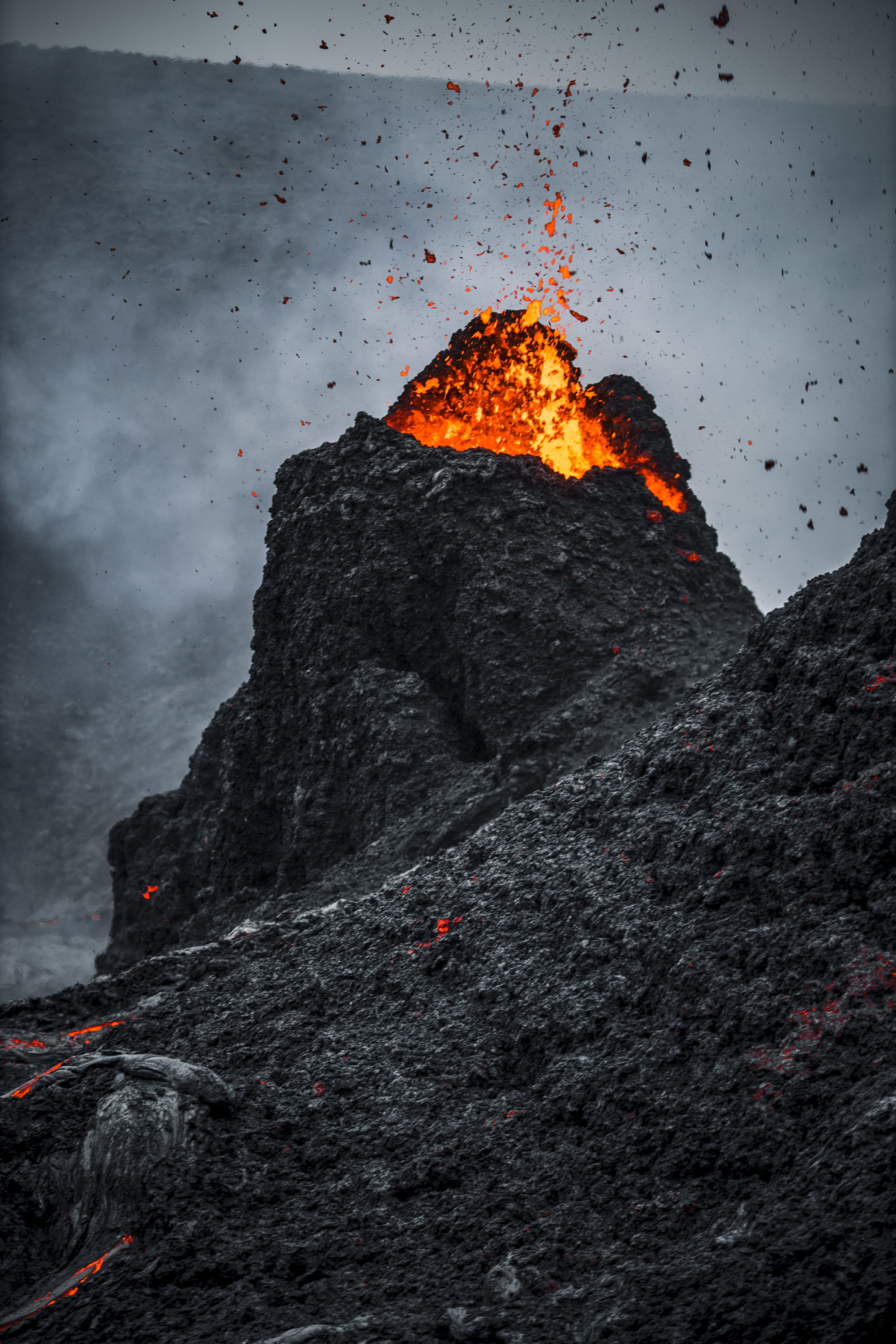
Approximately 20 miles to the city’s southwest, in Geldingardalur Valley, a 6000-year old volcano named Fagradalsfjall is currently underway spewing its molten guts over the surrounding area.
Fagradalsfjall is a tuya volcano, a type of mountain characterised by flat table-top summits and steep edges formed by lava pushing upwards through glacial ice.
The eruption is considered small by Icelandic standards; so small, there has been some debate as to whether to name the event or not. There is no knowing when the volcano will stop erupting, with some Icelandic geophysicists claiming the event could last many more months.
Despite its small stature, the volcano is powerful enough to shoot its fountain of molten lava over 300 feet into the air and has created a 1,640 foot-long fissure in the ground. For those on-site, a creeping, bright-orange lava flow is visible on the mountain, creating a stark colour contrast to the green hillsides around it.
PLAN YOUR JOURNEY
Travelling to Iceland?
Check our overnight tours with a driver guide that includes a one night stay in a bubble.
*Starting from ISK 59.900 per person
Is the Iceland volcano is dangerous?
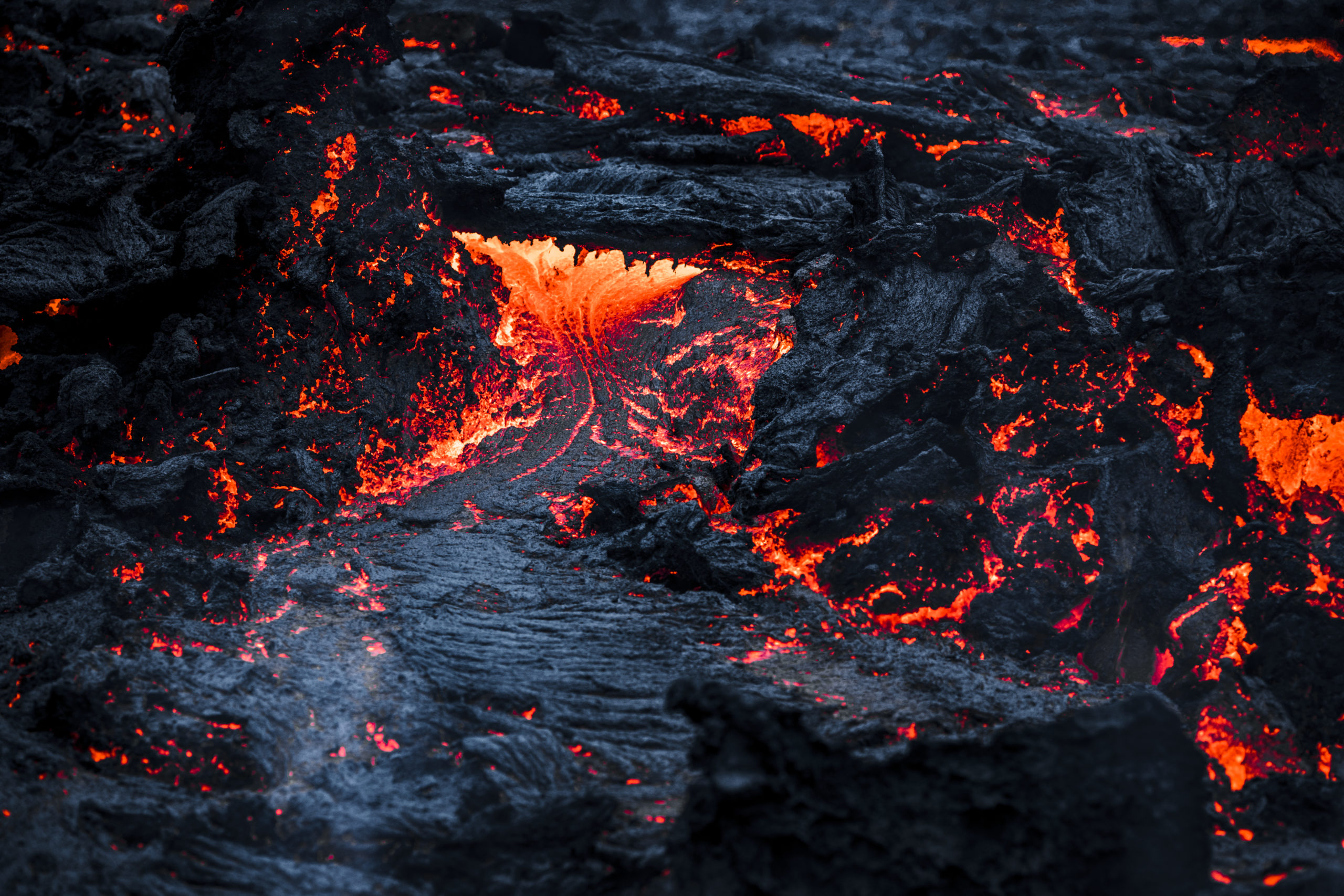
As one would expect, this is a visually-impressive natural spectacle, one that has drawn thousands of interested locals over the weekend who are all looking to witness the display for themselves.
Local officials have warned the Iceland volcano may still be in its early stages, citing the danger of more open fissures to come, thus have now restricted some travel to the site. Drones were also temporarily banned to allow scientists to take samples of the volcano undisturbed, though this has now been lifted.
Iceland’s Prime Minister, Katrín Jakobsdóttir, reiterated the risks on Twitter, writing, “We are monitoring the situation closely, and as of now it is not considered a threat to surrounding towns. We ask people to keep away from the immediate area and stay safe.”
Due to its location amid the dark rocky fields of Reykjanes, there is little danger of gas pollution reaching settled areas. However, the police have advised that people close their windows and stay outside for only short periods in case the winds should change direction.
One little Iceland volcano sure can cause a lot of trouble…
How has the eruption affected life in Iceland?
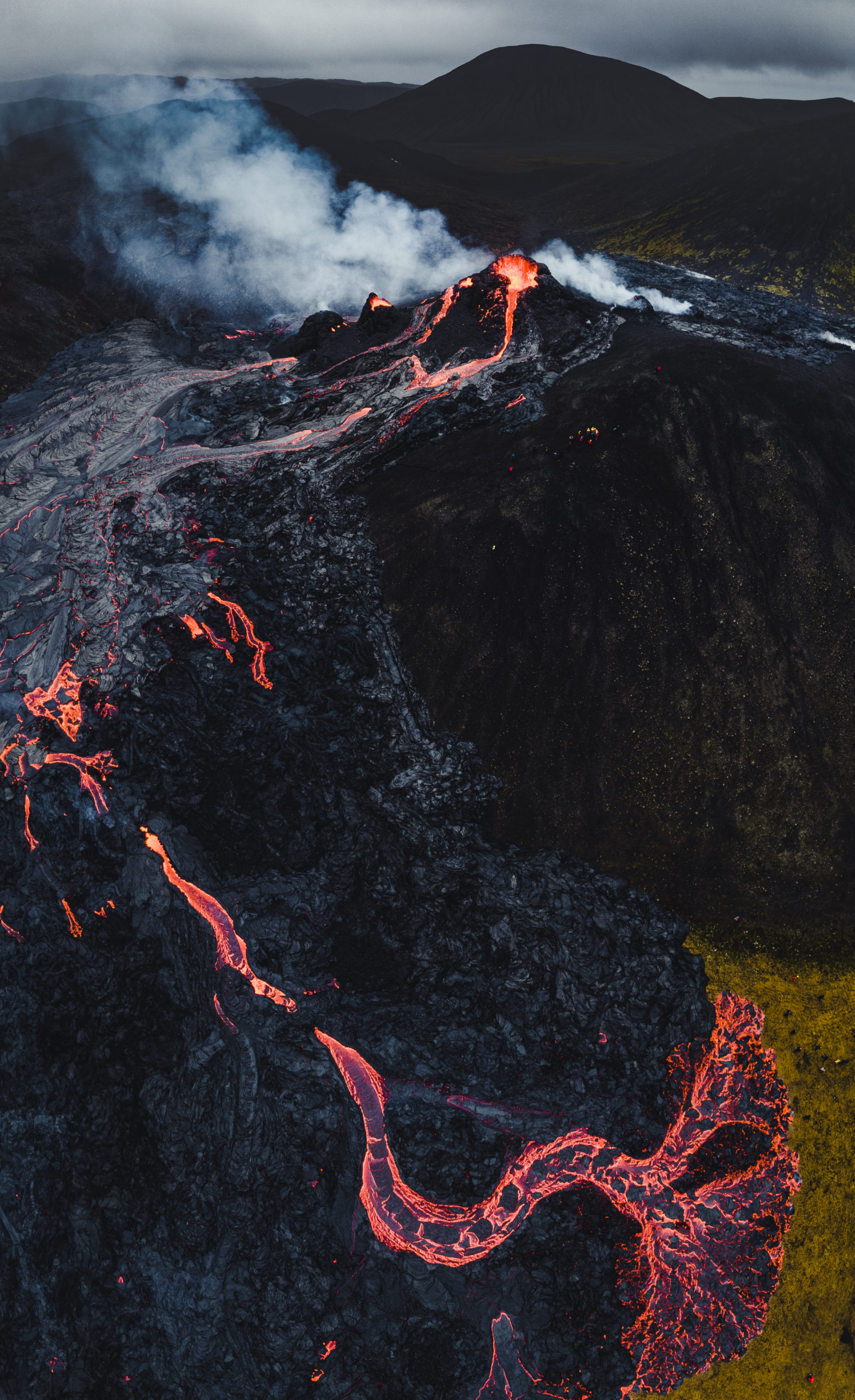
City residents have indeed noted an increase in helicopter traffic, many of which are solely flying sightseers over the lava. In contrast, other helicopters ferry members of the Coast Guard on official business, measuring and tracking the eruption’s development.
In a sense, it’s a little like the country has woken up after a long period of dormancy, alive with an unexpected jolt of energy and excitement.
Thankfully, this latest eruption is taking place in an uninhabited region of the country, so no evacuations have been necessary, nor is there any potential for structural damage. Funnily enough, Fagragdalsfjall is the first volcano to erupt in the Reykjanes Peninsula in over 700 years, making it far more accessible to onlookers than prior eruptions.
Residents of nearby settlements, such as those in the small fishing town of Grindavik, noted the sky turned blood-red upon the onset of the eruption, making for dramatic and valuable mementoes of the occasion.
Why does Iceland have volcanoes?
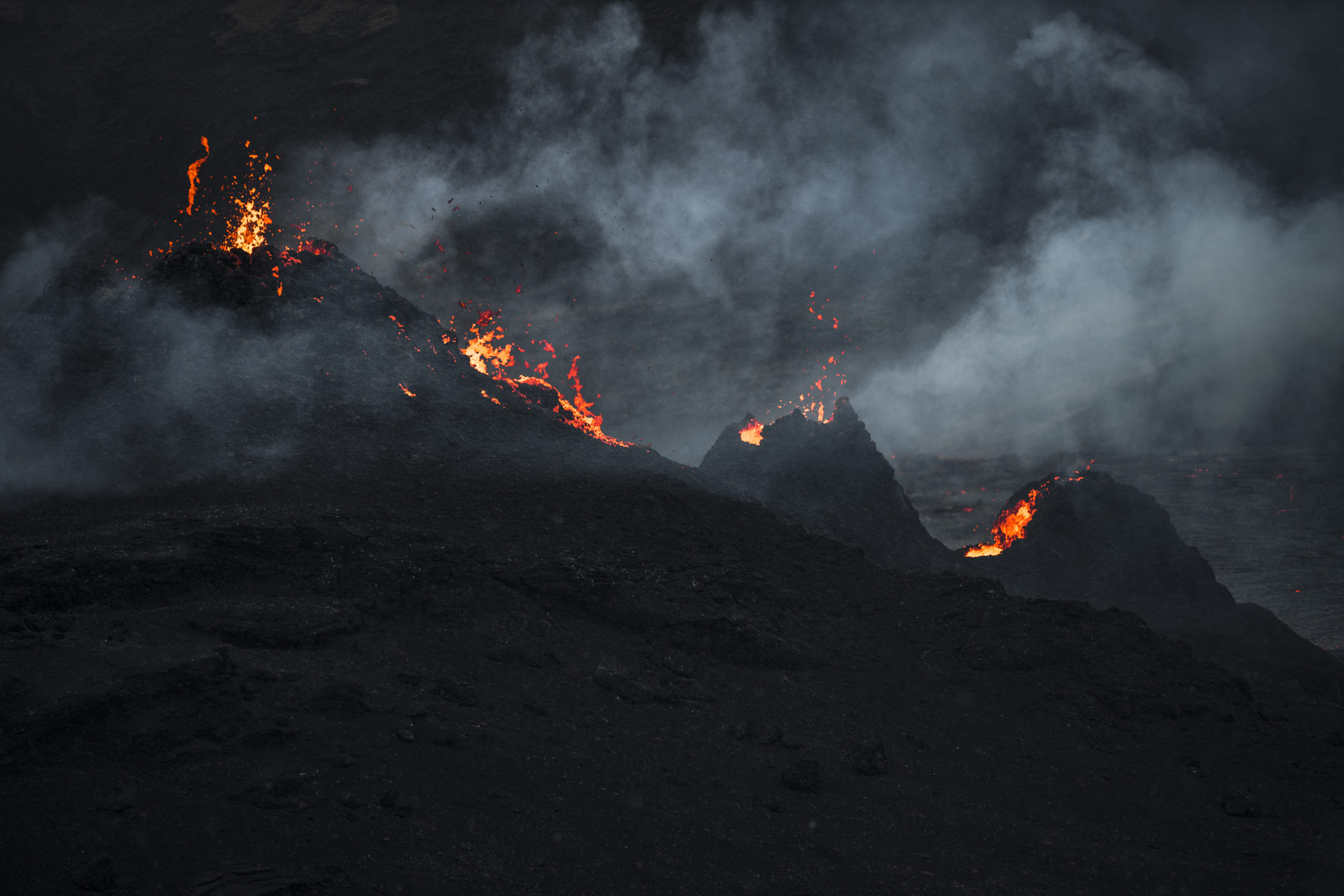
Volcanic eruptions in Iceland are nothing new, but in fact, a common phenomenon; a natural force still sculpting what is among the youngest geological countries on Earth.
At last count, the island has over 130 active volcanoes, all of which are remnants of a violent and fiery formation 60 million years ago. When speaking of the Iceland volcano for the purposes of this article, we are speaking of Fagragdalsfjall.
With Iceland having experienced numerous earthquakes over the last few weeks, many in the country were expecting a volcanic eruption. With that said, some scientists have confessed to having been taken by surprise given the earthquakes appeared to have been calming down.
Only a few weeks ago, officials revealed they believed the source of the earthquakes to be lava moving underground rather than tectonic plates pushing against one another. With the events currently unfurling on the Reykjanes Peninsula, it would appear their hypothesis has proved correct.
What other volcanic eruptions happened in Iceland?

Not all eruptions throughout Iceland’s history have been as safe or intriguing as the one currently occurring at Fagragdalsfjall.
For instance, the Laki eruptions of 1783 were devastating. In the years that followed, in a period known as the Móðuharðindin or “Mist Hardships”, over 25% of the local population succumbed to famine or noxious gases. The ash plume was so large it even altered the monsoon seasons of Asia and, arguably, was a contributing factor to the French Revolution.
In more recent times, Westman Islanders were forced to evacuate their homes on Heimaey on Eldfell volcano began erupting in 1973, and, of course, the infamously unpronounceable Eyjafjallajökull volcano made its voice heard after its gigantic ash cloud shut down European air travel back in 2011.
Nothing quite so dramatic will happen due to Fagragdalsfjall’s eruption. However, its timing is undoubtedly fortunate considering Iceland has only just now opened up its borders to travellers with a Covid-19 vaccination or certificate of antibody.
In many ways, the last few days focusing on the Iceland volcano are reminiscent of Eyjafjallajökull’s last eruption. This event almost single-handedly bred an intense interest among overseas visitors in this country and started what’s considered a golden age of tourism.
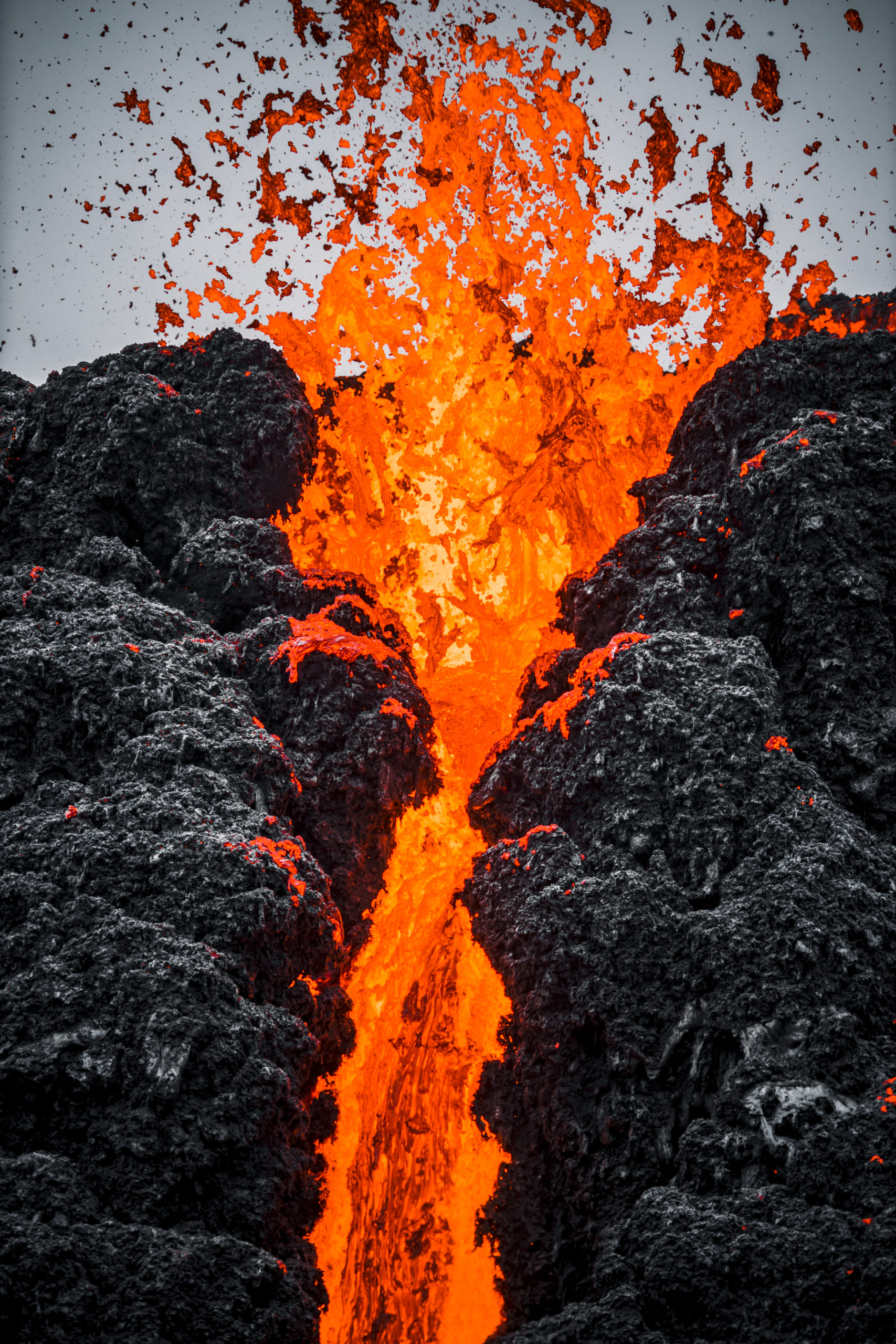
PLAN YOUR JOURNEY
Travelling to Iceland?
Check our overnight tours with a driver guide that includes a one night stay in a bubble.
*Starting from ISK 59.900 per person
Is Iceland open to travel? | New rules from March 2021
Is Iceland open to travel? | New rules from March 2021
By Michael Chapman
It's finally time to return to the Land of Ice and Fire!
Is Iceland open to travel? | New rules from March 2021
By Michael Chapman
It's finally time to return to the Land of Ice and Fire!
From March 18th 2021, any traveller with certified proof of a COVID-19 vaccination, or an antibody certificate showing prior infection, will be allowed entry into Iceland.
These policy changes are momentous news and brilliant timing for anyone in the US or UK planning a holiday to Iceland later this year.
After so many months spent isolating ourselves in our homes, the opportunity to travel is an exciting prospect indeed, and we are all too eager to welcome you back.
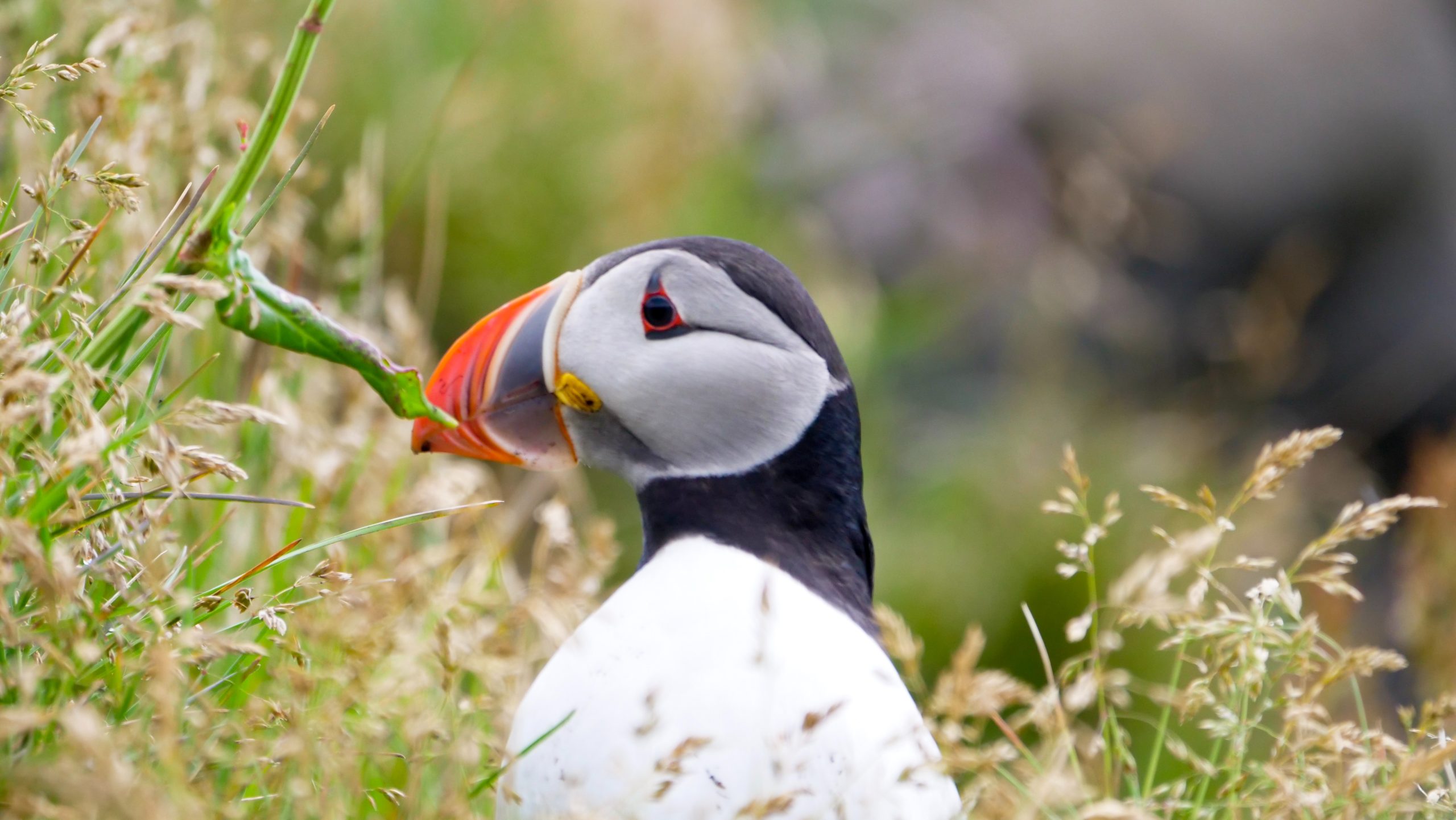
In that moment you finally set foot in Iceland, it’s hard to imagine a gentle wave of relief will not overcome you. The majesty of Iceland’s natural environment—its glittering waterfalls, volcanic beach heads, sweeping glacial plains and snow-capped mountains—all await to be discovered by any adventurer ready to unshackle themselves dithering about the home.
Time to pack your bags, ladies and gentlemen; unforgettable overseas holidays are on the cards once more, and we, for one, could not be more delighted!
Iceland opens its borders today
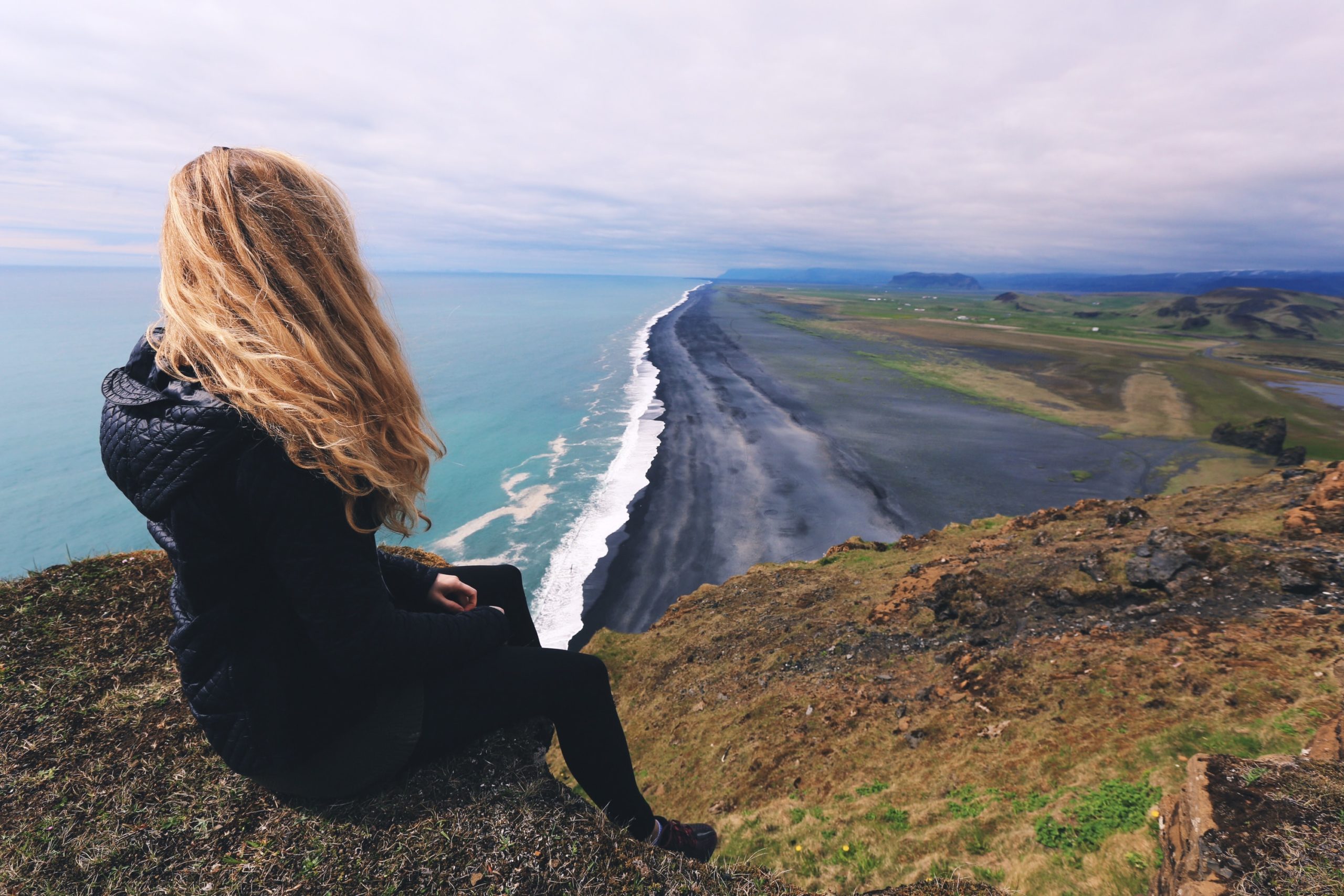
The Icelandic government, the Alþingi, announced plans this week to reverse the country’s closed border policy, a preventative measure put in place to curb the virus’s spread.
As of March 18th 2021, anyone who has had two doses of any vaccine approved by the EMA (European Medicines Agency) can enter the country without testing, signifying real promise among holiday-makers preparing future trips to the land of ice and fire.
The two most widely accepted vaccinations in the UK and EU are AstraZeneca and Pfizer. Currently, Icelandic officials are only counting certificates provided by either the EU or the World Health Organization as valid. Any traveller caught at the border attempting to pass-off a fraudulent certificate can face fines reaching 150,000 ISK.
Anyone unfortunate enough to have suffered through a COVID-19 infection in the past also has reason to rejoice. Overseas guests with certified proof of prior infection are allowed entry to the country without the need for a 5-day quarantine because previously infected people have antibodies in their system that prevent spreading the virus to others.
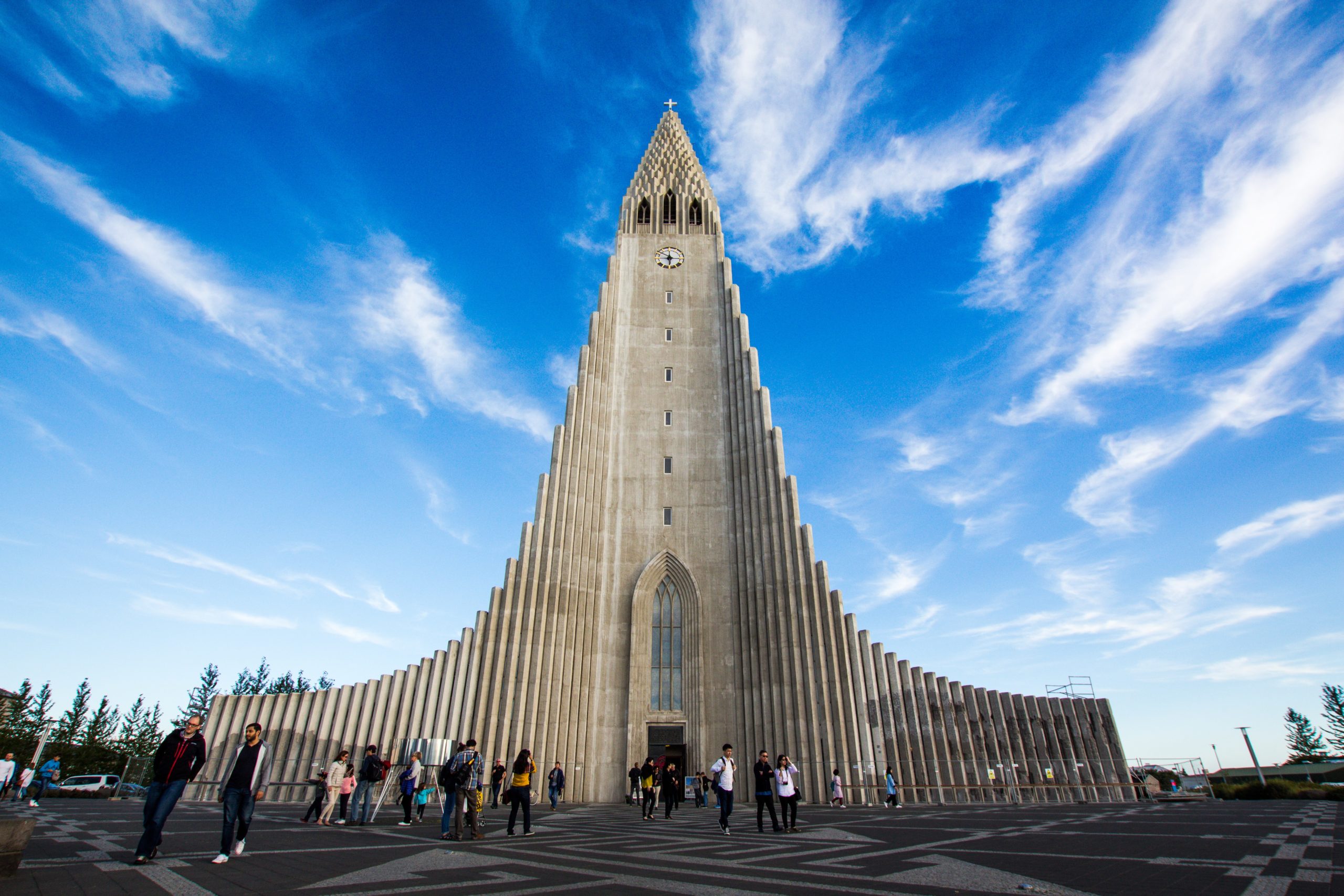
These changes show a decisive turnaround in the Alþingi’s thinking. After all, only a few weeks ago, the government considered neither a vaccination nor antibody certificate enough to allow entry into Iceland. This U-turn in policy allows for broader access to Iceland than before and is a sure sign the government considers now the time to re-evaluate the industry.
According to the Minister of Justice, Áslaug Arna Sigurbjörnsdóttir, the government decided to open the borders because Iceland has managed to keep its infection numbers low for a prolonged period. On top of that, the government has secured vaccinations for the majority of the domestic population.
In short, the coronavirus situation in Iceland is seen to be under control, and most people are optimistic that life will soon return to some semblance of normality.
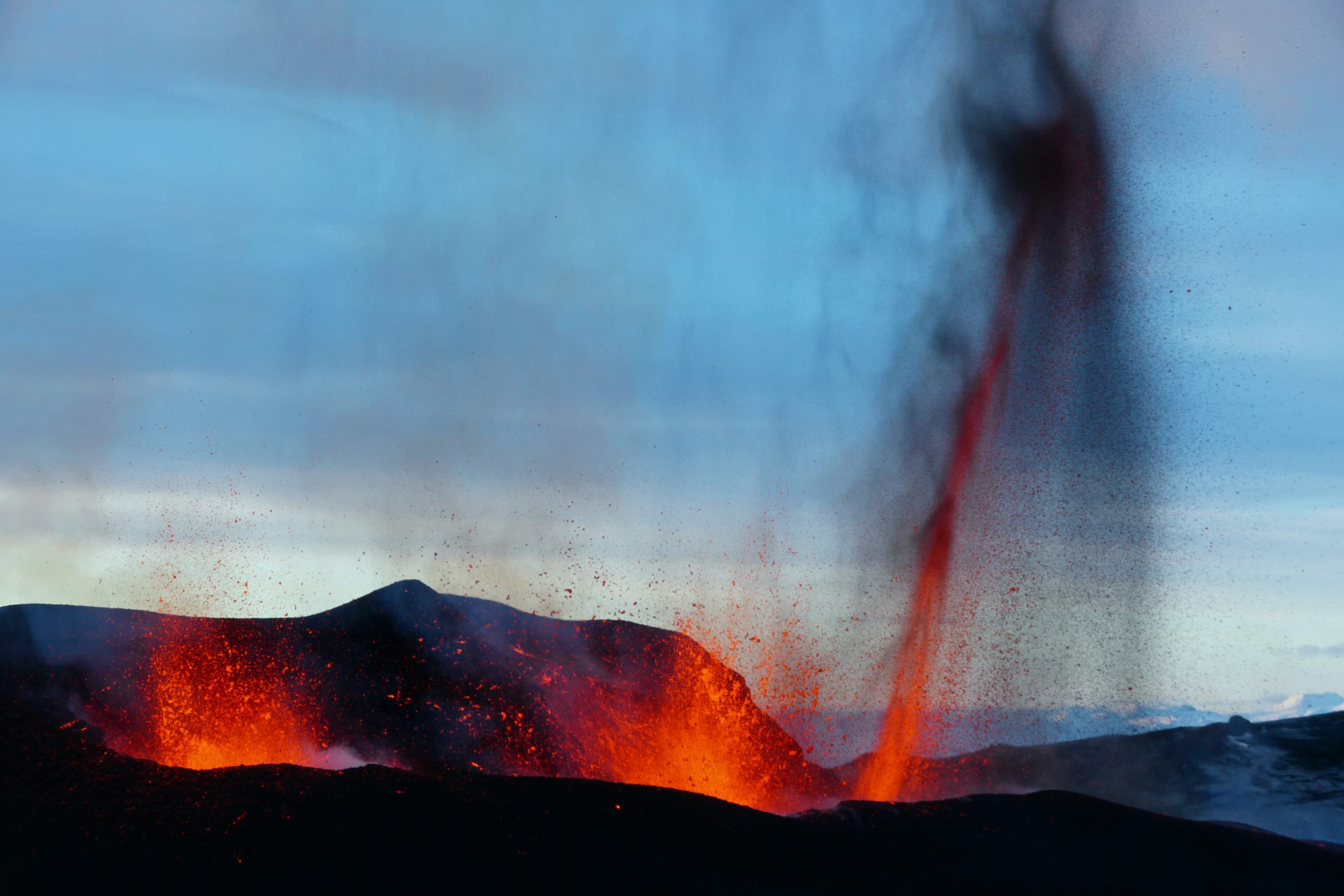
The Justice Minister also cited Iceland’s economic reliance on tourism as a contributing factor in the government’s choice, emphasising that allowing USA and UK travellers to enter the country will help mitigate the damage seen over the last year.
While some have perceived this response as falling to pressure from tourism companies, others have defended the industry, both its role as a vital contributor to Iceland’s economy and as a field in which tens of thousands of people are employed.
The Minister of Justice used Cyprus as an example of another island nation planning to open its borders within the coming months.
The USA and the UK are the two largest markets for the Icelandic tourism industry. Posing further challenges, UK travellers recently lost the right to travel to Iceland under the same regulations as the other 26 Schengen-area countries due to Brexit. Thankfully, it seems the UK’s exit from the European Union has had no impact so far on travelling between there and Iceland.
PLAN YOUR JOURNEY
Travelling to Iceland?
Check our overnight tours with a driver guide that includes a one night stay in a bubble.
*Starting from ISK 59.900 per person
What if I don't have a vaccination certificate?
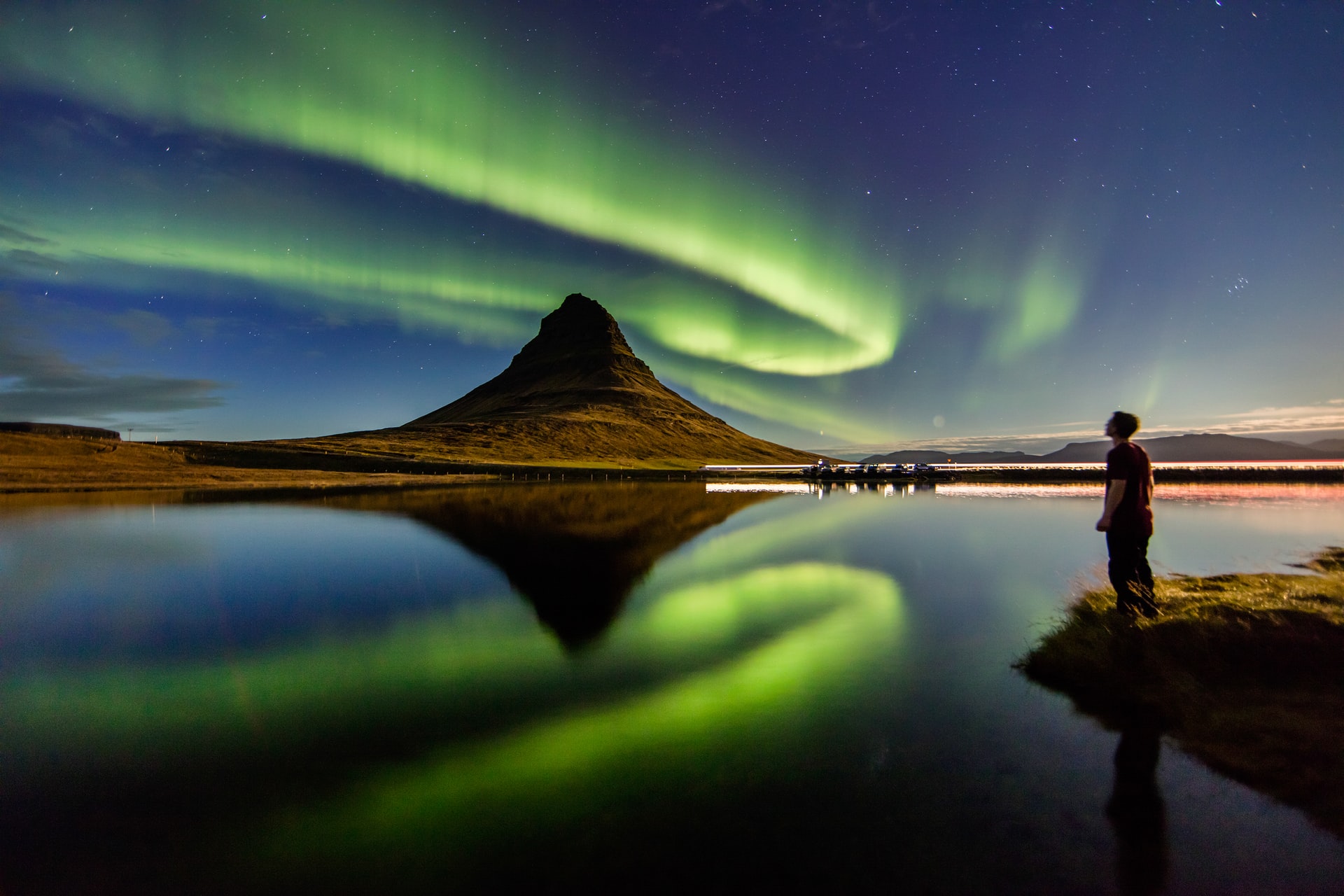
Suppose you do not have a certificate proving your vaccination. In that case, you may still be allowed entry into Iceland as long as you show proof of a negative PCR test—taken within the last 72 hours—and promise to adhere to the testing and quarantine rules in place. PCR stands for polymerase chain reaction, a medical test that amplifies DNA strands and allows scientists to detect the presence of genetic material from certain organisms, such as a virus.
So, as it stands, anyone with a valid EU/EFTA passport is welcome to travel to Iceland, so long as they complete the mandated tests and quarantine period. Note that Canadian and American travellers still require proof of vaccination or prior infection to enter the country. Hopefully, this policy will shift soon, and we will be sure to inform you when any changes occur.
Two tests must occur for those who arrive in Iceland without certificates of proof: the first at the border, and the second at a clinic, taken after a 5-day quarantine. The location of your nearest testing facility will be sent to you by text message and over the government’s companion COVID-19 mobile application, Rakning C-19. You can read more information about testing and quarantine rules at both covid.is and government.is.
Are there other changes being made related to COVID-19 in Iceland?
Despite the changes made, Iceland’s Chief Epidemiologist, Dr Þórólfur Guðnason, has urged that people remain vigilant. Despite the country’s successes in keeping the virus restrained, it appears the government is still watchful of the situation and no doubt have fears of any third-wave that might occur following opening the borders.
If the situation deteriorates—which is not expected, understand—it is clear the Alþingi will likely shut down the borders once more.
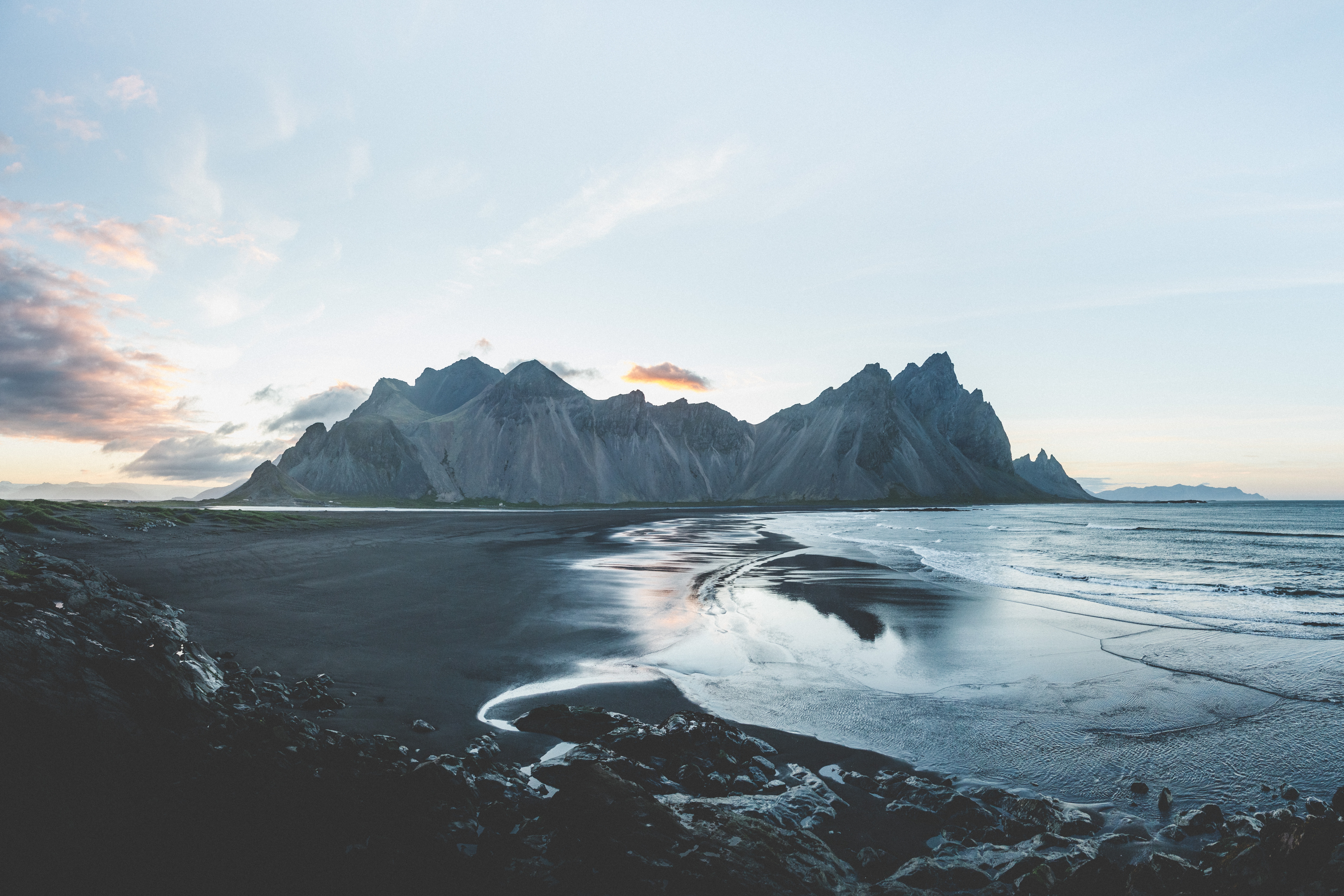
Here at home, restrictions on gatherings will remain essentially unchanged, save for a handful of minor measures. For instance, guests must register to participate in events, drinks will no longer be served during intervals at events or competitions, and there is no mixing of people between restricted areas.
While these rules are of little consequence to overseas travellers, it is essential to realise that Iceland’s borders opening up does not mean the fight against the virus is over.
We still advise you to wash your hands routinely and wear masks when shopping or entering public spaces in Iceland. If we behave with respect towards others and ourselves, then there is a fantastic chance this country will have bested the coronavirus for the long-term, meaning you and millions of others are free to explore this island for many years to come.
So when are you planning on visiting us?
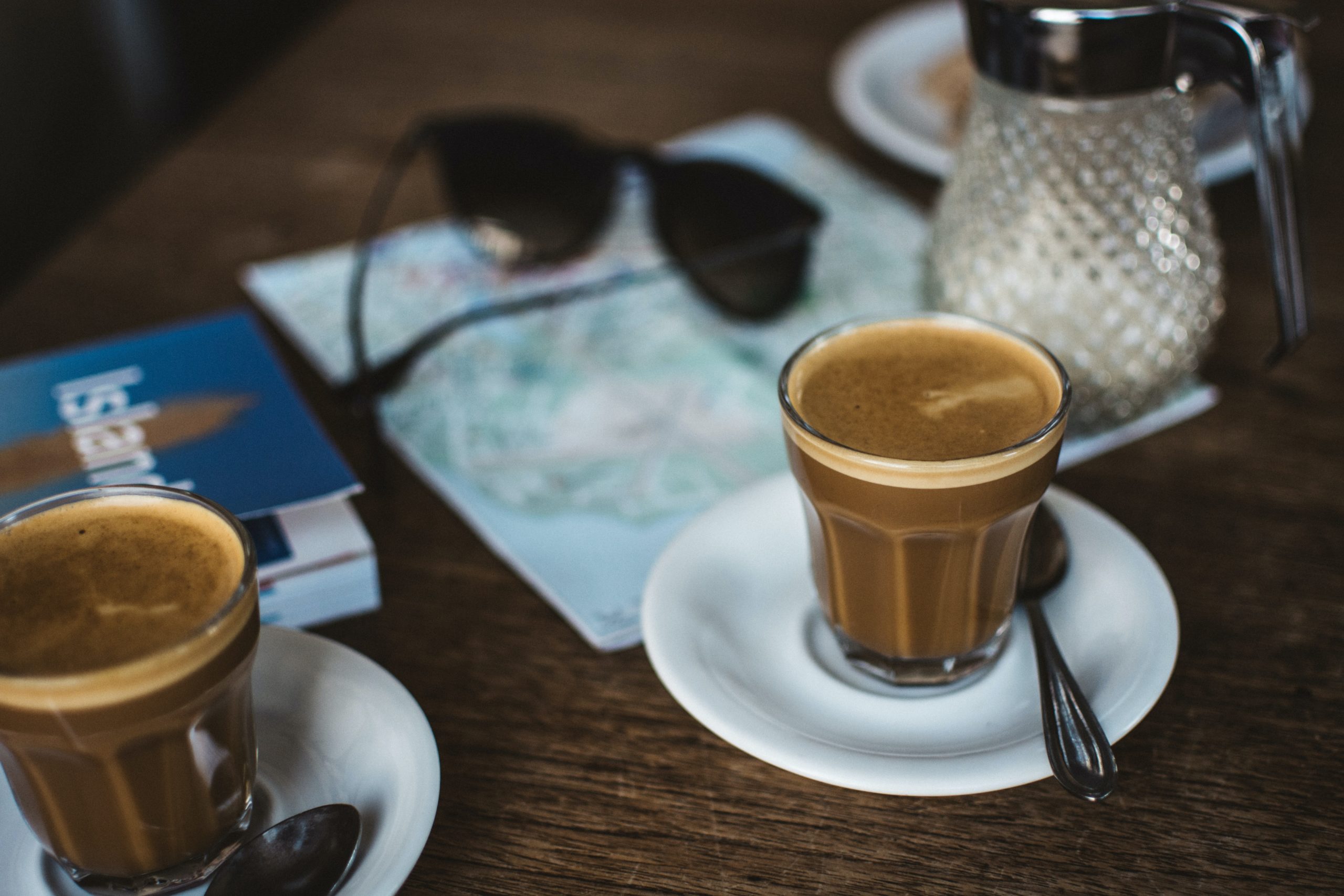
With open borders to Iceland now a reality, there is only one question left for those with the certificates allowing entry—
When do you plan on arriving in Iceland? Whatever month, or months, you settle on, know that each season offers its distinct advantages.
The summer, May to August, allows for 24 hours of daylight courtesy of the Midnight Sun—plenty of time to pack as many sites and activities into your day as you can.
On the other hand, the winter offers guests the chance to see the ethereal Northern Lights, as well as a vast and eclectic landscape blanketed in a mesmerising coat of white.
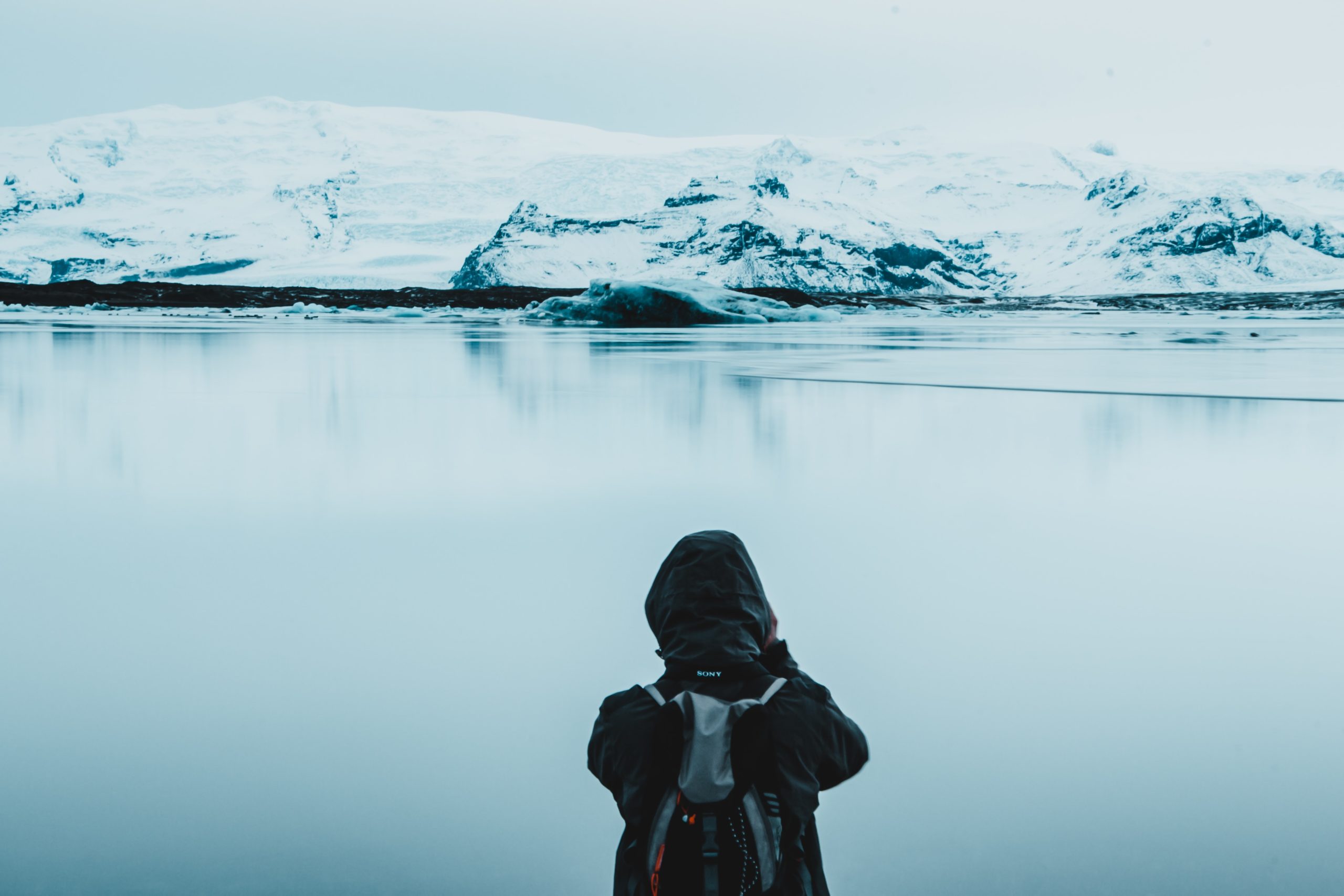
Despite the fear, stress and restrictions the coronavirus imposed across the world these last months, Iceland remains a country of staggering natural beauty, a secluded, sub-arctic oasis that makes for the perfect spot to escape, repair and revitalise.
With that in mind, it’s easy to understand why this country is among the top destinations people hope to travel to in 2021.
We at Bubble are delighted to welcome guests back to our gorgeous home country, and we cannot wait to return sharing all the fantastic sights and experiences that have long made Iceland one of the top tourism destinations in the world.
Update as of 23rd March 2021: The above article lays out the entry rules currently stipulated by the Icelandic government, and thus does not apply to those whose own home countries have forbidden travel. Currently, the UK is imposing fines to anyone taking foreign holidays.
PLAN YOUR JOURNEY
Travelling to Iceland?
Check our overnight tours with a driver guide that includes a one night stay in a bubble.
*Starting from ISK 59.900 per person
7 Amazing Reasons to Stay in a Bubble in Iceland
7 Reasons to Stay in a Bubble in Iceland
By Michael Chapman
Find out why our bubbles make the perfect choice for your stay!
7 Reasons to Stay in a Bubble in Iceland
By Michael Chapman
Find out why our bubbles make the perfect choice for your stay!
There are countless reasons why staying overnight in a transparent bubble in Iceland should be top among your priorities in 2021. For one thing, we always ensure visiting our accommodation is an exciting experience in itself, counting it as being among the top highlights of your Iceland adventure.
Second, the last twelve months have been exhausting for a litany of unpleasant reasons, the coronavirus’ incursion into society being chief among them. Don’t you think you deserve an actual break for making it through these months with your sanity intact? Isn’t it time you find a personal oasis in which to relax and escape from the madness of the outside world?
Now we are coming to an end to the gruelling ordeal that has been the COVID-19 pandemic; the question of when we will all be able to travel again is at the forefront of everyone’s mind. With vaccinations being rolled out in multiple countries worldwide, it is difficult not to be cautiously optimistic looking forward.
In fact, now, it seems, is the perfect opportunity to start planning that memorable trip you’ve spent the last year only fantasising about. With that in mind, we have picked out below the top 7 reasons why we believe a bubble in Iceland is the perfect fit for you.
7. Connect with the natural environment
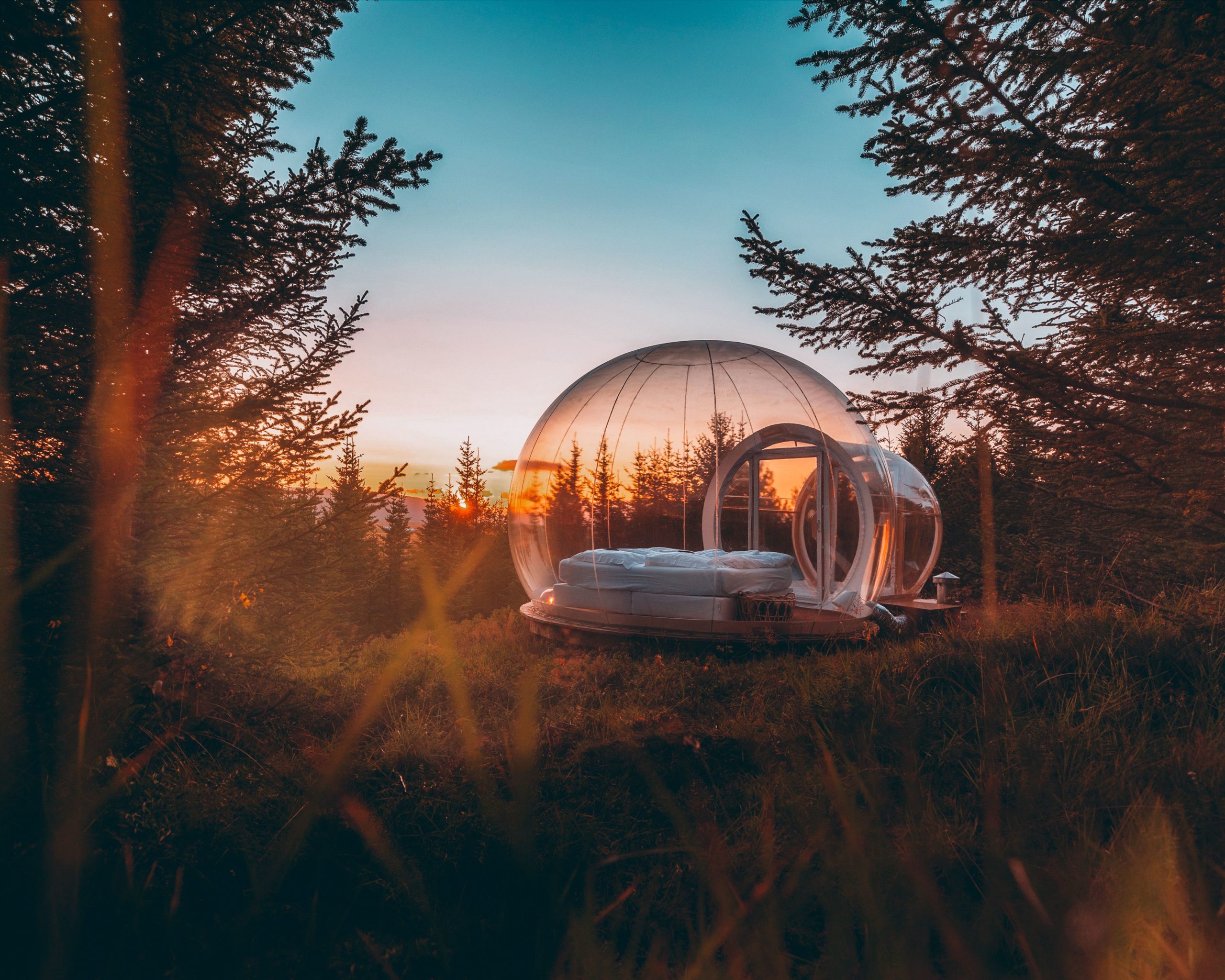
Icelandic nature is renowned worldwide for its beauty, drama and diversity. The island’s landscape covers everything from black sand deserts and beaches to sweeping glacial plains, mountain ranges and luscious green hillsides.
Built of fire-retardant PVC, our bubbles are situated deep in the South Iceland countryside, lovingly positioned to maximise one’s immersion in the surroundings. Our bubbles are found in two locations, though these are not revealed until just before your trip to keep the element of surprise intact.
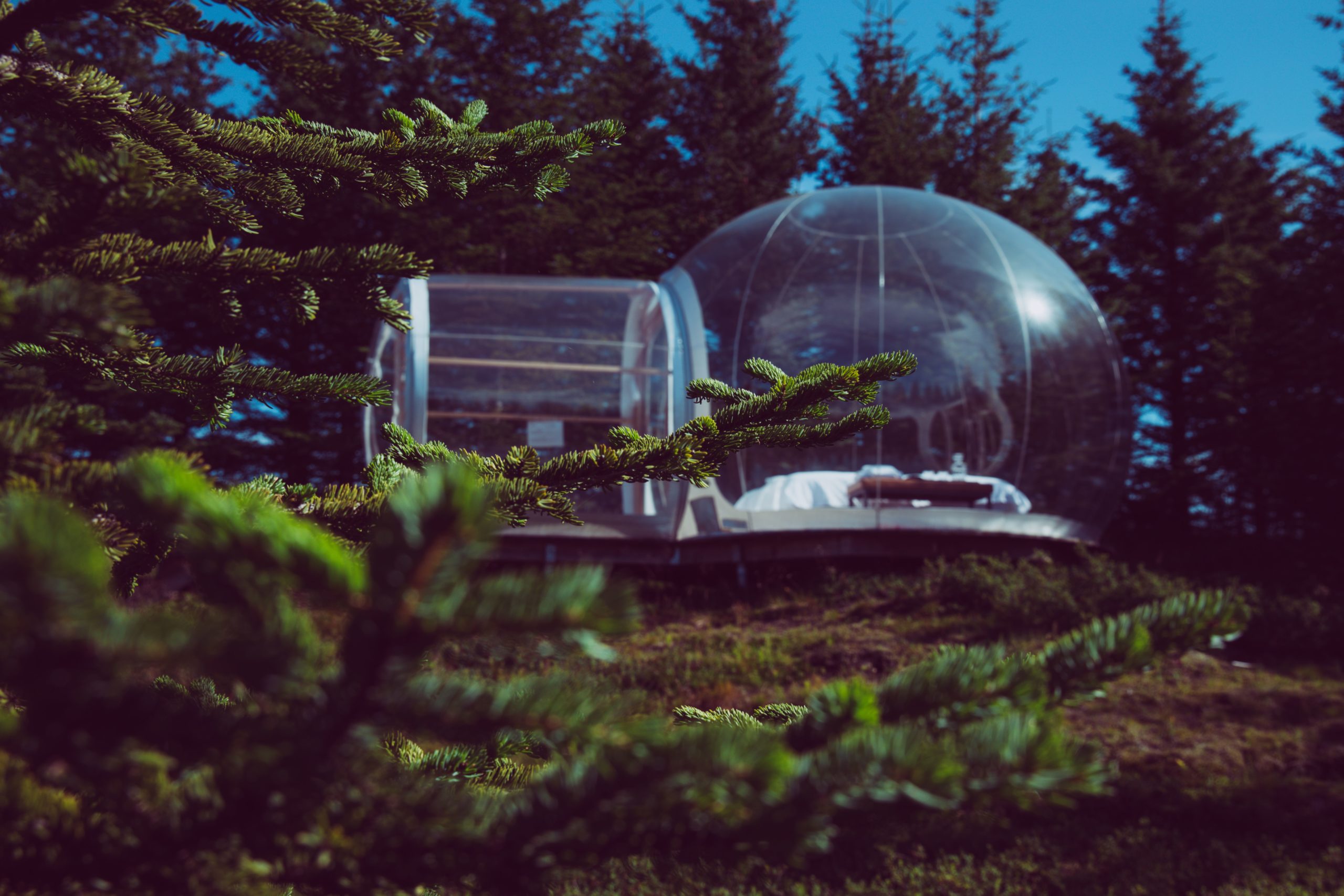
Whichever location you wind up staying in, you will discover a bubble surrounded by dense woodlands, with views that stretch out over the grassy meadows and glittering brooks that so characterise this region of the country.
A bubble in Iceland also makes for the perfect spot to curl up and read a book, meditate, or share intimate conversations with your loved one. All the while, the gentle rush of the wind passing over the spherical build of the bubble, plus the sound of birdsong and gently babbling brooks, will help keep you at ease throughout your stay.
6. Experience the Northern Lights above!
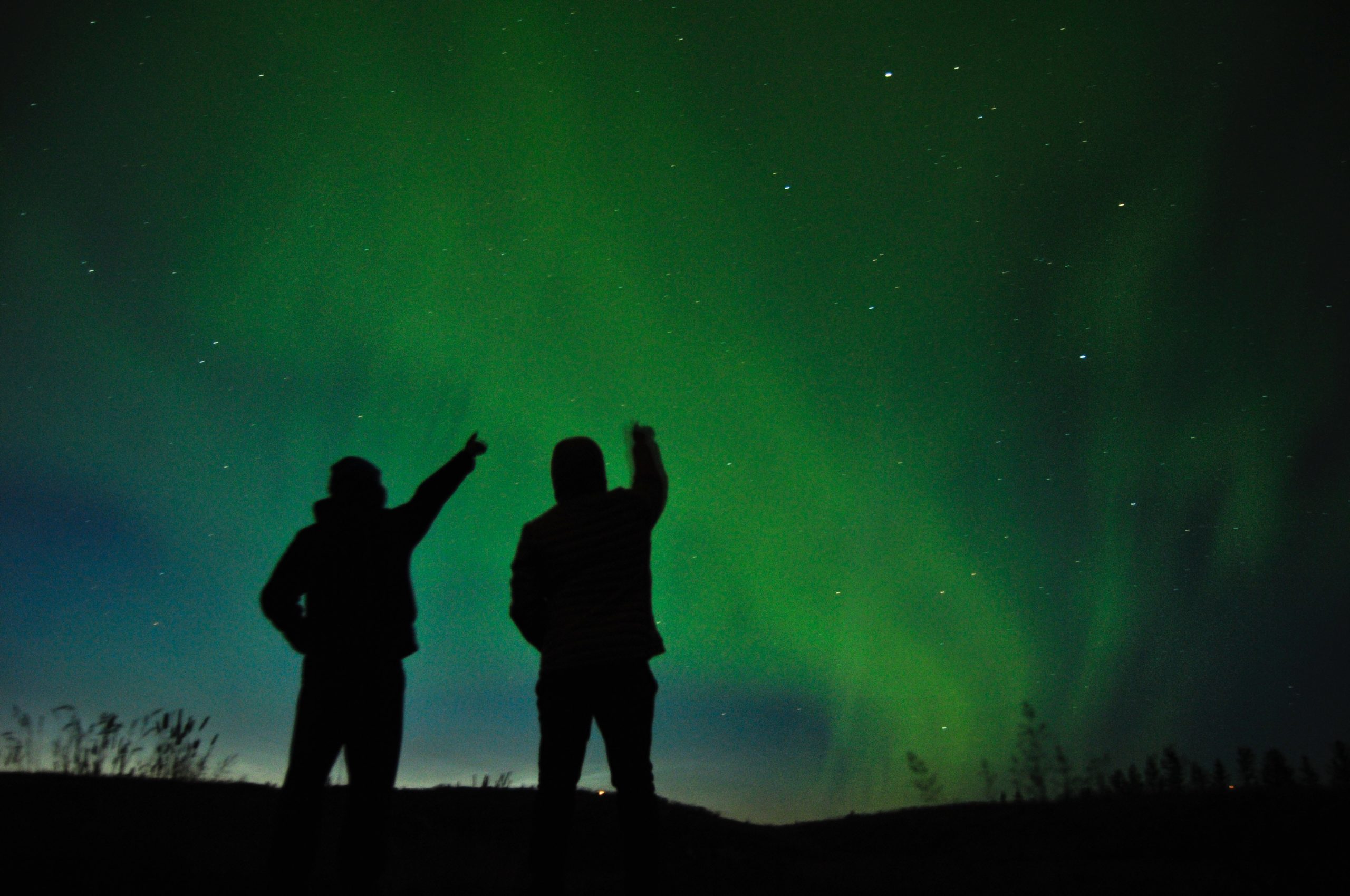
Beautiful, ethereal and unlike anything else on the planet, the Northern Lights are among Iceland’s most exciting naturally-occurring phenomena. On dark winter nights, the sky is more than capable of coming alive with colour and energy; dazzling ribbons of green that wave and flaunter as if conscious, inspiring all who see them.
One of the great benefits of observing the Northern Lights from a bubble in Iceland is that you do away with the cold outdoor temperature, not mentioning the winds, rain and snow that comes with it. The shelter allows for a more comfortable, private and prolonged time with the auroras, allowing you plenty of time to watch them dance, shift and change colour throughout the night.
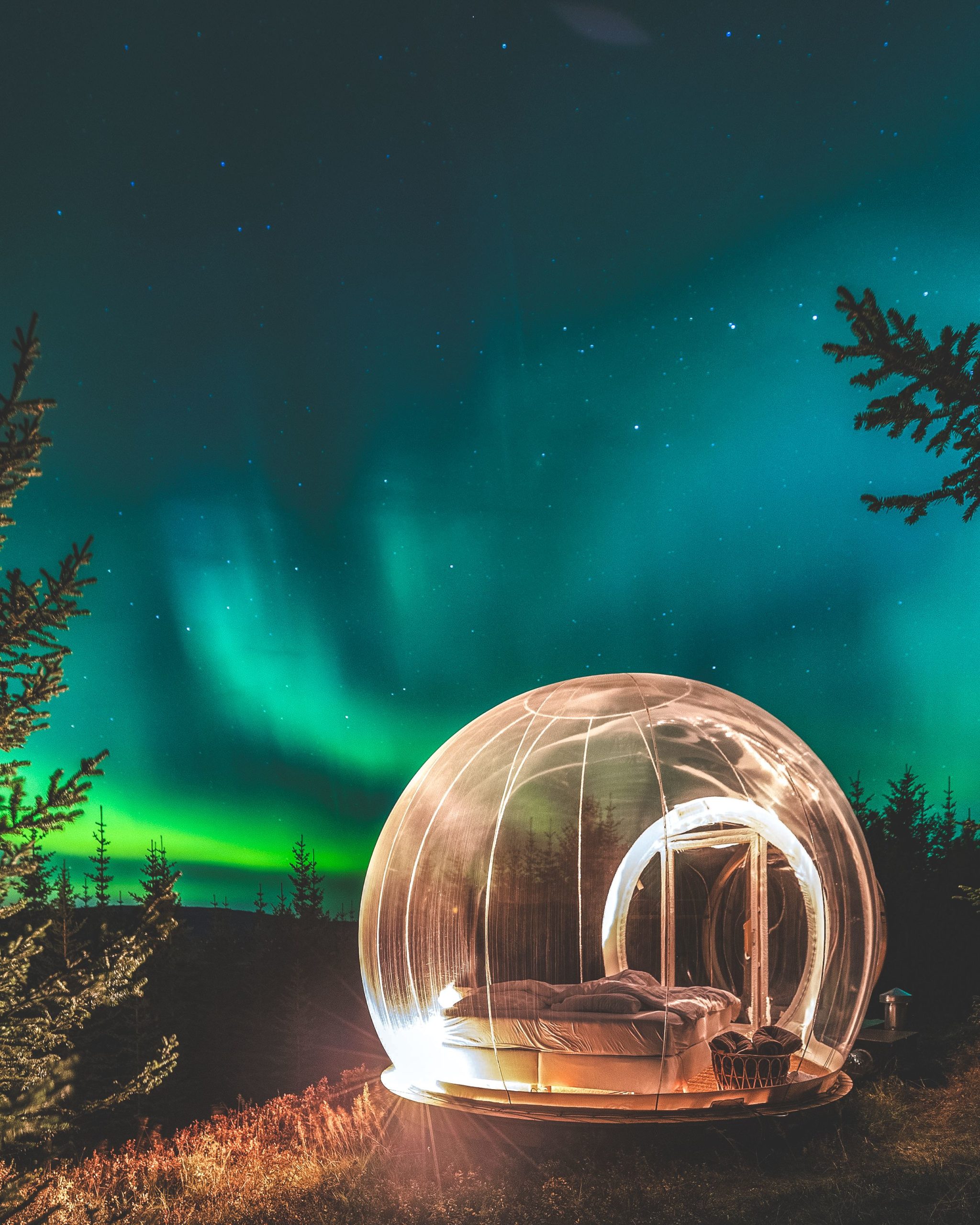
The Northern Lights are notoriously unpredictable, so there is no guaranteeing they will appear, even if the conditions and forecast are optimistic. In such cases, you’ll likely be left with a stunning black sky twinkling with countless interstellar bodies. For what other reason could they refer to our bubbles as the 5-Million Star Hotel?
Witnessing the Northern Lights is only available to winter visitors in Iceland, but guests arriving in summer should not fear missing out. After all, Iceland offers unique discoveries regardless of the season; such is the magic and nature of this place.
In place of the auroras arrives the Midnight Sun, illuminating the land for up to 24 hours a day. From inside your bubble, you will have clear views of a land in blossom, complete with purple lupin flowers, blue skies and rolling green hillsides.
PLAN YOUR JOURNEY
Travelling to Iceland?
Check our overnight tours with a driver guide that includes a one night stay in a bubble.
*Starting from ISK 59.900 per person
Surprise your partner with a romantic overnight in a bubble in Iceland
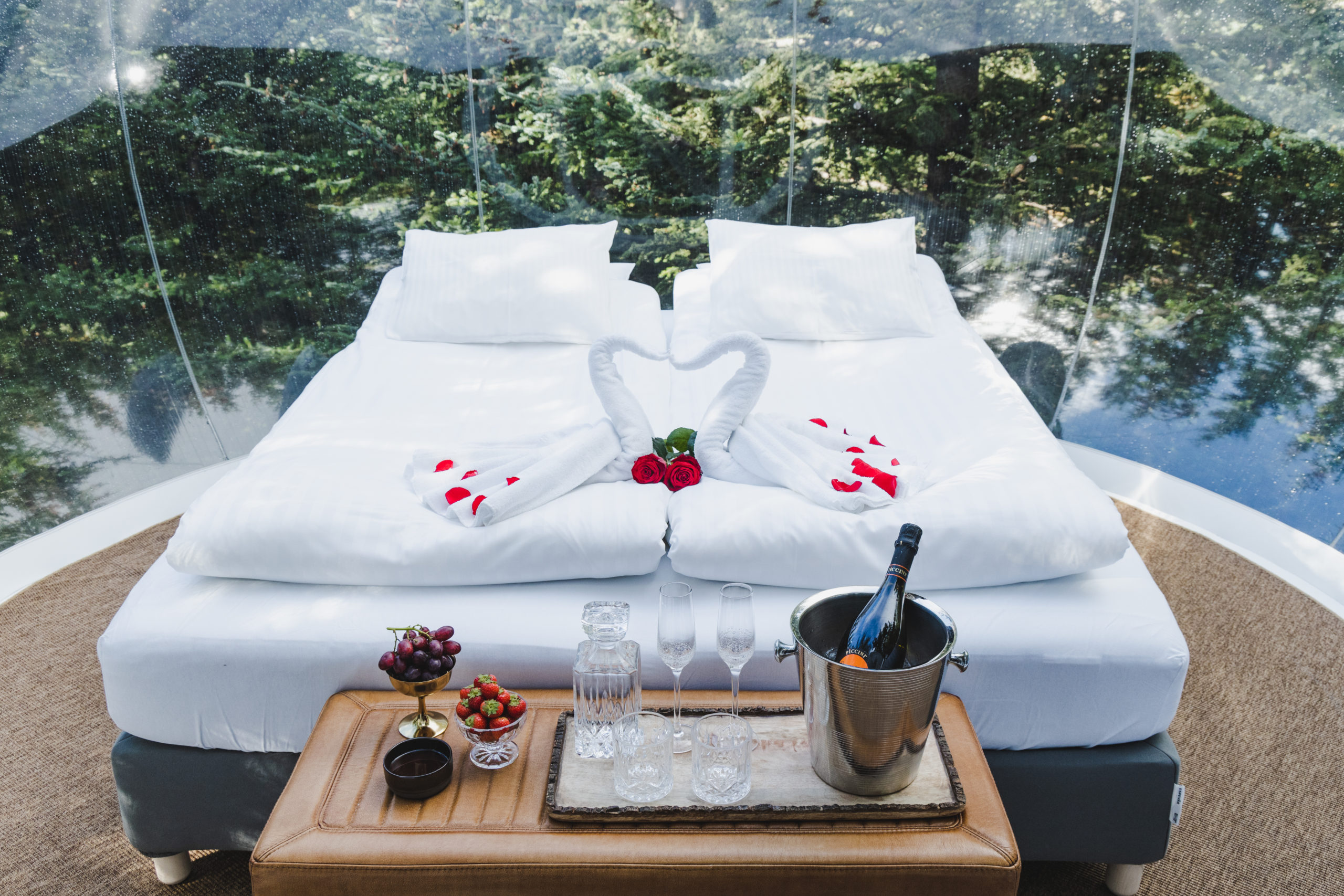
If cupid’s dealt you a fortunate hand, you won’t have such a contentious relationship with that special someone in your life as you with your social media chums; thus, it is considered normal and, in many cases, mandatory to dote upon them with lavish gifts.
Thankfully, staying overnight in one of our South Iceland bubbles is about as luxurious and thoughtful a present one could imagine, providing you with a cosily intimate evening spent beneath a blanket of starlight. Laying arm in arm with one another, you’ll fall asleep to your very own cosmos, the perfect send-off to a day spent touring South Iceland together.
Despite what the shopping channel tells you, it is shared experiences, rather than a mass of material possessions, that have the most value in life. Memories of time spent together help you remain bonded to one another and often elevate a relationship to new heights.
Anyone debating when and where to pop the question would do well to keep one of our overnight bubble stays in mind. With such sublime surroundings at your disposal, there is little doubt wedding bells are a sure bet in the future.
4. Impress your friends on social media!
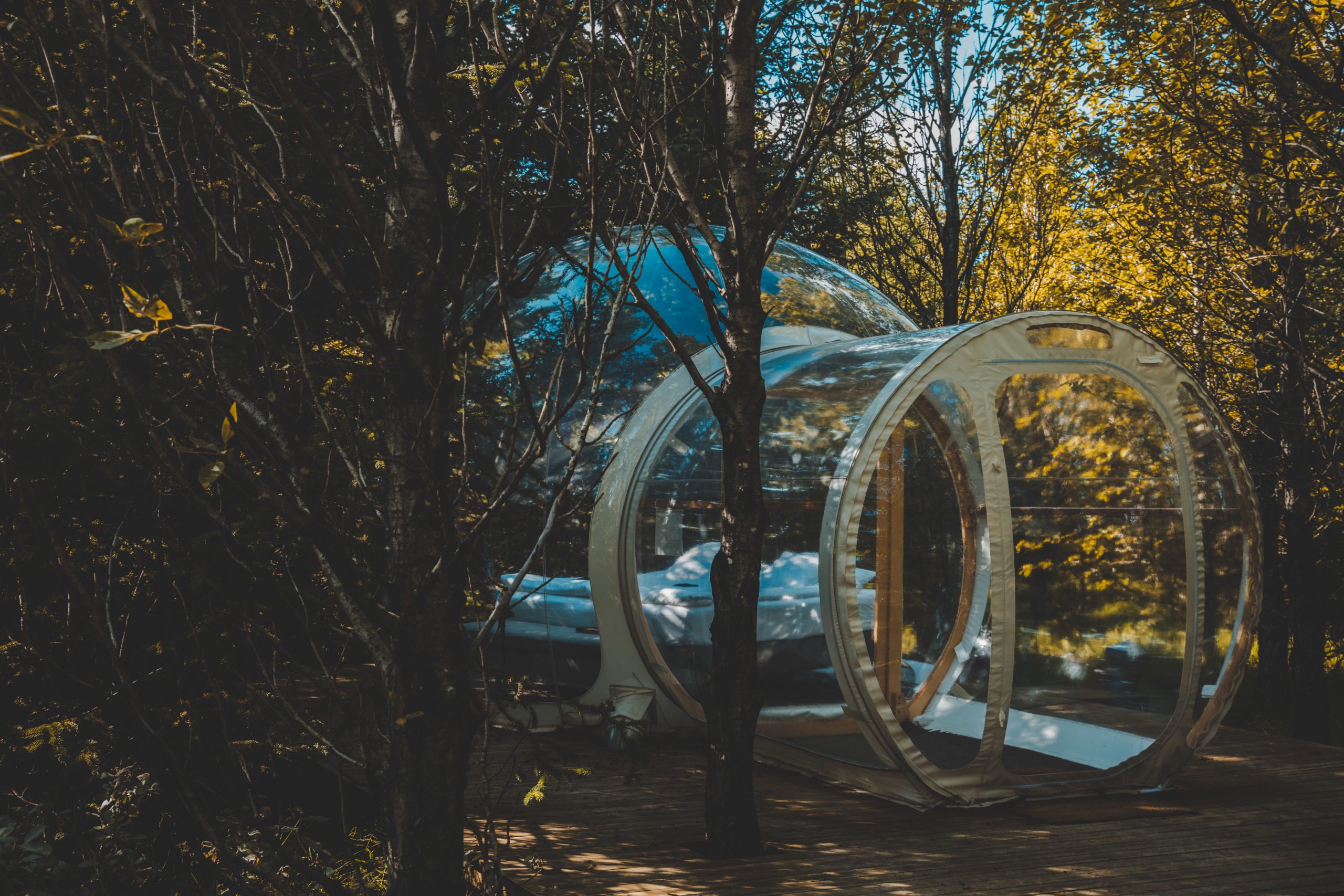
Travel is beneficial for many things; broadening the mind, witnessing new sights, meeting new people, sampling unheard-of delicacies, and learning something about oneself that you could have never uncovered otherwise.
Of course, travel is also great for making your pals seethe with jealousy, which, as we all know, is the bedrock of any healthy friendship.
Sure, Lindsay from your university days might now be running a fashion line in Madrid, and perhaps Tom from work does have as many cars as his Facebook status suggests. In the end, you’ll find yourself unimpressed with them boasting of their accomplishments and will readily enjoy an opportunity to, as they say, burst their bubble.
Well, wouldn’t you know that our bubbles are perfect for instilling envy in others? Not only do they look good splashed across social media, but YOU look good in them.
Famous faces have quickly cottoned onto this reality, having shared their own experiences of staying in our transparent bubbles. Renowned for her humour and leading roles in Ugly Betty and Superstore, America Ferrera posted her time in the bubble on Instagram, as did ……
3. Enjoy an authentic Icelandic experience
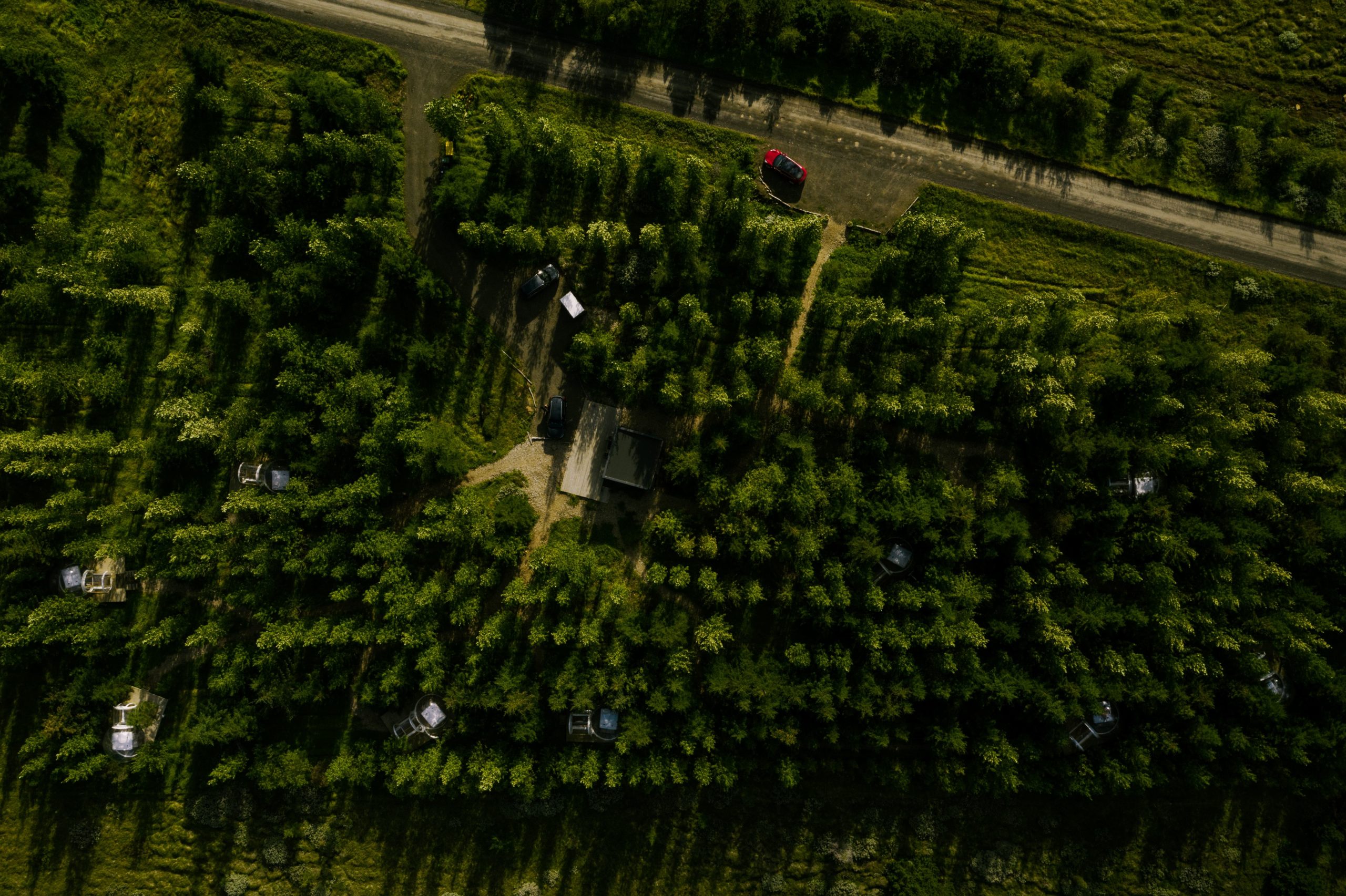
Transparent bubbles are the epitome of novel accommodation, and we are proud to be the only team in Iceland offering such an experience to overseas visitors. This exclusivity allows your time in Iceland to rise beyond the typical, trading in the same-old hotel room, the same traditional guesthouses and hostels, for something completely different.
Each bubble in Iceland operates under a state-of-the-art ventilation system, renewing the air inside up to seven times within a single hour. Not only does this prevent humidity and condensation on the walls, but it also keeps the bubble interior feeling fresh and comfortable. On top of that, we offer heating throughout the year, ensuring your stay is warm regardless of the season.
Our bubbles are within close proximity to several of Iceland’s most popular visitor attractions, epic sites of natural splendour that can’t help but draw an eager crowd with the spectacles on display there.
The Golden Circle sightseeing route is particularly renowned for astounding guests with the beauty of its three main sites; Thingvellir National Park, Gullfoss waterfall and Geysir geothermal area. Thingvellir is a UNESCO World Heritage site known for being the birthplace of the Icelandic nation and where the American and Eurasian continental plates diverge.
While guests should prioritise these attractions above all else, there are countless other interesting diversions en route. Kerid volcanic crater, for instance, makes for a worthy stop, as does Laugarvatn Fontana spa and Fridheimar tomato farm.
2. Help Iceland's environment
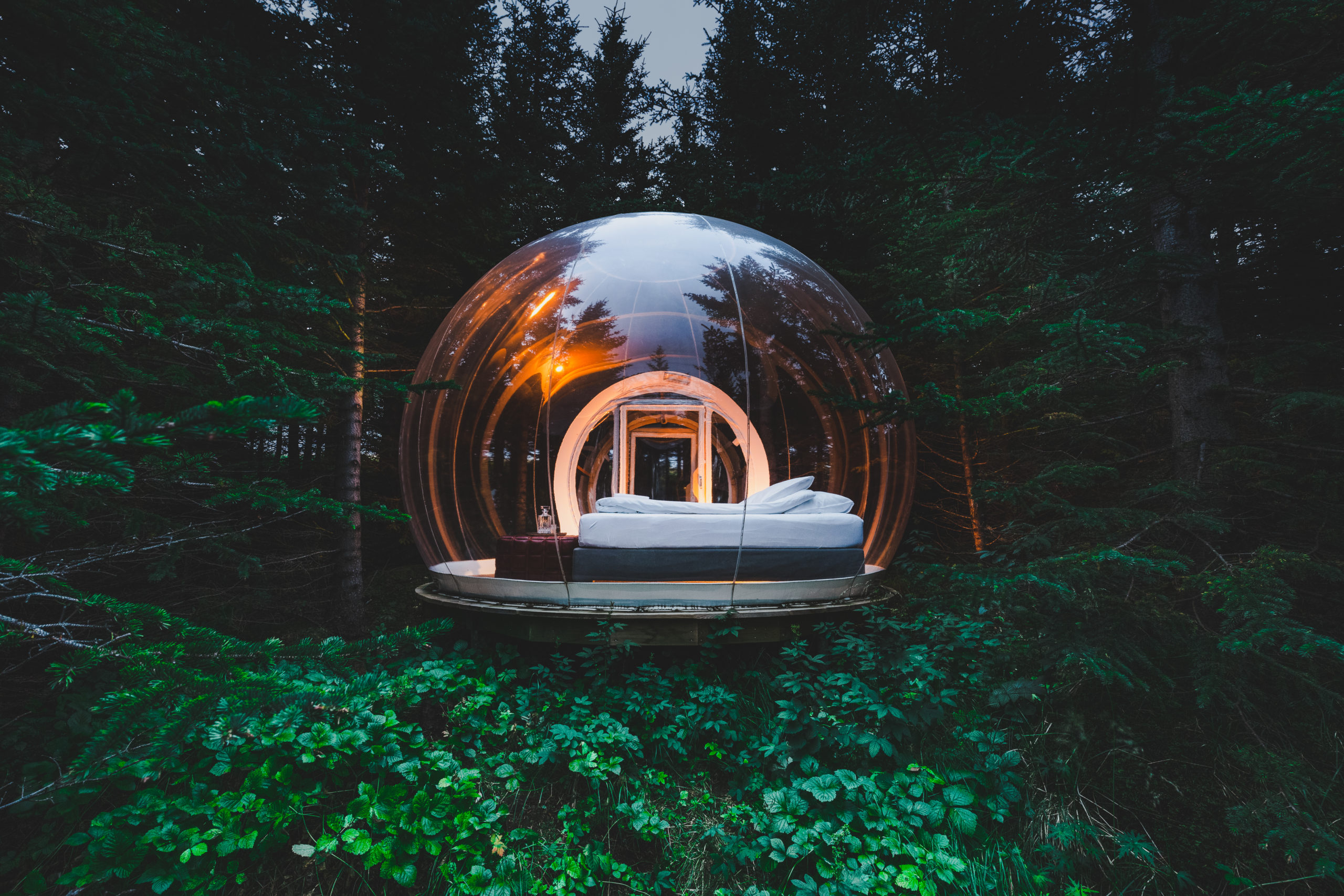
Leave behind the lights, pedestrians and traffic of Iceland’s capital, Reykjavik, and instead, trade it in for the tranquillity and serenity of the countryside by staying in a bubble in Iceland. Doing so will not allow for a deeper, more meaningful connection to the environment but will actively contribute to sustainable tourism practises in the country.
Another benefit of staying in a South Iceland bubble is that you will witness this country’s reforestation efforts firsthand. It is a commonly known fact that Iceland’s earliest settlers stripped this land of its trees in a little over 100 years, using the natural resources they found for heating and to build homes and ships.
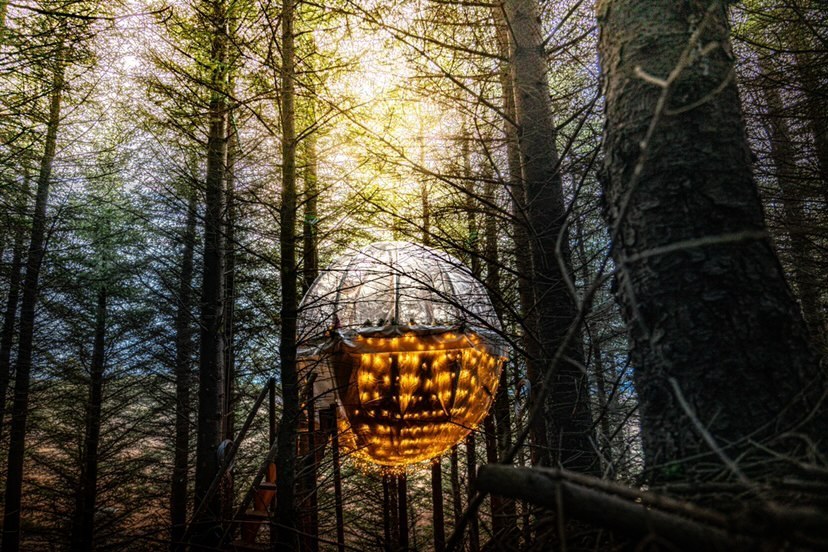
What they left behind was a beautiful yet largely empty landscape of wind-buffeted, infertile soil. Such a legacy is somewhat strange considering how gorgeous and unique most people consider Iceland’s wilderness, yet what they are appreciating is a land transformed forever by human hand.
Since the early 20th century, Icelanders have made efforts to restore the forests that once covered this land. While reforestation is still very much a work in progress, there are clear signs of growth, and our bubbles are among the best places to see it.
We are the only company that uses Tesla electric vehicles on Golden Circle tours, offering far-less harmful means of travelling from one site to another. Able to comfortably fit up to six passengers, you’ll feel more than safe knowing these are the exact same vehicles used to transport the US President (minus the bullet-proof glass).
1. Fulfill a childhood dream!
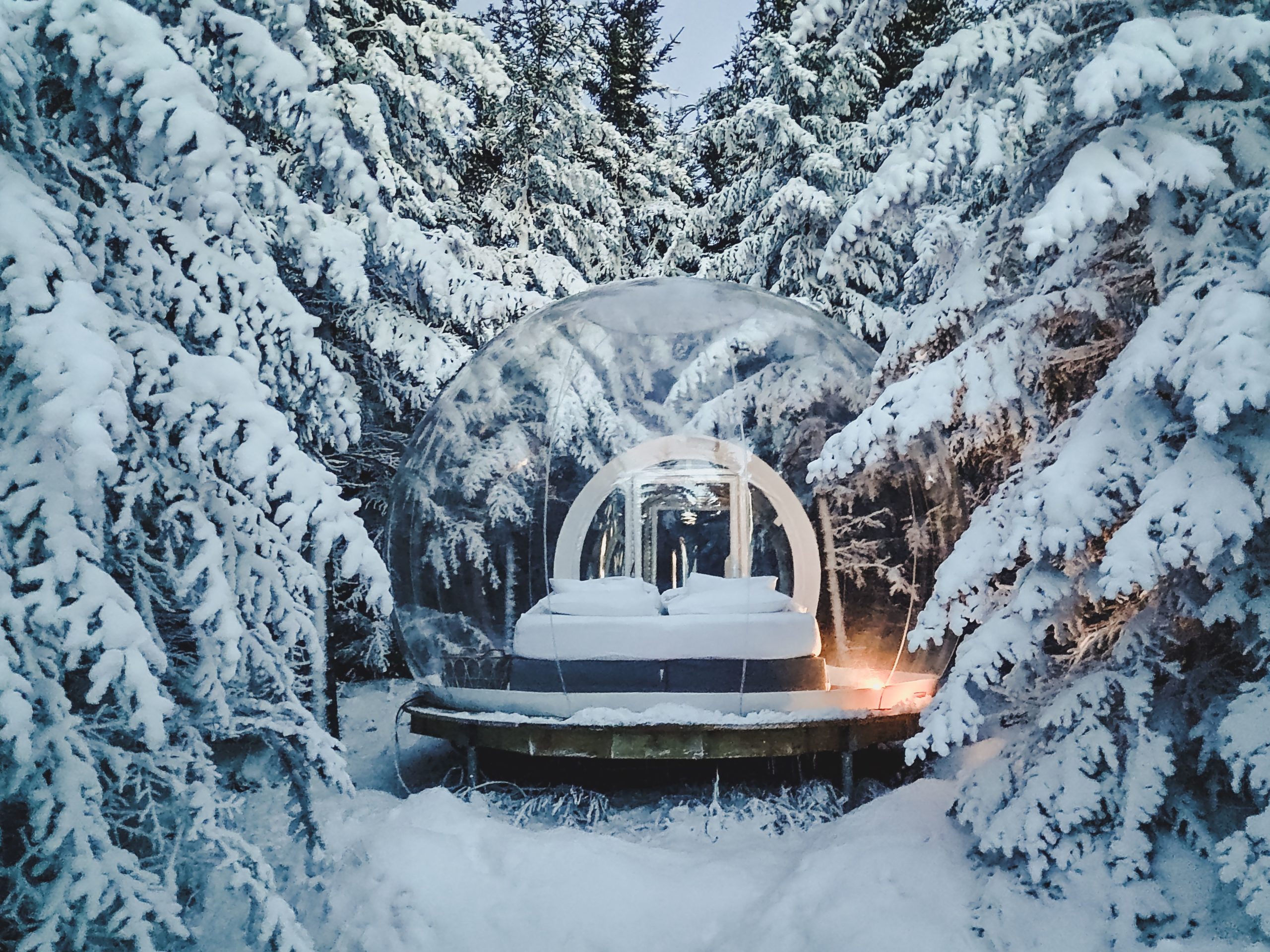
From our very earliest days, many of us have dreamt about sleeping outside beneath the moon and starlights. Such inner-longing is to be expected from us, a species that has only just abandoned outdoor living for the comforts and ease of modern amenities.
Still, the thought lingers, the urge to get back to one’s roots and experiencing life naturally. It is as part of every child, as it is every human being on earth. Who among us, after all, did not once ask our parents whether we could sleep out in the garden at some point during our formative year?
Sure, childhood camping trips might have scratched that itch many years ago, but did said experience take place in a land as staggeringly beautiful, strikingly dramatic and ultimately awe-inspiring as Iceland?
We like to think not.
For anyone who decides to stay in a bubble in Iceland, we have strived to make this childhood dream a reality. Stepping inside one of our transparent bubbles for the first time, you will feel a rush of exhilaration overcome you, the sense of a long-held dream finally realised.
PLAN YOUR JOURNEY
Travelling to Iceland?
Check our overnight tours with a driver guide that includes a one night stay in a bubble.
*Starting from ISK 59.900 per person
Top 10 Best Waterfalls in Iceland
Top 10 Best Waterfalls in Iceland
By Michael Chapman
Discover the land of ice and fire's most scenic cascades!
Top 10 Best Waterfalls in Iceland
By Michael Chapman
Discover the land of ice and fire's most scenic cascades!
Given that approximately 11% of Iceland’s landmass is covered by glacial ice, one would not be chastised for wondering where all that meltwater eventually goes. The answer is found tricking, or in some cases, rushing by way of river towards the island’s black sand coastlines.
Crossing snake-like across rugged countryside, these rivers often arrive upon steep ledges and cliffsides, culminating in a feature that has long put Icelandic nature on the map; waterfalls! Iceland boasts a diverse number of waterfalls; some large, some small, but all are worthy of appreciation for anyone planning a visit.
Below, we’ve listed what we consider to be the Top 10 waterfalls in Iceland, starting with one found not far from both the capital, Reykjavik, and the popular sightseeing route, the Golden Circle.
We speak, of course, of Goðafoss, Waterfall of the Gods. Let’s begin there.
10. Goðafoss
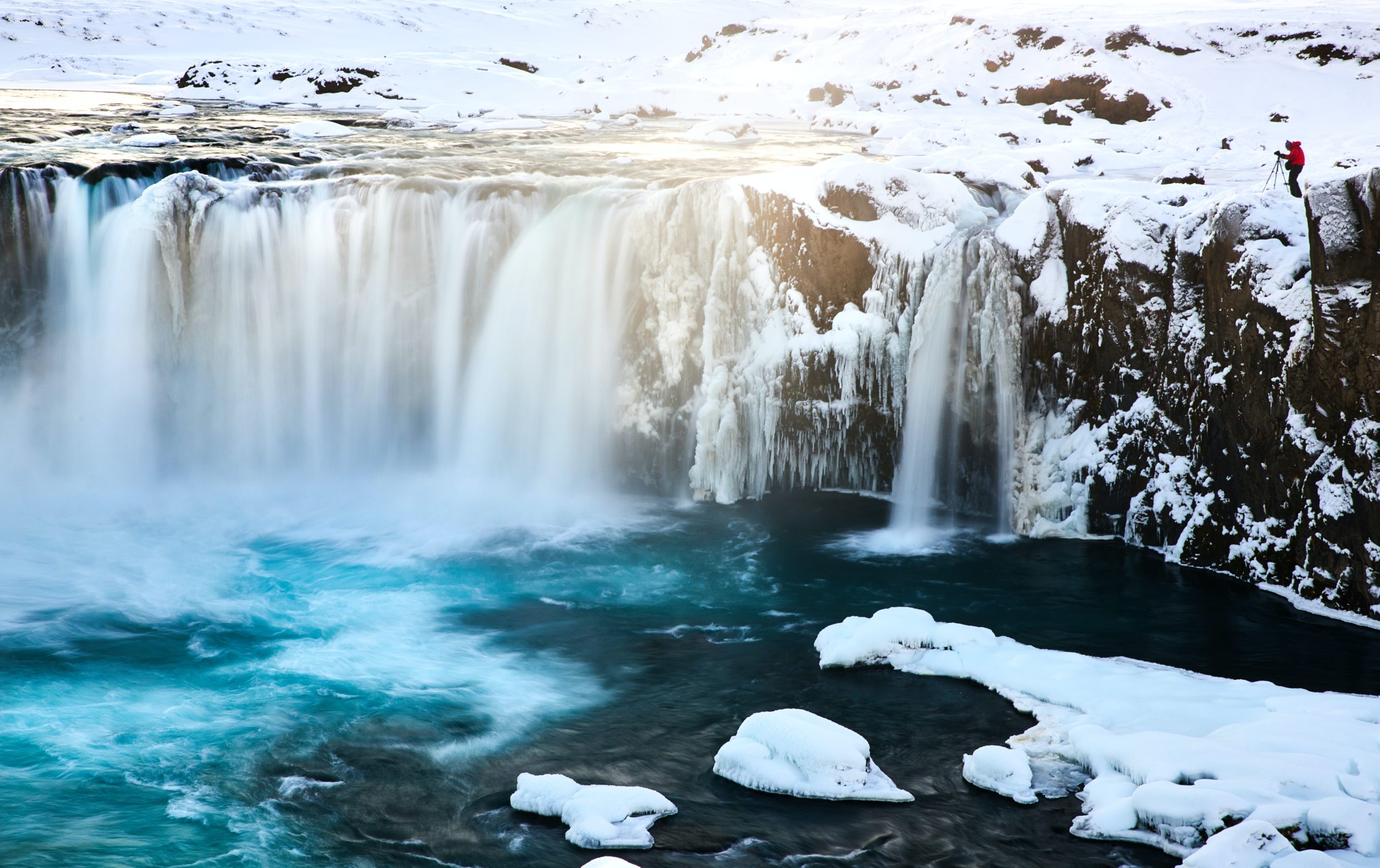
Goðafoss’ nickname, Waterfall of the Gods, has its origins in the cold and tumultuous years that followed the island’s mass-conversion from Norse Paganism to Christianity. Well, that is according to the legends…
Upon adopting this new ideological outlook, the proud Chieftains of various clans across Iceland culminated at Goðafoss, where they threw formerly revered pagan idols into the water. Today, when looking up the site’s frothing currents, with the nearby cascade roaring in your ears, it’s easy to wonder if such treasures still lie somewhere below the water surface.
Goðafoss is one of the many waterfalls found on the Skjálfandafljót river. Visitors on site will quickly note the waterfall’s width, 30 metres, which is somewhat more impressive than its 12-metre drop. Regardless, the falls’ shape is particularly distinctive, making it more than worthy of your photographs.
The waterfall is surrounded by the gnarled lava fields left behind by the Trölladyngja volcano. Such scenery makes for pleasant surroundings when walking by the river. With that in mind, you won’t want to miss visiting this attraction the next time you partake in West Iceland’s famous Golden Circle sightseeing route.
9. Seljalandsfoss
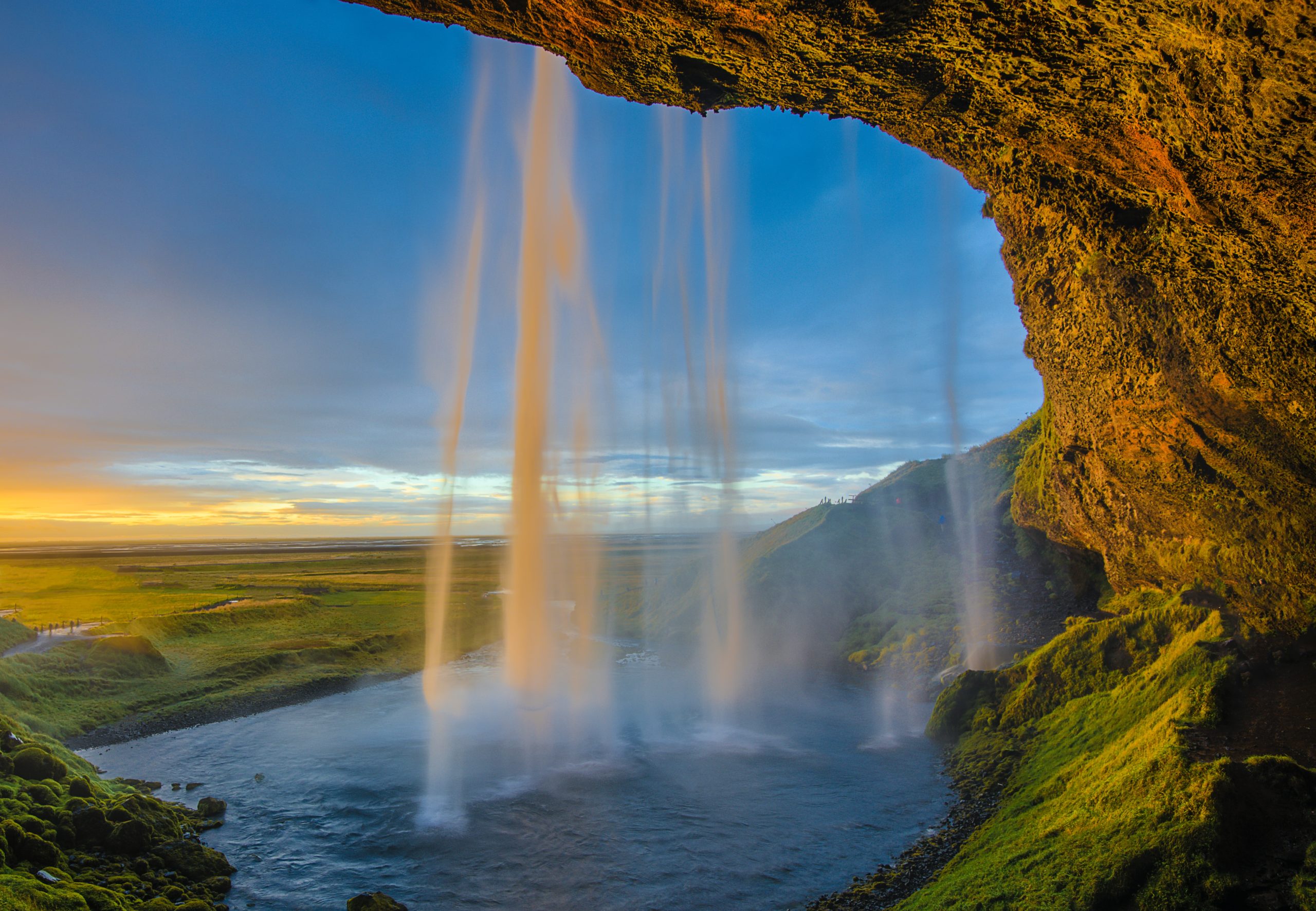
Recognisable the world-over thanks to its propensity for appearing in local tourism campaigns, Seljalandsfoss waterfall is one of the South Coast’s star attractions. As a narrow cascade that drops sixty metres over a moss-laden cliffside, this stunning site is rightfully considered one of the most beautiful waterfalls in the country.
A walking path leads behind the water, which allows for a new perspective of the site. As is to be expected, this has become a popular photography spot, perfect for capturing the rays of the Midnight Sun as they shine through the falling water. However, be aware that the path often becomes covered with ice during the winter, making it potentially dangerous for those in the wrong footwear.
Another reason for its immense popularity lies in its easy accessibility from the Ring Road. Driving by, there’s no simply no way you’ll miss it. There is free parking onsite, and you’ll often find other travellers and tour groups utilising the location as a meeting spot.
PLAN YOUR JOURNEY
Travelling to Iceland?
Check our overnight tours with a driver guide that includes a one night stay in a bubble.
*Starting from ISK 59.900 per person
8. Skógafoss
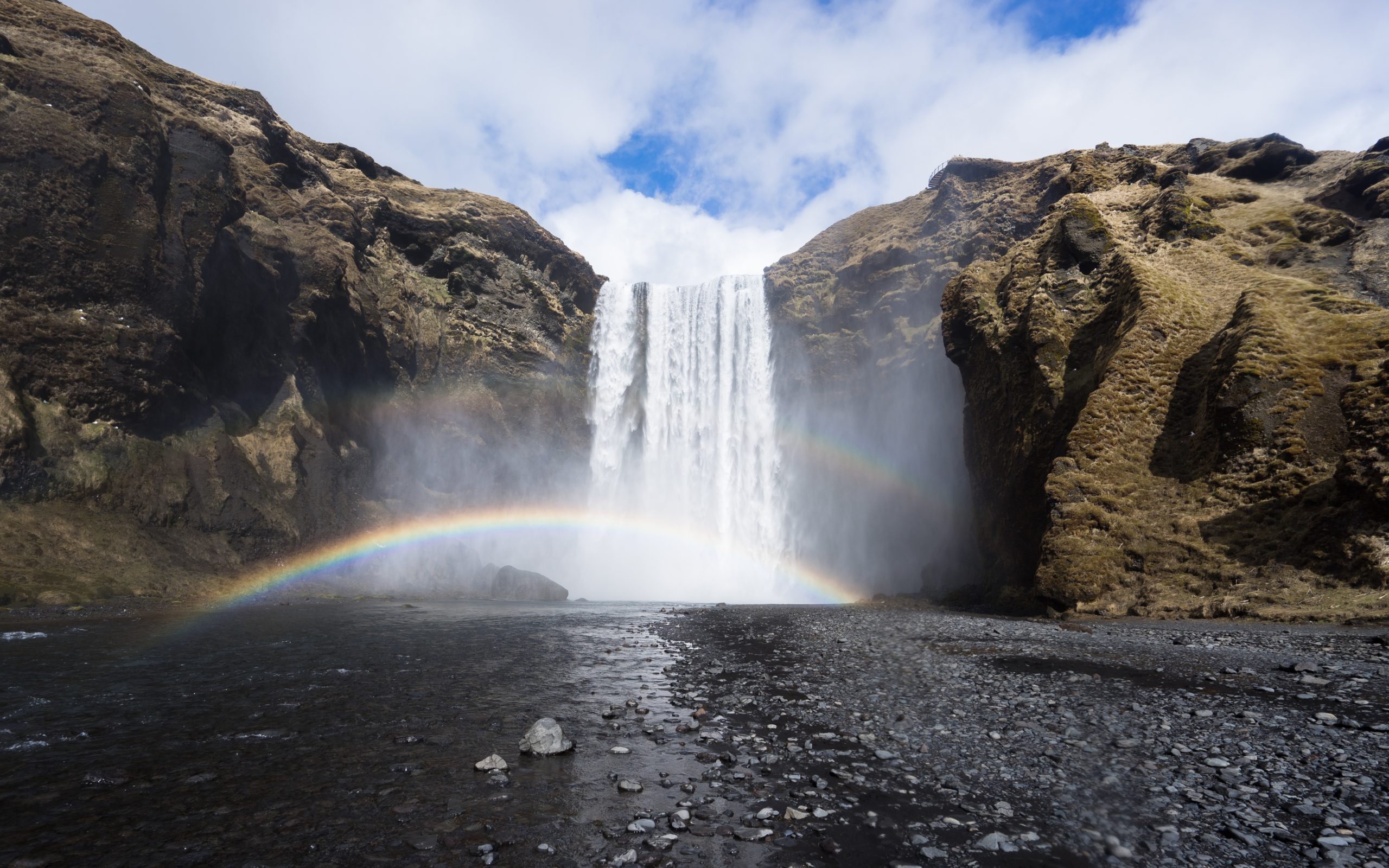
Skógafoss is also found right alongside the Ring Road and can be seen heading a short way east from Seljalandfoss. You will immediately notice the waterfall is much broader than its neighbour, creating an enormous steam plume that often catches rainbows in the summer.
According to folklore, a mysterious treasure is said to sit behind the curtain of cascading water. Unfortunately, the flow is so powerful that stepping behind it is an impossibility, and that’s not to mention the troll legends claim guard the treasure day-and-night.
There are two observation points from which to view Skógafoss. The first is at the base of the waterfall itself, allowing for a staggering perspective of the feature as it towers over you. While this might be the best spot to appreciate the sheer power on display here, there is no guaranteeing you will stay dry throughout the experience.
The second observation point is at the very top of the waterfall. Visitors have to ascend a winding wooden staircase that leads up the side of an ancient sea cliff, granting them access to the lip of the waterfall. Some visitors will not make the extra effort to see the waterfall from this angle, but those that do will also be blessed with beautiful views over the South Coast countryside.
7. Aldeyjarfoss
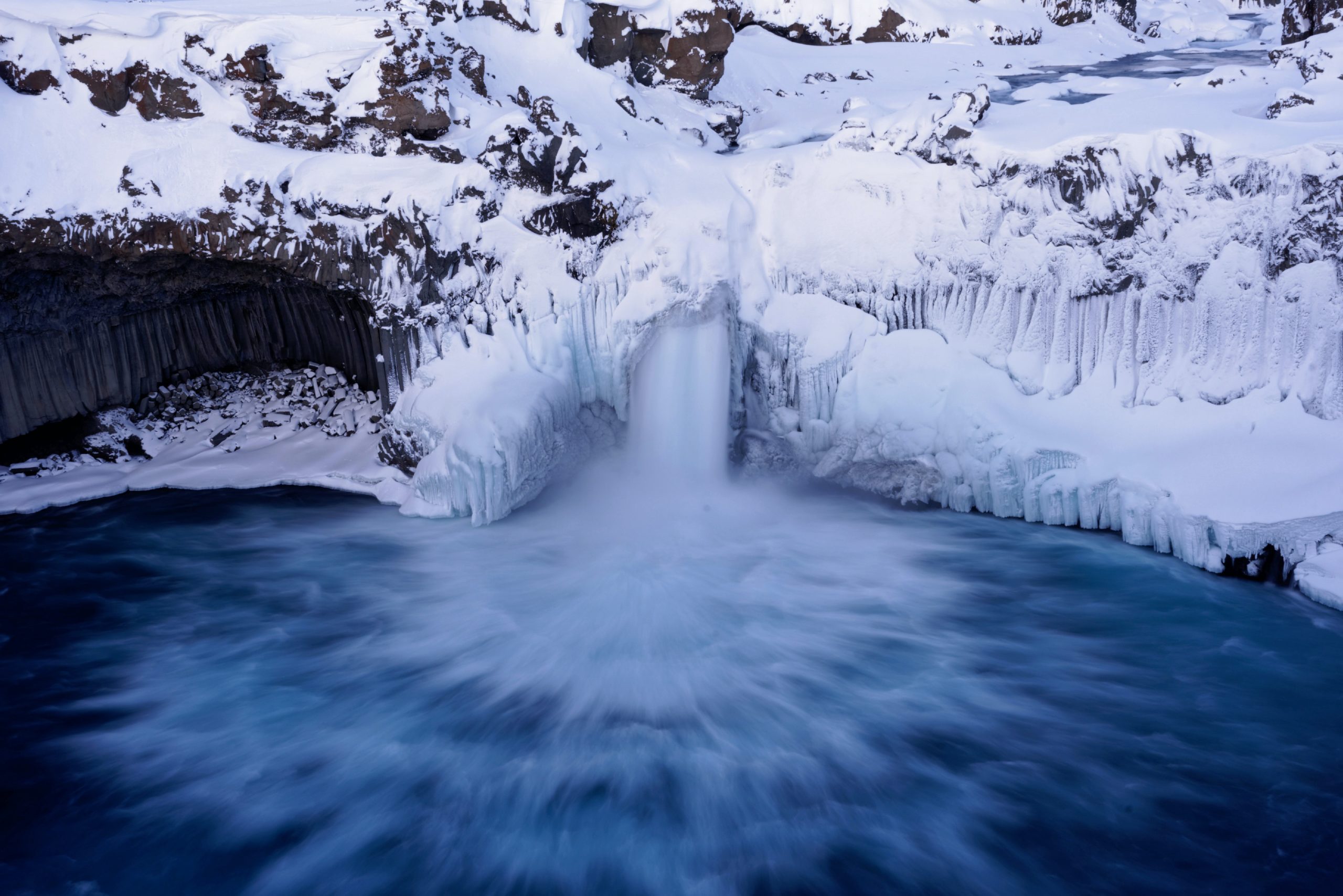
Aldeyjarfoss may not be as enormous or dramatic as its counterparts around the country. Instead, it offers alien surroundings and a photogenic pool so round that one might think it had artificially made.
Like those found at Reynisfjara beach and Skogafoss waterfall, Aldeyjarfoss and its pool are surrounded by distinctive black columns formed by historic lava flows.
Much the same as the Waterfall of the Gods, Goðafoss, Aldeyjarfoss can be found on the Skjálfandafljót river. However, it is found far north in the Icelandic highlands. Given its location, anyone staying or passing through the town of Akureyri are best placed to visit the waterfall.
To access this stunning site, you will need to divert off the Ring Road between Lake Myvatn and Akureyri, travelling down 842, then the gravel road, F26. A 4×4 vehicle is necessary considering the rough terrain en route, and visitors should only attempt to visit during the summer.
6. Háifoss
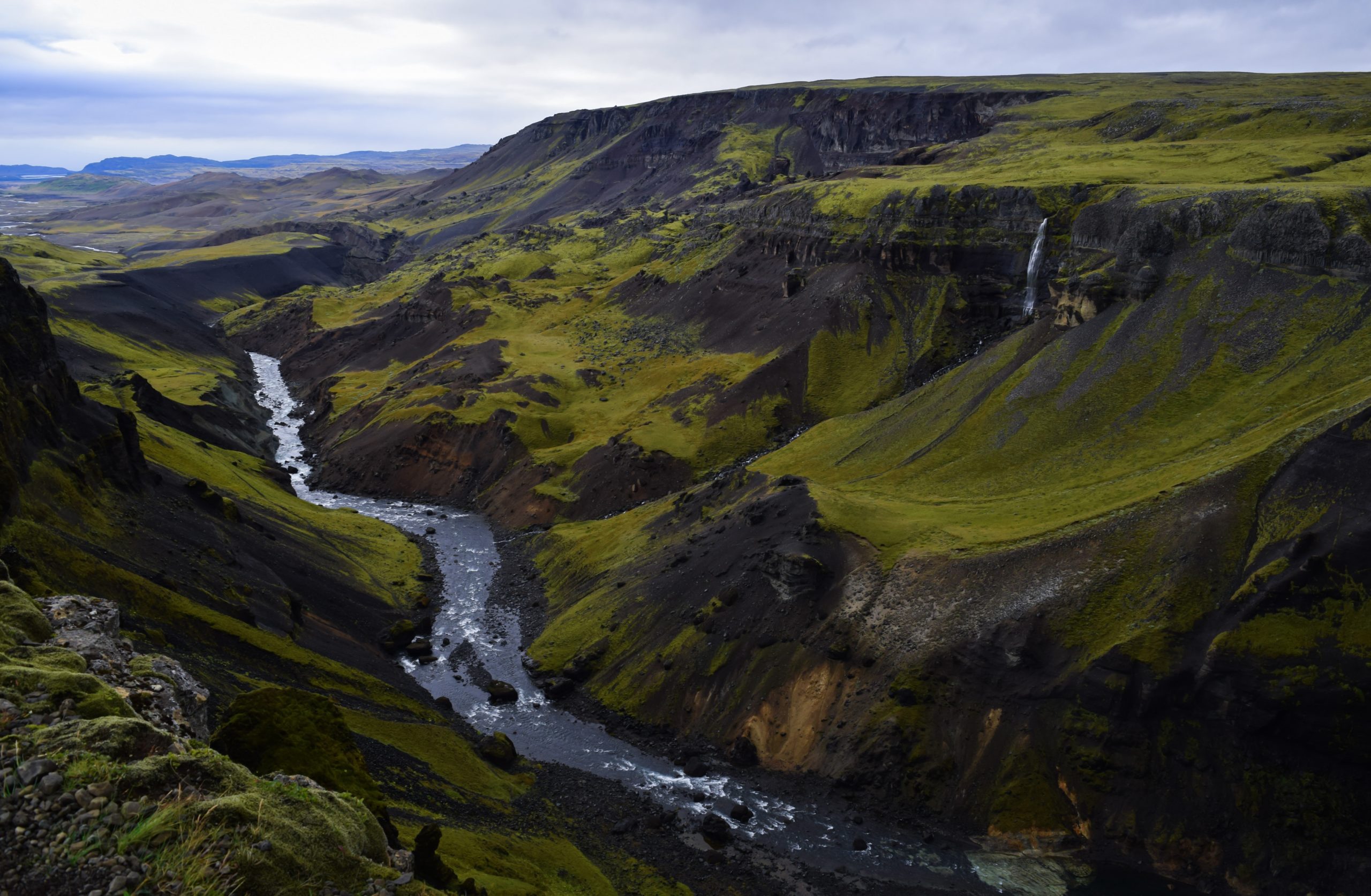
Háifoss waterfall boasts an incredible drop of 122 metres, making for a sublime subject for landscape photographers who have hiked there for that very purpose.
Right beside the waterfall is Granni, which roughly translates to ‘neighbour’. Granni is just as impressive as Háifoss, though it is best appreciated when the waterfalls are viewed alongside one another. To achieve such a perspective, visitors will hike up the cliff sides opposite the waterfalls or traverse the pebbled riverbed at the canyon basin.
Háifoss comes fourth in the tier of Iceland’s tallest waterfalls. At around 240 metres, the waterfall Morsárfoss is the tallest, though it only became visible in 2007 after the Morsárjökull glacier began to melt. Given that fact, Morsárfoss is not as easily accessed as most other waterfalls found across the country.
5. Gullfoss
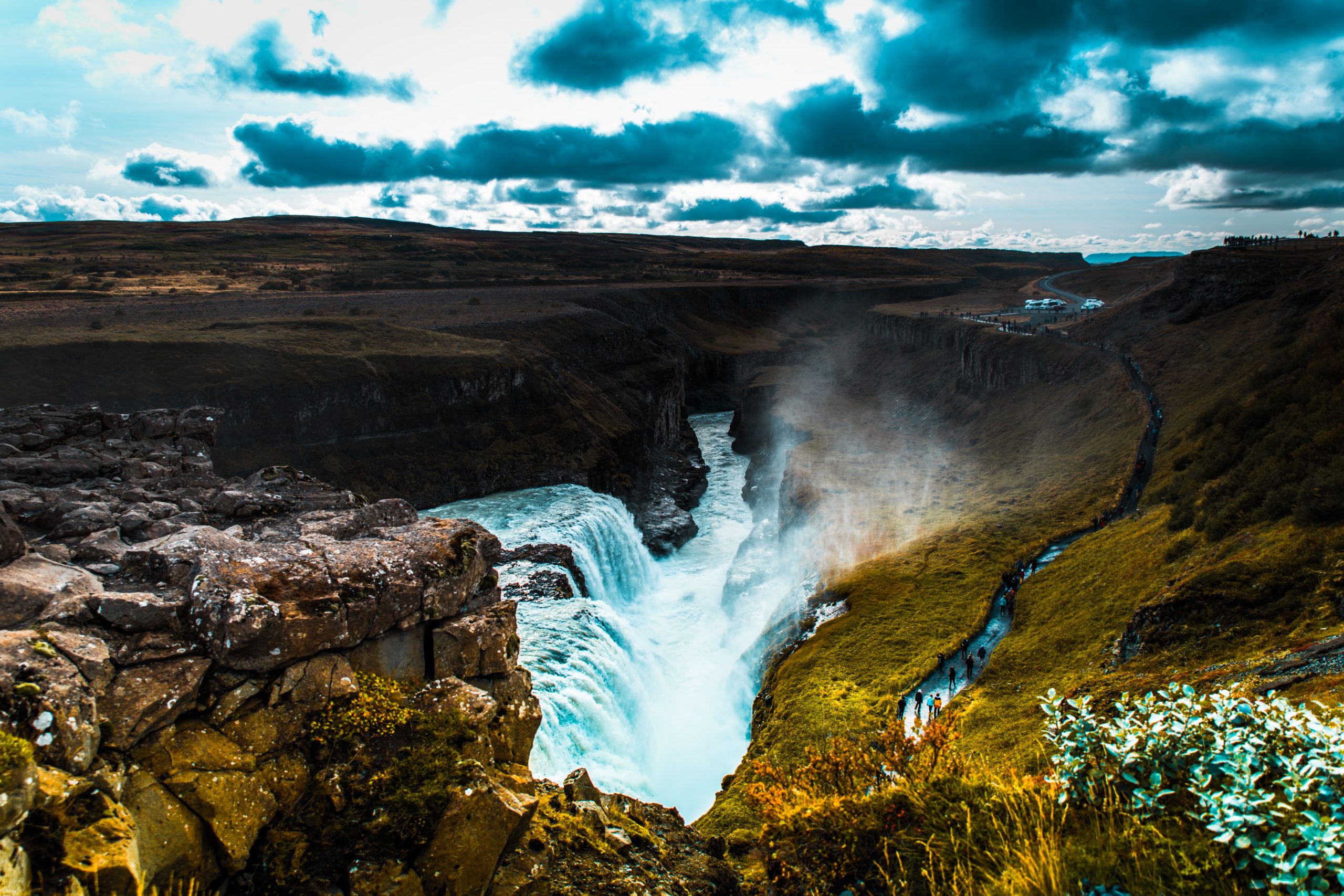
Gullfoss falls a total of 32 metres. It does so over two jagged ledges, coming to an end in the dark underbelly of the Hvítá river canyon. The waterfall’s name translates to ‘Golden Falls,’ which brings us swiftly to our next point.
Alongside Thingvellir National Park and Geysir geothermal springs, Gullfoss waterfall makes up part of the famous Golden Circle sightseeing route. It has the special accreditation of having lent its name to the trail. In that sense, some might consider Gullfoss waterfall to be the star attraction, and they wouldn’t be far wrong in their thinking.
If you are interested in witnessing these grand attractions for yourself, we advise you to check out our Golden Circle Bubble tour! Being driven from site to site by our experienced guides, you will leave the Golden Circle area with a better appreciation of this island’s nature, history and culture.
Besides that, you’ll spend the night in one of our transparent bubbles, allowing for fantastic views of the stars and Northern Lights from cosy and comfortable surroundings.
4. Glymur
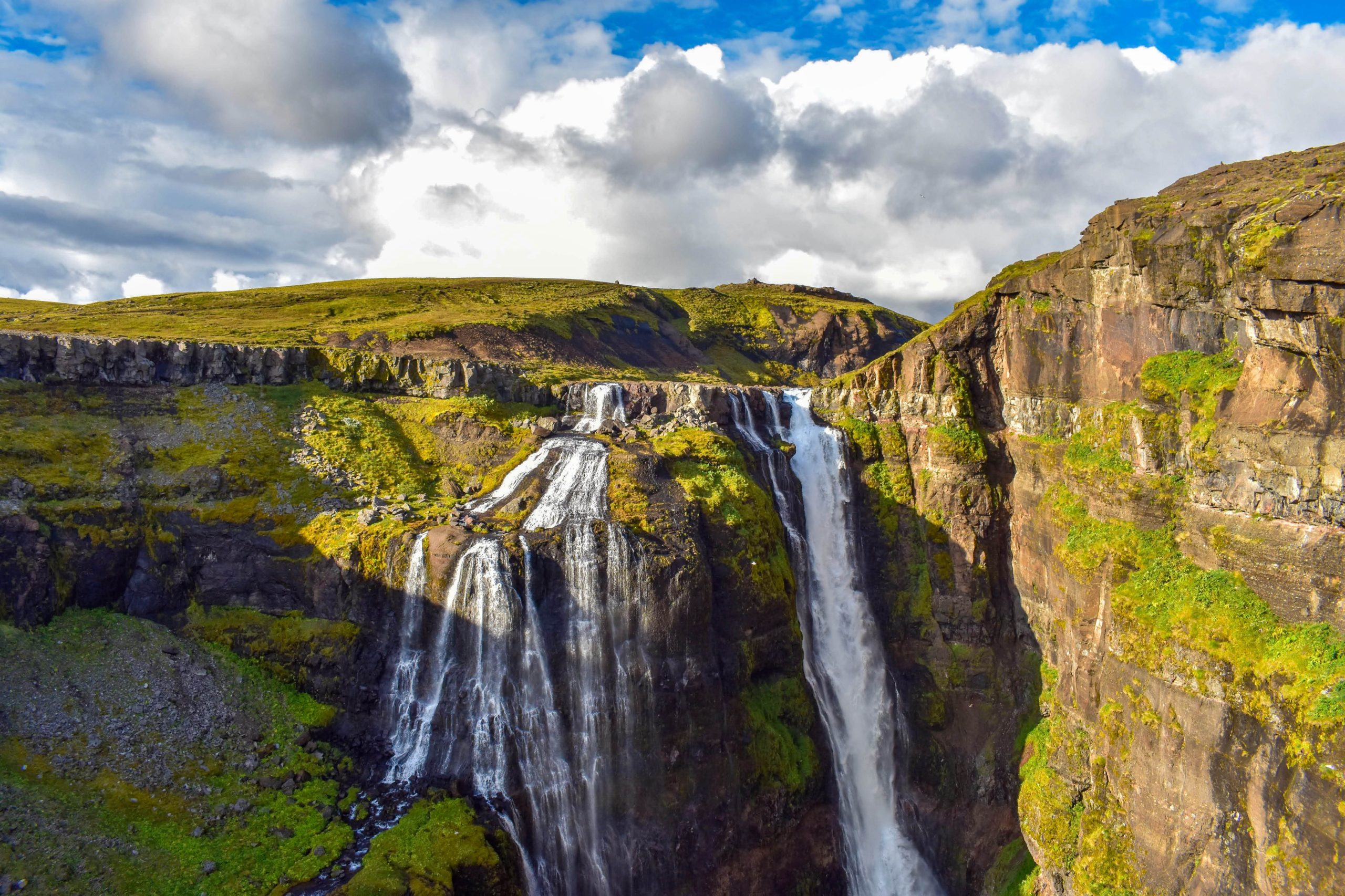
Glymur is the second-tallest waterfall in Iceland at 198 metres tall. It was once considered the tallest until the waterfall Morsárfoss (248 metres) appeared in 2007 after the Morsárjökull glacier began to melt. Given that fact, Morsárfoss is not as easily accessed as most other waterfalls found across the country.
Still, Glymur is more than worth hiking to, especially considering it is advantageously found just forty-five minutes drive from Reykjavik. Located in Hvalfjordur fjord, the entire area is lush with steep table-top hillsides, each of which promising magnificent views over the water bodies that dot the area.
The hike to Glymur is an adventure in itself, requiring visitors to cross rivers, enter caves and navigate steep mountain passes. Such a trail is thrilling at the best of times, but it is made all the better knowing that Glymur awaits as your finale.
Do note, however, that the hike is no easy feat, thus should only be undertaken by those with at least a moderate level of physical fitness. Covering approximately 4.6 miles (7.5 km), most hikers will take around 3 – 4 hours to get from the car park to the waterfall and back.
3. Svartifoss
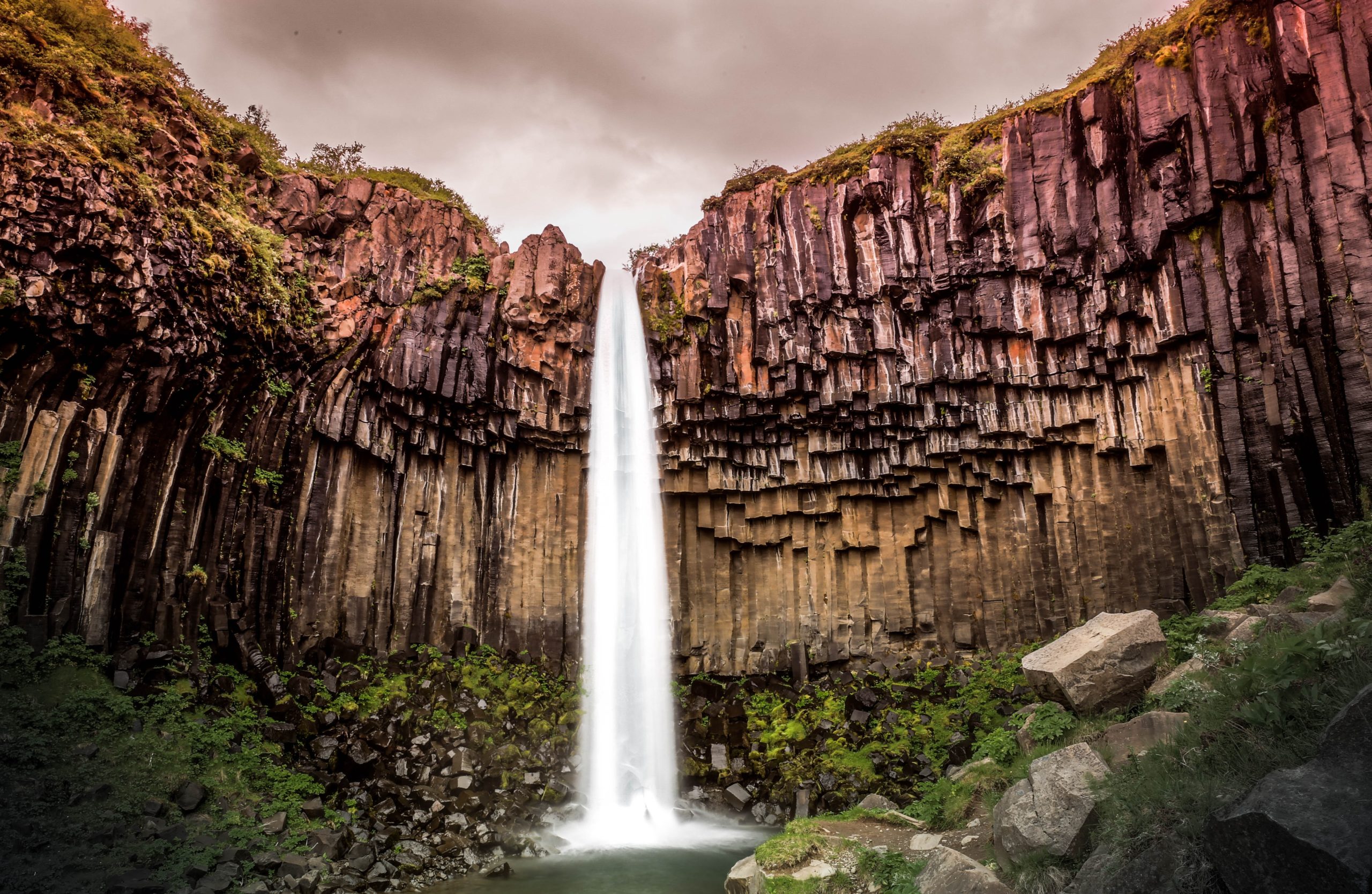
Svartifoss translates to ‘The Black Waterfall’, and anyone who stops by will find it named for seemingly obvious reasons. Behind its narrow strip of falling water, hexagonal columns stretch out like the enclaves of a haunted fortress, hanging low from the cavern ceiling, inspiring awe in anyone who looks upon them.
The basalt columns that frame Svartifoss inspired the former and prominent state architect, Gudjon Samuelsson, when designing the iconic steeple of Hallgrimskirkja Lutheran Church in Reykjavik.
The trail to Svartifoss covers around 2 kilometres, so make sure to allow yourself between one or two hours hiking if you plan on paying a visit. If you’re looking to learn more, there is a Visitor’s Centre on site ready to provide you with terrain maps, extra kit and any advice that might come in handy before setting off.
2. Dettifoss
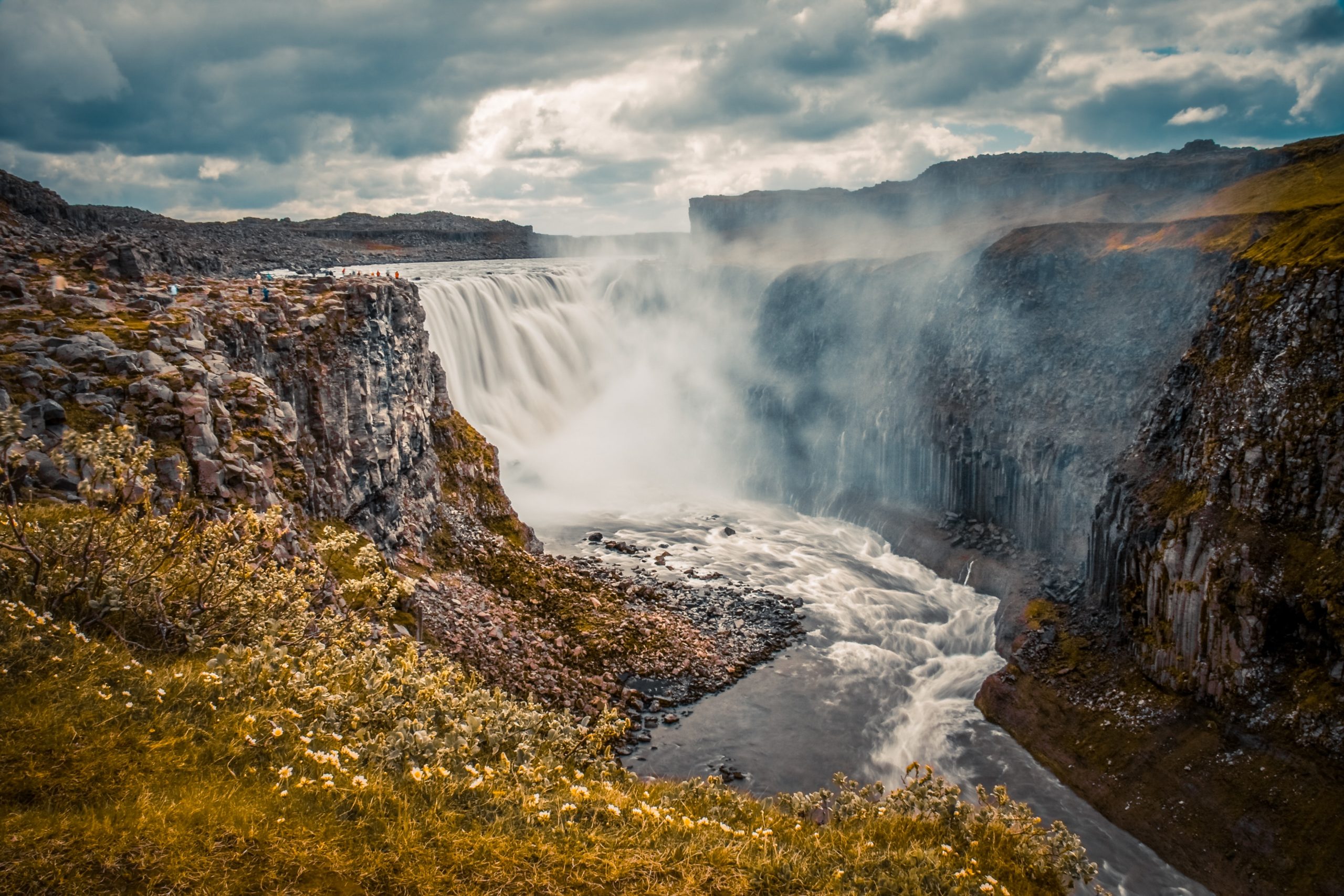
A staple attraction of Vatnajökull National Park, Dettifoss waterfall is surrounded by grey weatherbeaten rock sculptures formed over thousands of years. It makes for one of the more unique landscapes in Iceland, and helps to build suspense and excitement on approach to the falls.
Wondering the rugged trail that leads from the car park to the waterfall, you will see its misty plume long before glimpsing any cascading water. The roar of water, thundering from some distance, will quickly ripple over you, demonstrating the might on display. No surprises then that Dettifoss has the most powerful flow of any waterfall not just in Iceland, but the whole of Europe.
Dettifoss was introduced to audiences worldwide thanks to its use in the opening scene of Ridley Scott’s sci-fi epic ‘Prometheus’ (2012). It is clear upon arrival why the director chose this site to substitute for his intellarstaller landscape, as there are very few places on earth that one can compare it to.
1. Dynjandi
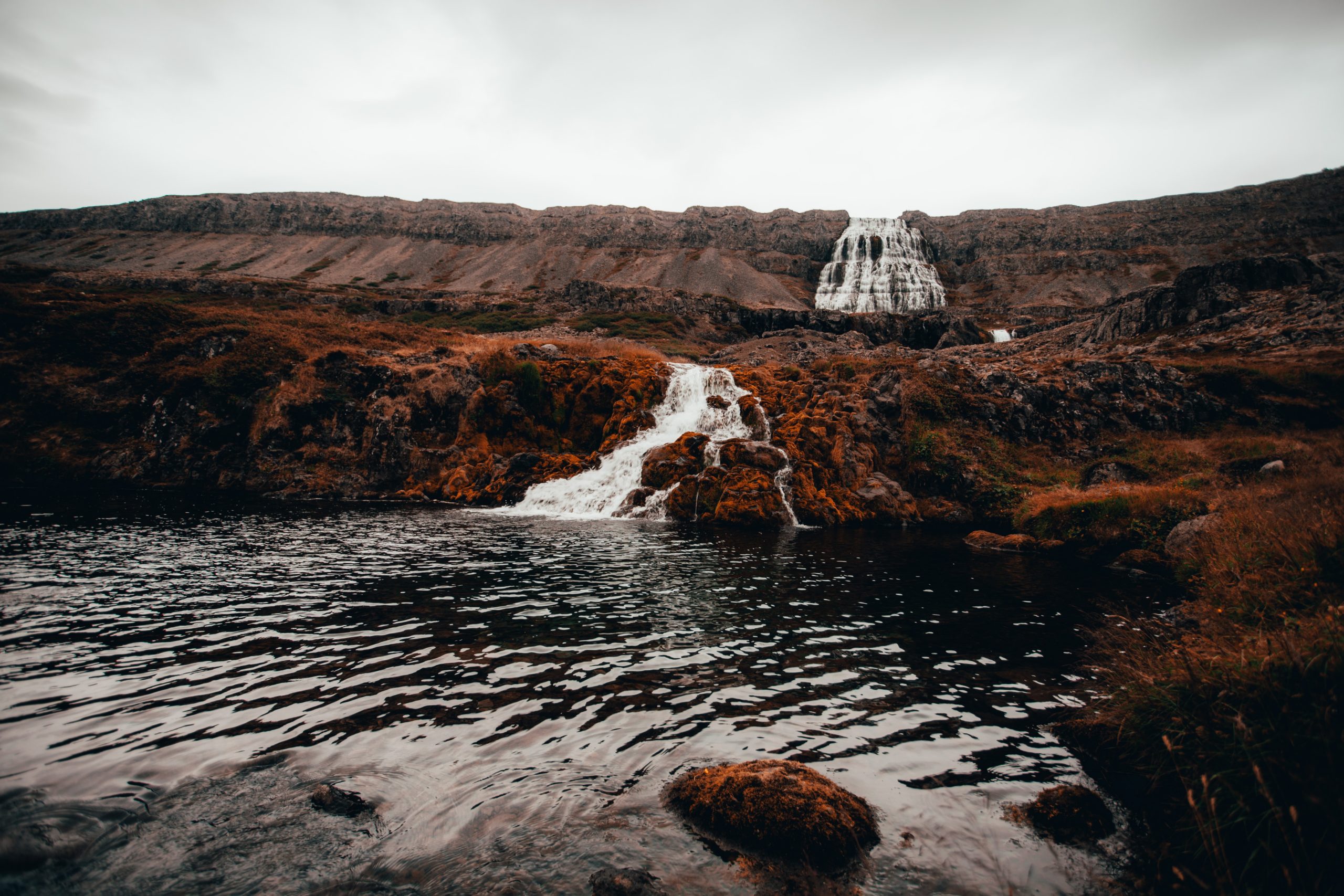
Otherwise known as Fjallfoss, Dynjandi roughly translates to “Thunderous”, which should provide you with some idea of what to expect from this magnificent waterfall in the Westfjords.
The drop’s height is around 100 metres, though guests can see several other waterfalls below Dynjandi itself. Though words like Hæstahjallafoss and Strompgljúfrafoss are often too much for the foreign tongue to tangle with, each of these waterfalls has its own name.
Dynjandi refers to a series of waterfalls rather than a single one and comprises several stages that rise upward like a wedding cake or superhero’s cloak, depending on who you ask. It is the bottom of the falls that captures the most significant attention given its generous 60-metre width.
Walking from the car park to the waterfall takes approximately fifteen minutes, a short walk through the sublime and untouched surroundings that make the Westfjords so alluring.
PLAN YOUR JOURNEY
Travelling to Iceland?
Check our overnight tours with a driver guide that includes a one night stay in a bubble.
*Starting from ISK 59.900 per person
Iceland's Beautiful Jökulsárlón Glacier Lagoon
Jökulsárlón Glacier Lagoon
By Michael Chapman
The Queen of the South
Jökulsárlón Glacier Lagoon
By Michael Chapman
The Queen of the South
Jökulsárlón is a stunning iceberg-filled glacier lagoon located in South Iceland’s Vatnajökull National Park.
When describing Jökulsárlón lagoon, words like ‘ethereal’ and ‘heavenly’ are thrown around by content writers as if they were confetti. The truth is, such adjectives are astoundingly accurate when trying to capture this beloved natural site in the readers’ imagination.
Is visiting Jökulsárlón worth it?
When standing on the pebbled lake bank, one is overwhelmed by nature’s utter transcendence; the icebergs, the water, the wind, mountains, and glacier tongues. Whilst not quite a religious experience, it comes close, for this waterbody can draw out mysterious feelings in anyone.
Icebergs routinely drop off from Breiðamerkurjökull, an outlet glacier of the larger Vatnajökull from which the park takes its name. To visitors, Breiðamerkurjökull appears as a solid wall of ice that creeps slowly towards higher elevations. Enclosed by snow-peaked mountains and shadowy gravel hillsides, there is simply no other way of describing this place other than entirely cinematic.
Hollywood has been aware of this for some time, having used Jökulsárlón as a shooting location for numerous productions. Lara Croft: Tomb Raider, James Bond’s Die Another Day and Batman Begins are just three of the biggest media franchises to shoot footage here, forever immortalising the lake in celluloid.
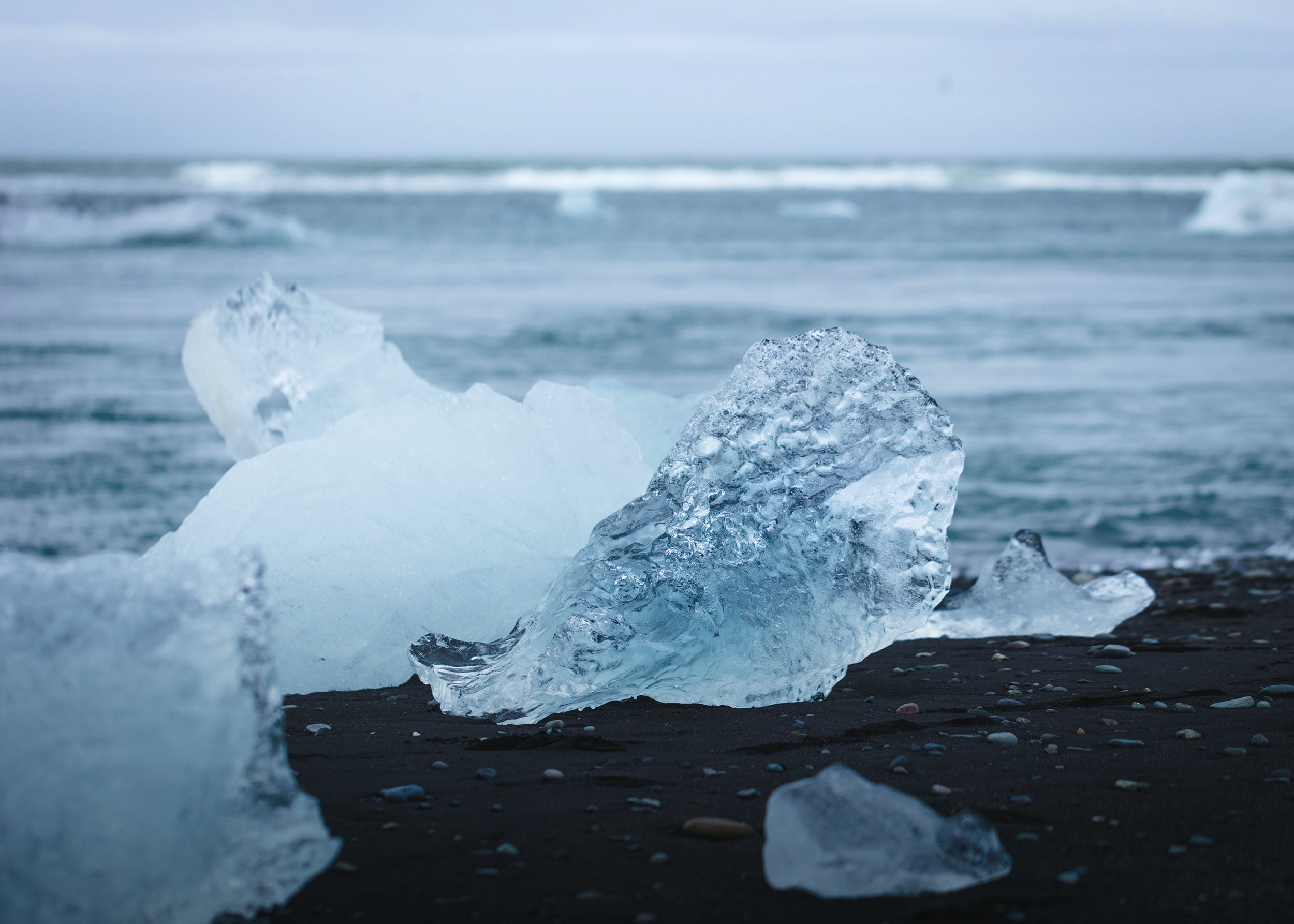
Jökulsárlón glacier lagoon is far younger than the majority of Iceland’s attractions, having only begun its formation in 1934 following the retreat of Breiðamerkurjökull. However, in the early 1970s, the lagoon had a growth spurt, almost quadrupling in size as the decade progressed. The fact that this occurred when environmental consciousness was rapidly expanding in Iceland was lost on no one.
Today, Jökulsárlón has the greatest depth of any lake in Iceland, 248 metres, and covers a total square surface of 18 km²—not small by any means! The lake’s aquamarine colour is derived from a mixture of salt and freshwater, while the ice that floats atop is over 1000 years old.
PLAN YOUR JOURNEY
Travelling to Iceland?
Check our overnight tours with a driver guide that includes a one night stay in a bubble.
*Starting from ISK 59.900 per person
How to get to Jökulsárlón glacier lagoon?
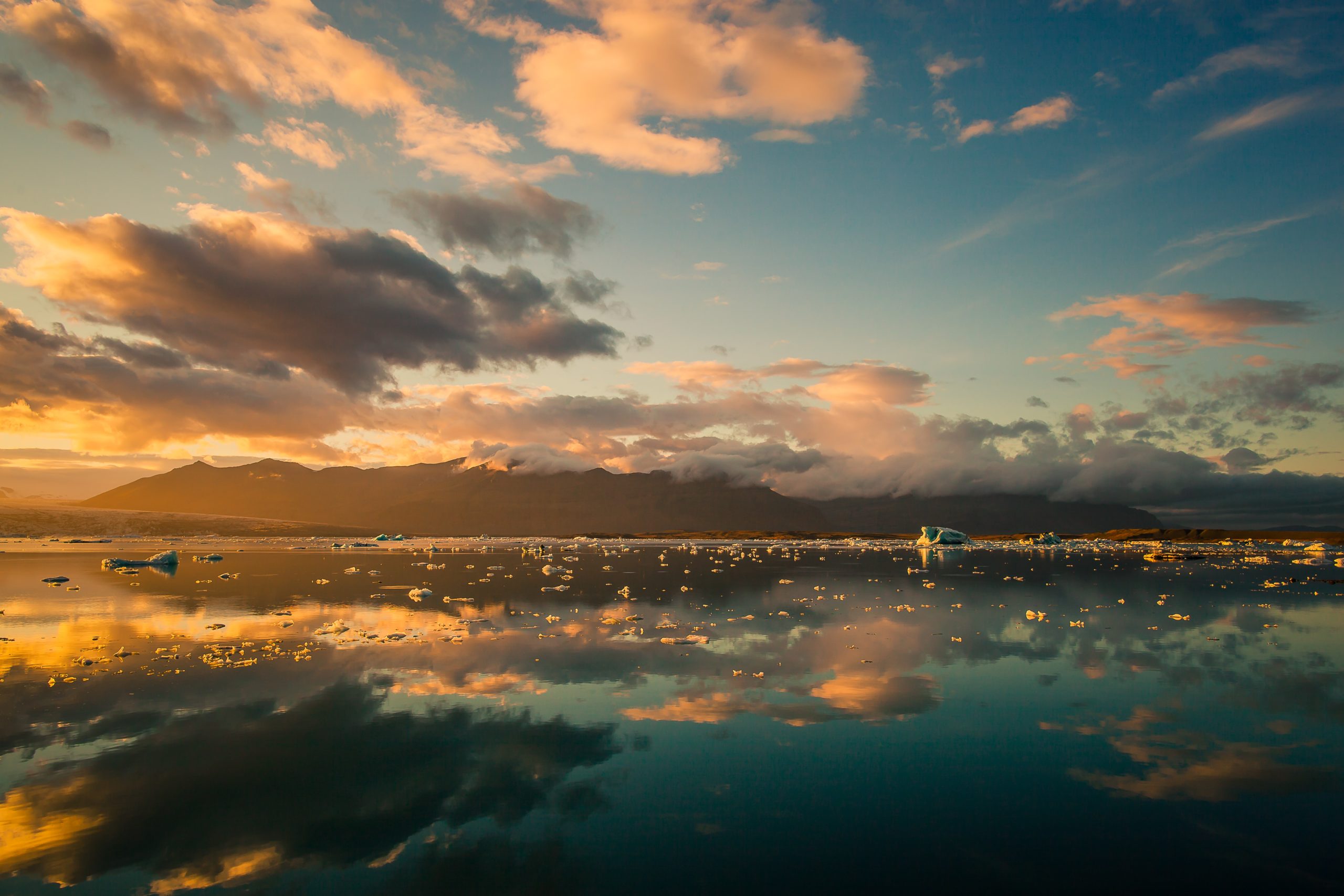
Jökulsárlón glacier lagoon is located in the southeast of the country, far from the capital and where most people will be staying. Given the distance, travelling to Vatnajokull National Park is an adventure, one that will take you across diverse landscapes with countless diversions en route.
From Reykjavik, it takes approximately 5 hours by car to reach Jökulsárlón glacier lagoon. That means that it is possible to make it there and back within a single day, though this is not advised for several reasons, first of which is the many interesting spots you’ll miss on the way.
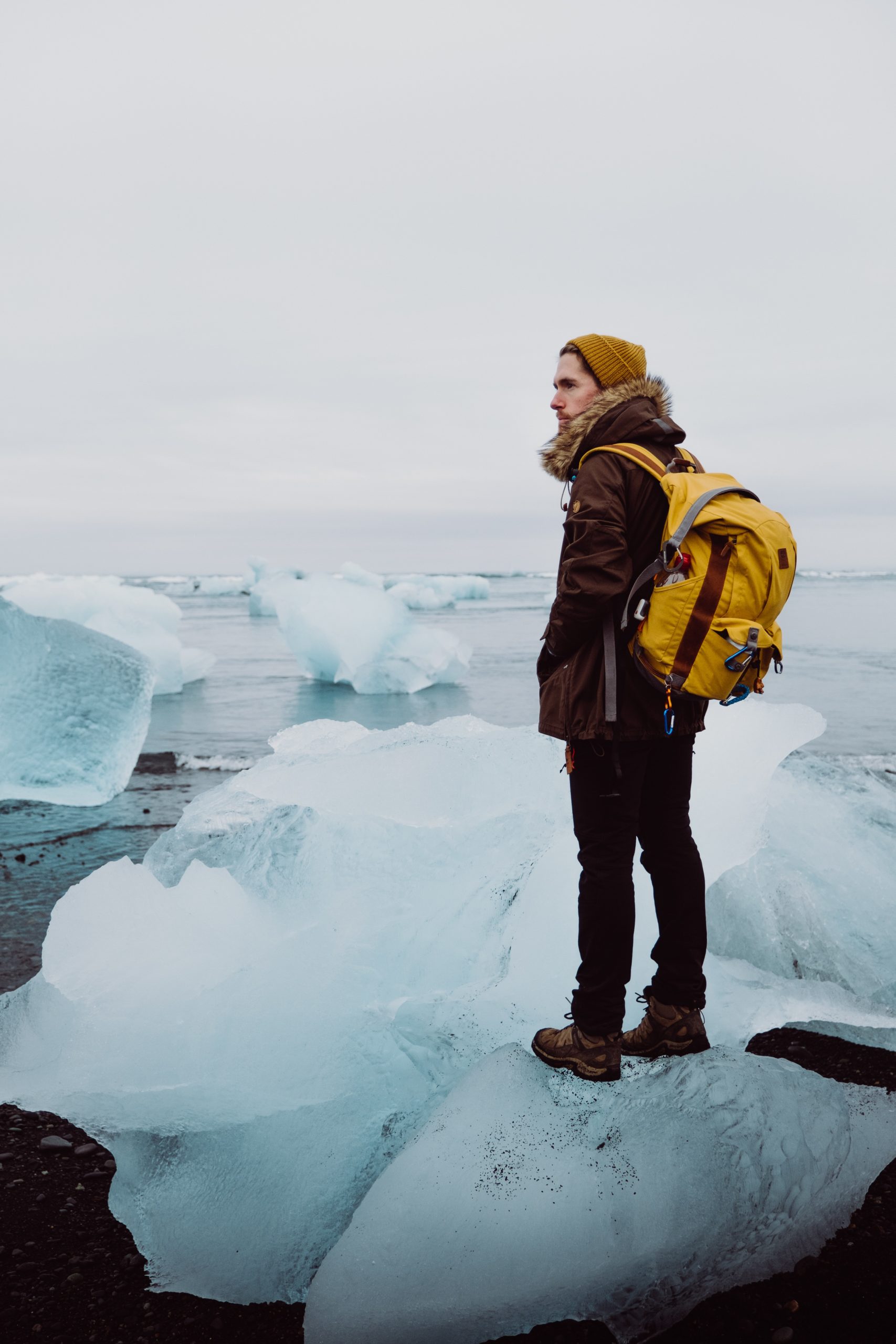
Other options include taking a bus, which will be no shorter than an 8-hour trip to get there, or flying to the east’s largest town, Egilsstaðir. Both these choices are not as efficient as either driving yourself or opting for a guided tour of the area. For that reason, we readily recommend our South Coast Bubble tour.
Not only will this exciting excursion take you by some of the most beloved attractions found along the South Coast, but it will also present you with the opportunity to spend the night in one of our transparent bubbles. A unique accommodation choice by any standard, these novel rooms are perfect for viewing the Northern Lights, doubling up as your very own personal planetarium.
What can you do at Jökulsárlón glacier lagoon?
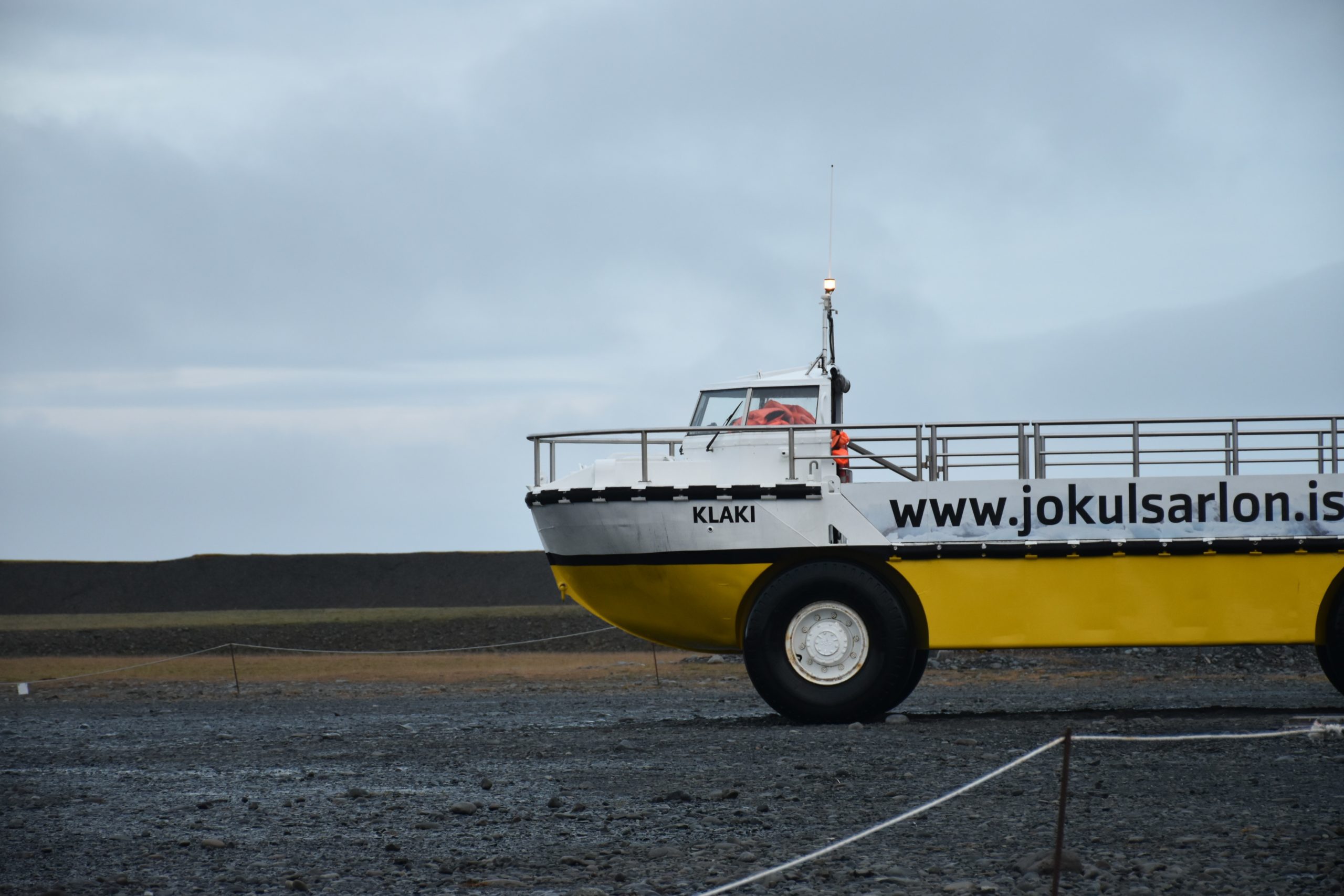
Most people travel to Jökulsárlón glacier lagoon to appreciate the site itself. It is not often, after all, that one comes into contact with a lake topped with floating chunks of ice. As the icebergs move in the water, slowly rolling this way and that towards the Atlantic Ocean, they groan and moan under their own weight.
Those looking to take their experience in a more exhilarating direction are recommended to participate in one of the two types of boat tours available at Jökulsárlón glacier lagoon; Zodiac or Amphibian.
Zodiac boats are small open-top vessels that not only reach high speeds with ease but can also get right up to the icebergs without issue. On the other hand, Amphibian vehicles host larger tour groups and drive up onto the shoreside. Do note that both boat tours only leave during the summer months.
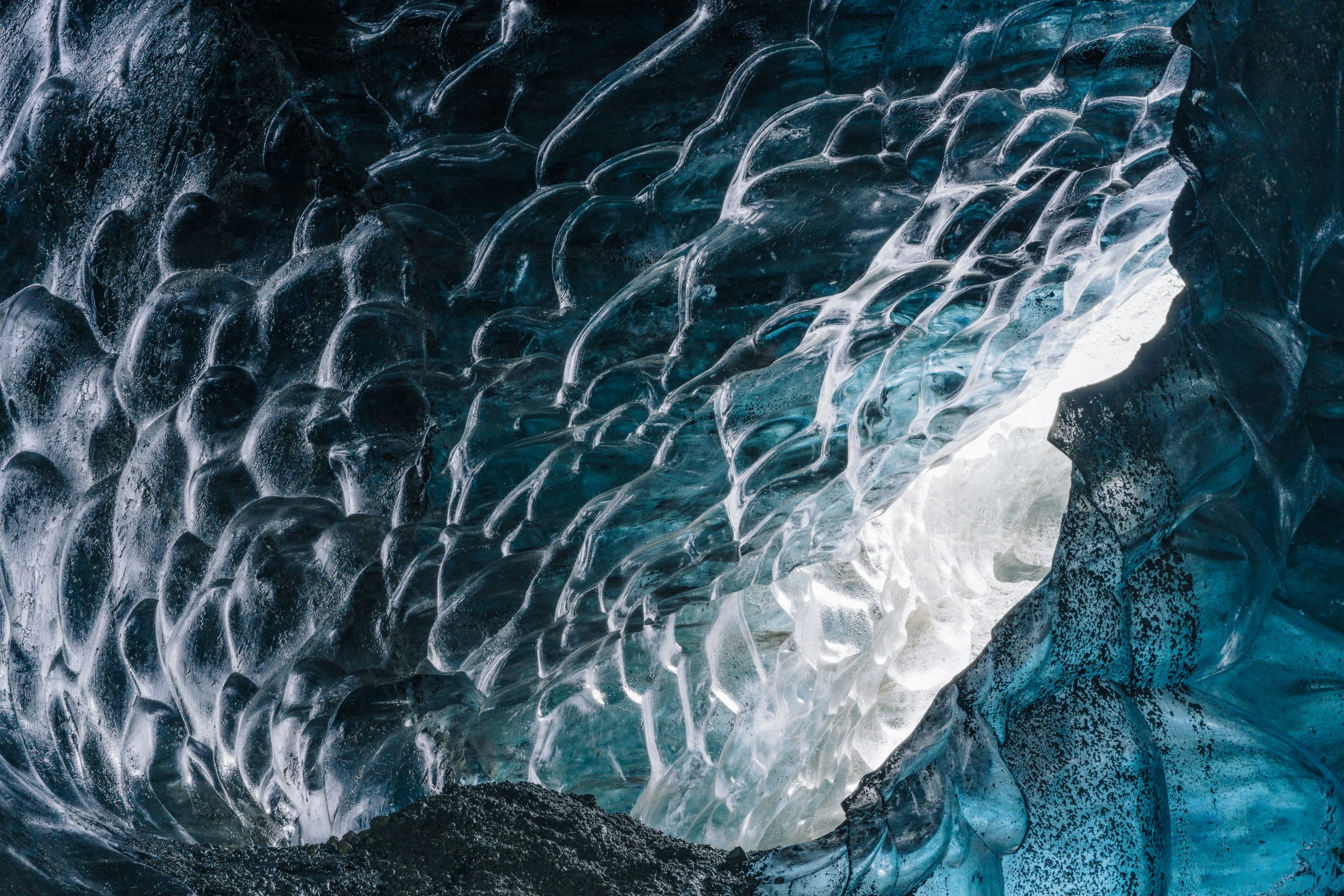
If you decide to forgo setting out on the water, there are still plenty of treats in store. For example, the lake is home to a resident seal colony that routinely dive and play amid the ice. Set back from the shoreline itself, Arctic Skuas used this area as a nesting grounds and are infamous for dive-bombing anyone foolish enough to step too close to their eggs.
Another activity available in the area is ice caving, though this is only open to winter guests. Inside the crystalline hallways that lie beneath Vatnajökull glacier, guests will gain a brilliant insight into the geological forces that make such behemoths of nature possible. Besides that, you will witness firsthand the very depths of the ice body, complete with its glassy walls, air bubbles and naturally-formed sculptures.
Diamond Beach

Nearby to Jökulsárlón, no more than a five minute stroll, is Diamond Beach. This gorgeous stretch of black sand is famed for the many delicate icebergs that wash ashore here, making for fantastic photographic opportunities.
During the summer, enthusiastic shutterbugs love to capture how the ice twinkles and plays with the radiant Midnight Sunlight. On the other hand, winter guests will be privy to much more enormous icebergs floating out sea, making for an impressive Arctic vista that is hard to quantify.
Just like Jökulsárlón, Diamond Beach is part of the Breiðamerkursandur glacial outwash plain, and as such, contributes much beauty to an already staggering region of the country. Breiðamerkursandur covers around 18 kilometres from the base of Kvíárjökull glacier to the dark and gritty shores of Jökulsárlón itself.
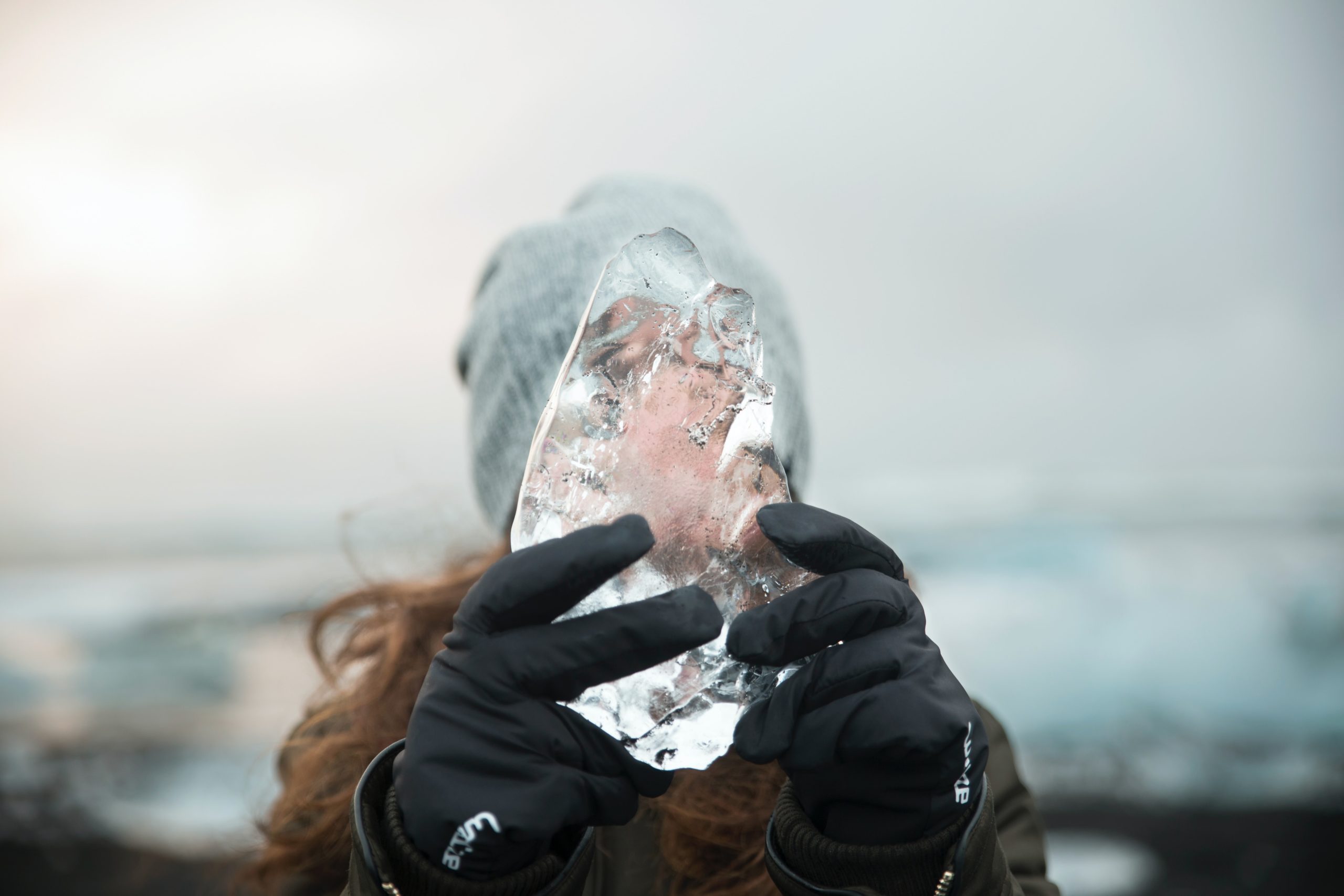
PLAN YOUR JOURNEY
Travelling to Iceland?
Check our overnight tours with a driver guide that includes a one night stay in a bubble.
*Starting from ISK 59.900 per person
Visit The Haunting Iceland Plane Wreck
Visit The Haunting Iceland Plane Wreck
By Michael Chapman
Where Icelandic nature & history merge.
Visit The Haunting Iceland Plane Wreck
By Michael Chapman
Where Icelandic nature & history merge.
One of Iceland’s most iconic images is its DC-3 plane wreck, a metallic and weatherbeaten ghost found amid the volcanic sands of Sólheimasandur desert.
The plane wreck differentiates itself from other attractions in Iceland in so much as it is entirely artificial, creating a striking contrast with the untouched natural environment.
This divergence does much in the way of creating an alien ambience—in fact, one could be forgiven for thinking the wreckage was that of a crashed spacecraft, forever marooned on some far-distant world.
Hollowed out, with a skeletal steel framework and stripped aluminium panelling buffered at all times by oceanic winds, the Iceland plane wreck is as fascinating for history buffs as it is guests looking for novel points of interests out amid Iceland’s wilds.
Of course, none of this mentions the incredible photography opportunities on offer at this site. Visitors forever glued to their lens will, in winter, have the chance to capture the aircraft beneath the colourful ribbons of the Northern Lights, while the golden rays of the Midnight Sun await those in summer.
Why visit the Douglas C-117 Plane Wreck?
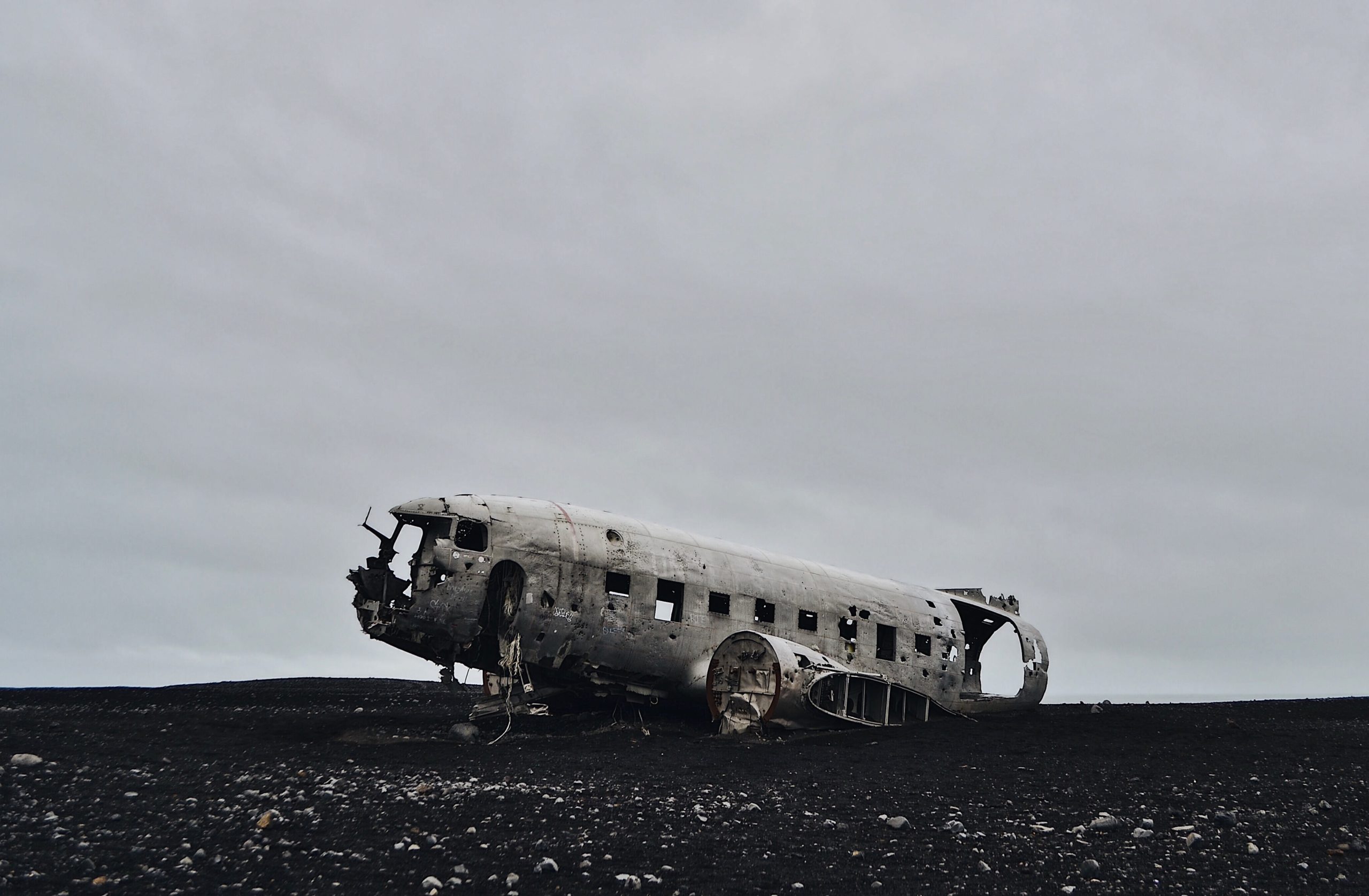
Once upon time, the graffiti-strewn, bullet-ridden fuselage found in South Iceland’s biggest desert operated as part of an entire Douglas Dakota, one of the four propeller-engine aircraft then stationed at US naval base Keflavik.
Many articles and blogs cite the wreckage as having once belonged to a fully operational Douglas DC-3. In fact, these particular models were modified to improve landing and flight stability, thus were officially known as either Super DC-3s or Douglas C-117s. (‘DC’ stands for ‘Douglas Commercial.’)
The four aircraft at Keflavik were all veteran machines of the Korean and Vietnam wars, though similar models stationed elsewhere had flown as early as the Second World War. However, it was in Iceland their service came to an end, with three planes out of the four damaged during routine take-offs.
Of course, a far more dramatic end would meet the last plane; one that, in decades to come, would cement it forever as one of Iceland’s most recognisable visitor attractions.
PLAN YOUR JOURNEY
Travelling to Iceland?
Check our overnight tours with a driver guide that includes a one night stay in a bubble.
*Starting from ISK 59.900 per person
How did the Iceland plane wreck crash?
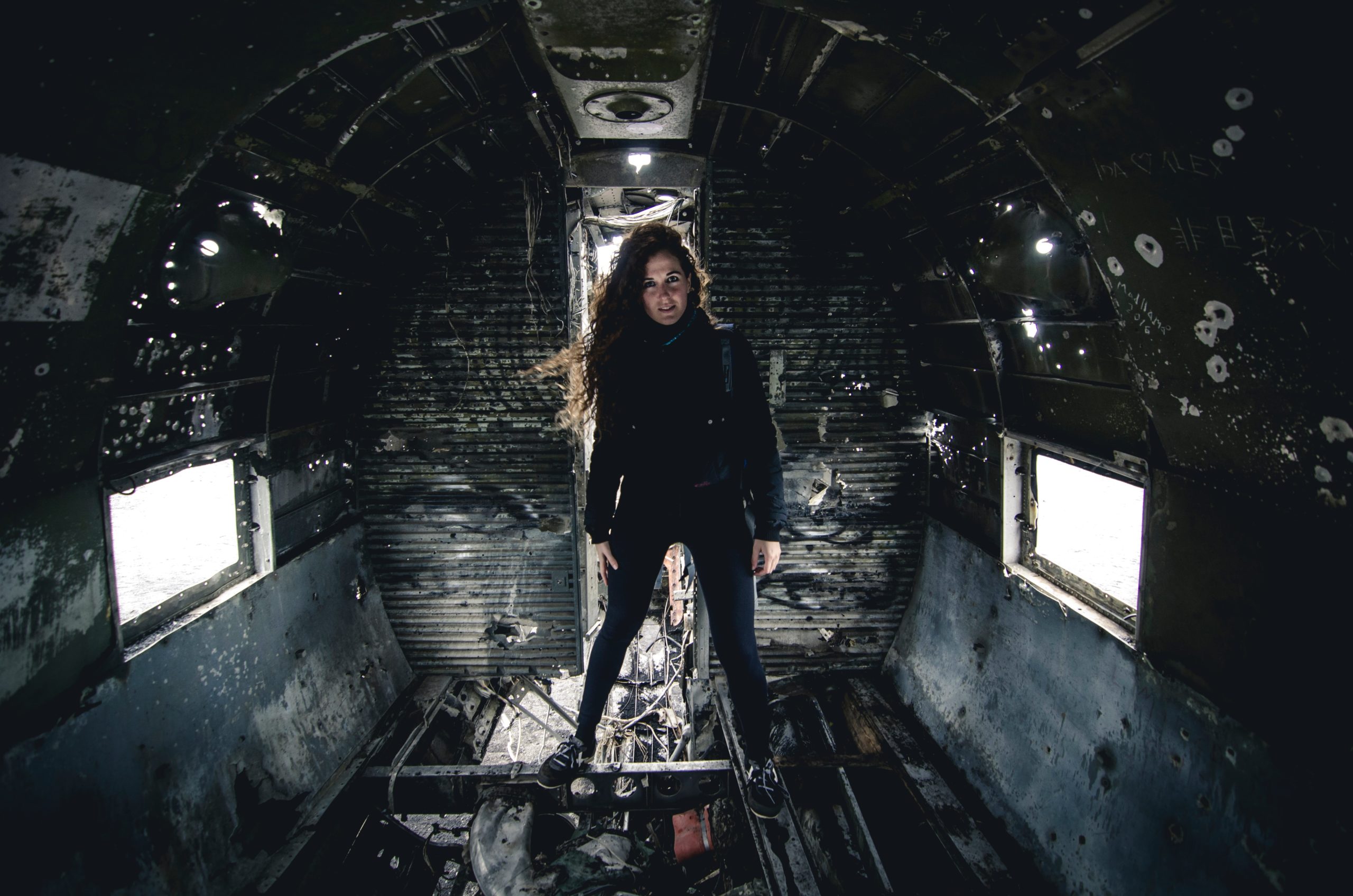
The date was 21st November 1973; Captain James Wicke was making the return flight from Hornafjörður to Keflavik, having just delivered equipment to a US Radar Station located on the Stokksnes Peninsula. Beside him was his co-pilot Gregory Fletcher—fresh from training with only 21 hours of flight time under his belt—and three other crew members.
Everything about the flight was business as usual until it wasn’t, and there are a few theories as to what exactly caused the accident. One hypothesis is that the crew encountered an ice storm over the South Coast, forcing them to crash land. Another argues that pilot error was the likeliest factor, especially given the rumours that someone switched fuel tanks prematurely.
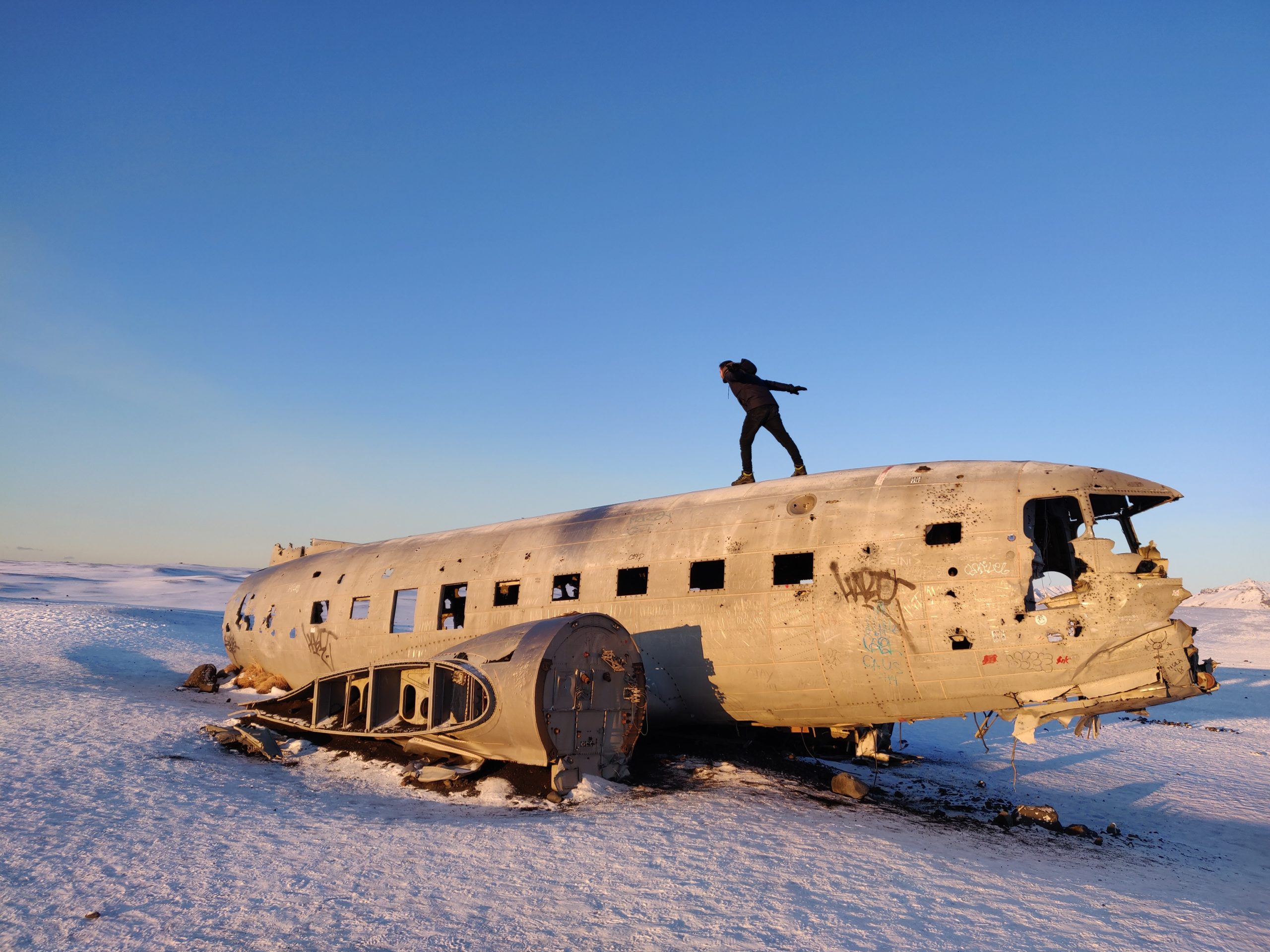
In all likelihood, it was probably a combination of all these factors that led to the crash. The mystery, while somewhat frustrating, is also a massive part of what makes this wreckage so alluring.
A quick check online will demonstrate that most sources are not even entirely sure when the crash happened, which is baffling considering the cost and potential tragedy such an incident could have inferred.
Whatever the case, it became apparent to Wicke and Fletcher that crash-landing the aircraft was an inevitability rather than an option. With their vision hampered by mist and fog, it was the co-pilot who decided to navigate their route towards the ocean, justifying it on the belief that the crew would more likely survive than if they were to attempt to touch down on land.
While his intentions were good, there was no reaching the water in time. With only minutes to observe the landscapes below them, Wicke directed the aircraft down towards a dry riverbed, one of the many that cut through Solheimassandur like emaciated veins.
Such control is staggering under the conditions, especially considering the fog was so poor that the crew could not see the aircraft’s wingtips throughout the majority of their descent.
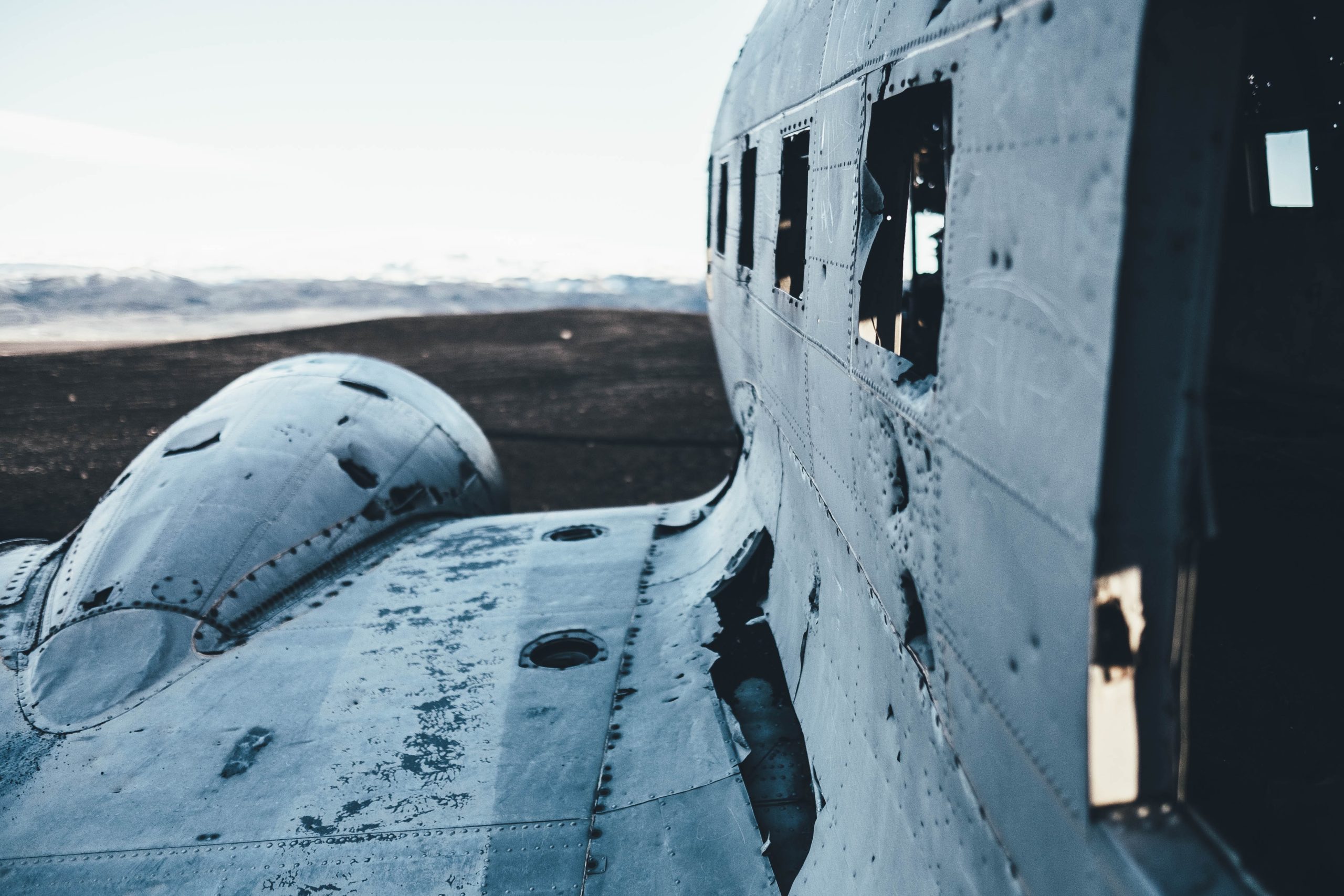
We can only imagine the terror, breathless adrenaline and sheer will-to-live that must have come over each crew member that fateful night. We know for sure the plane came to a stop, some 18 metres from where the waves break against the shore. Without missing a beat, the crew evacuated into a bleak and barren wilderness, an environment that offered little comfort beside the sweeping relief that comes with a new lease on life.
It is a point that is worth clarifying. Every single member of the Douglas C-117’s crew would survive the ordeal without any significant injuries. With that in mind, it is hard not to appreciate the wreckage today as a makeshift monument to luck and life’s blessings. Eventually, the military sent a helicopter to pick up the five survivors while the wreck and debris were written off.
For decades afterwards, the local Icelandic people considered the wreckage to be more of a historical novelty than a site worthy of international fascination. Before the tourist boom of 2010, there was even discussion about removing it because many perceived the wreckage as an unwelcome addition to the otherwise pristine South Iceland environment. Given its enduring popularity, that seems unlikely ever to happen now.
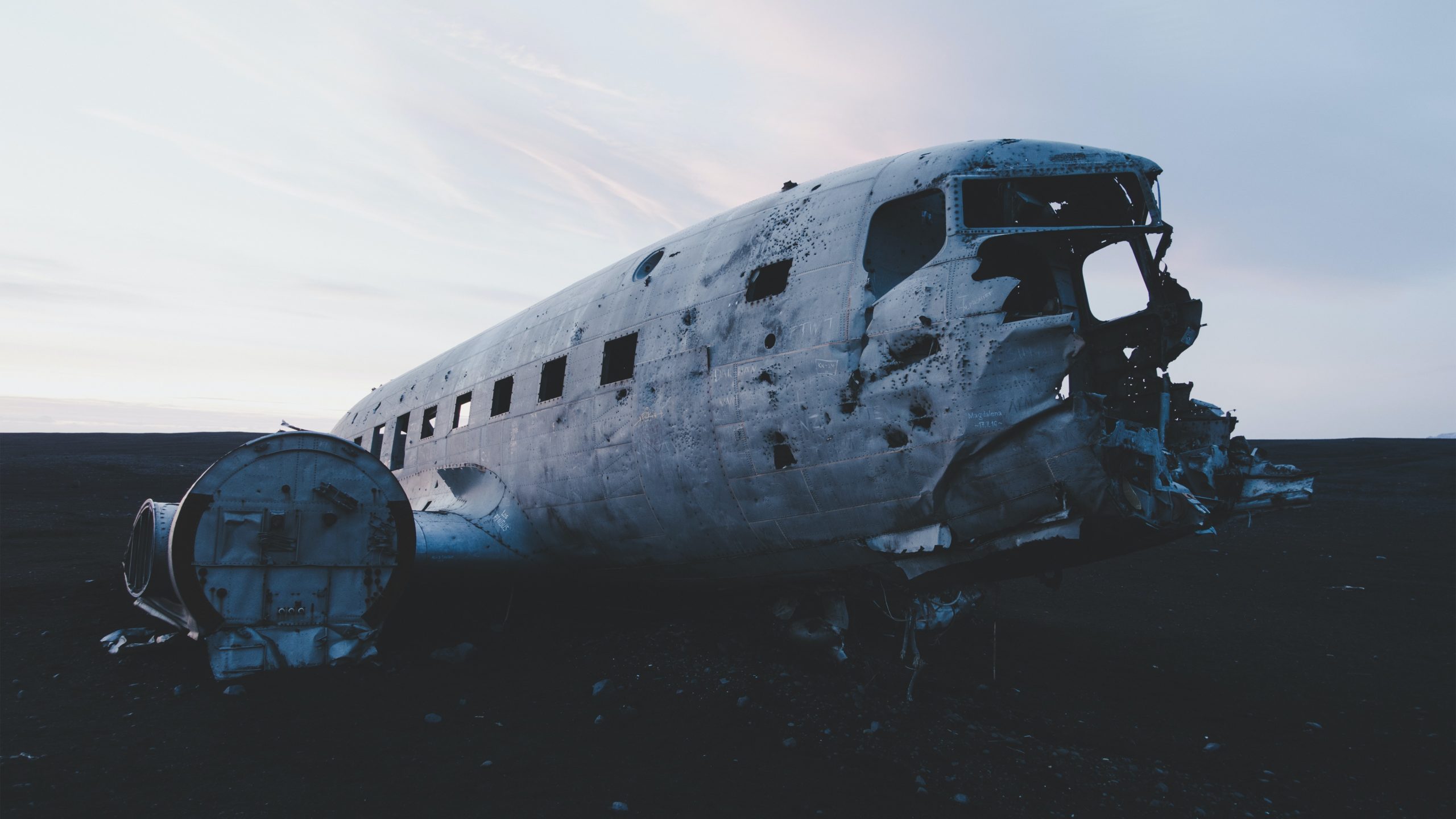
We can only imagine the terror, breathless adrenaline and sheer will-to-live that must have come over each crew member that fateful night.
We know for sure the plane came to a stop, some 18 metres from where the waves break against the shore. Without missing a beat, the crew evacuated into a bleak and barren wilderness, an environment that offered little comfort beside the sweeping relief that comes with a new lease on life.
It is a point that is worth clarifying. Every single member of the Douglas C-117’s crew would survive the ordeal without any significant injuries. With that in mind, it is hard not to appreciate the wreckage today as a makeshift monument to luck and life’s blessings. Eventually, the military sent a helicopter to pick up the five survivors while the wreck and debris were written off.
For decades afterwards, the local people considered the Iceland plane wreck to be more of a historical novelty than a site worthy of international fascination.
Before the tourist boom of 2010, there was even discussion about removing it because many perceived the wreckage as an unwelcome addition to the otherwise pristine South Iceland environment. Given its enduring popularity, that seems unlikely ever to happen now.
How to get to the Iceland plane wreck?
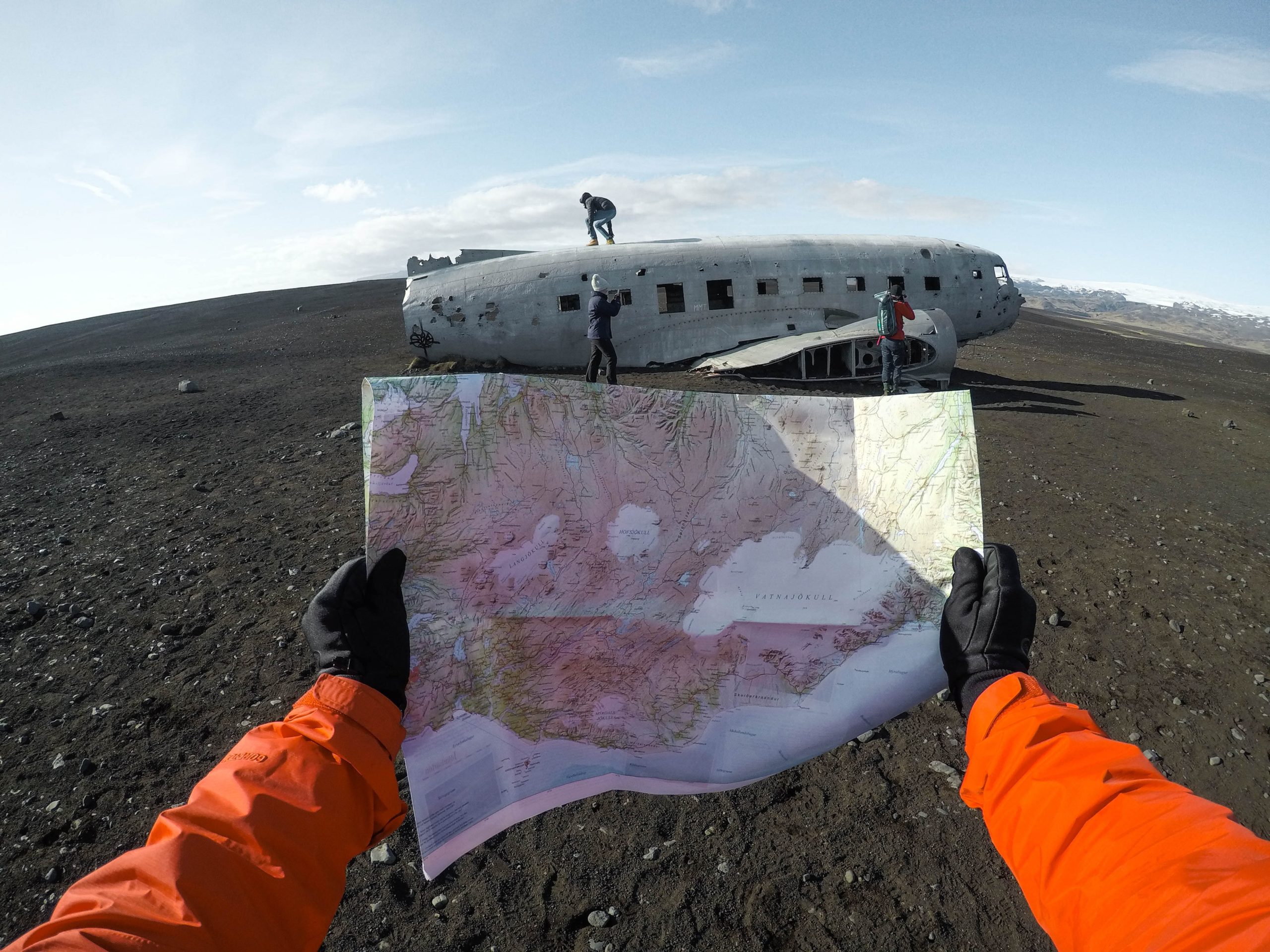
The Iceland plane wreck is one of the country’s most recognisable visitor attractions—despite never having been intended as one—so naturally draws an eager crowd throughout the year. Its fame is thanks to numerous media appearances, most notably in the accompanying video for Justin Bieber’s track “I’ll Show You,” countless commercials, artworks and even a Bollywood film.
Unlike many of this country’s primary point of interests, the DC plane wreck cannot be easily accessed, requiring a hike through the vast expanse of Solheimasandur.
The car park from which you’ll depart for the hike is south of Route 01 between the remote seaside village, Vík í Mýrdal, and the stunning Skógar waterfall. This parking bay is easy to find when heading eastward towards Vik; you’ll locate it right after crossing over the Jökulsá á Sólheimasandi river.
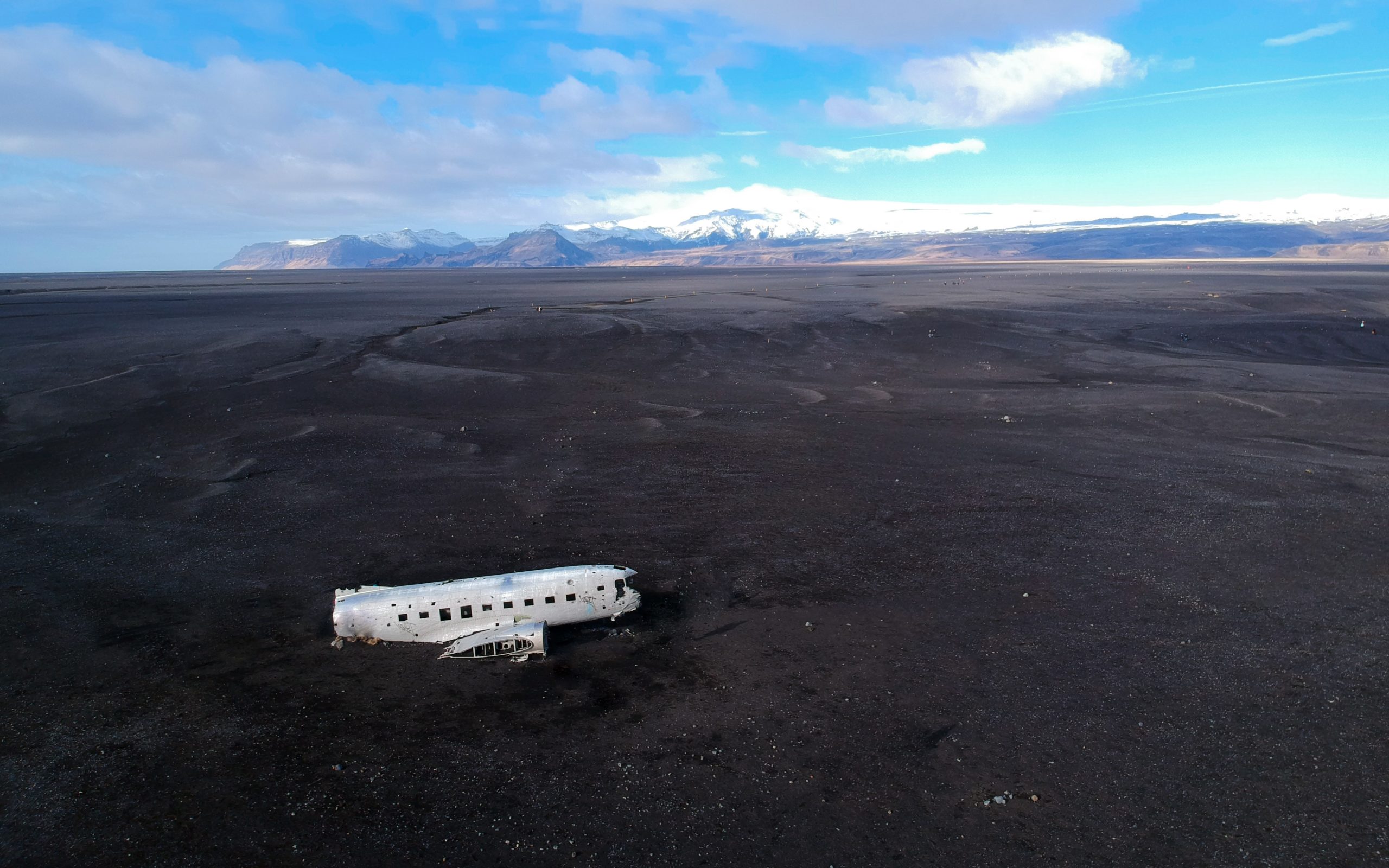
It is essential to realise that hiking the trail should not be permitted during the wintertime without a professional guide’s expertise.
Not unlike what happened to the Iceland plane wreck’s crew, the desert can quickly be overwhelmed with thick fog and battering winds, transforming what should be a simple hike into a dangerous ordeal that must be endured and survived.
One cannot accuse yours truly of embellishing the facts for dramatic effect. Only last year, two visitors lost their lives here when they became lost en route. This event, while tragic, did not come as a surprise to the Icelandic Rescue Services, who are regularly called out to help those who overestimated their ability to cope with a hostile environment.
Those with the technological know how to pinpoint its geographical location can find the DC plane wreck at the following coordinates: 63 27.546-19 21.887.
Nearby attractions to the DC Plane Wreck?
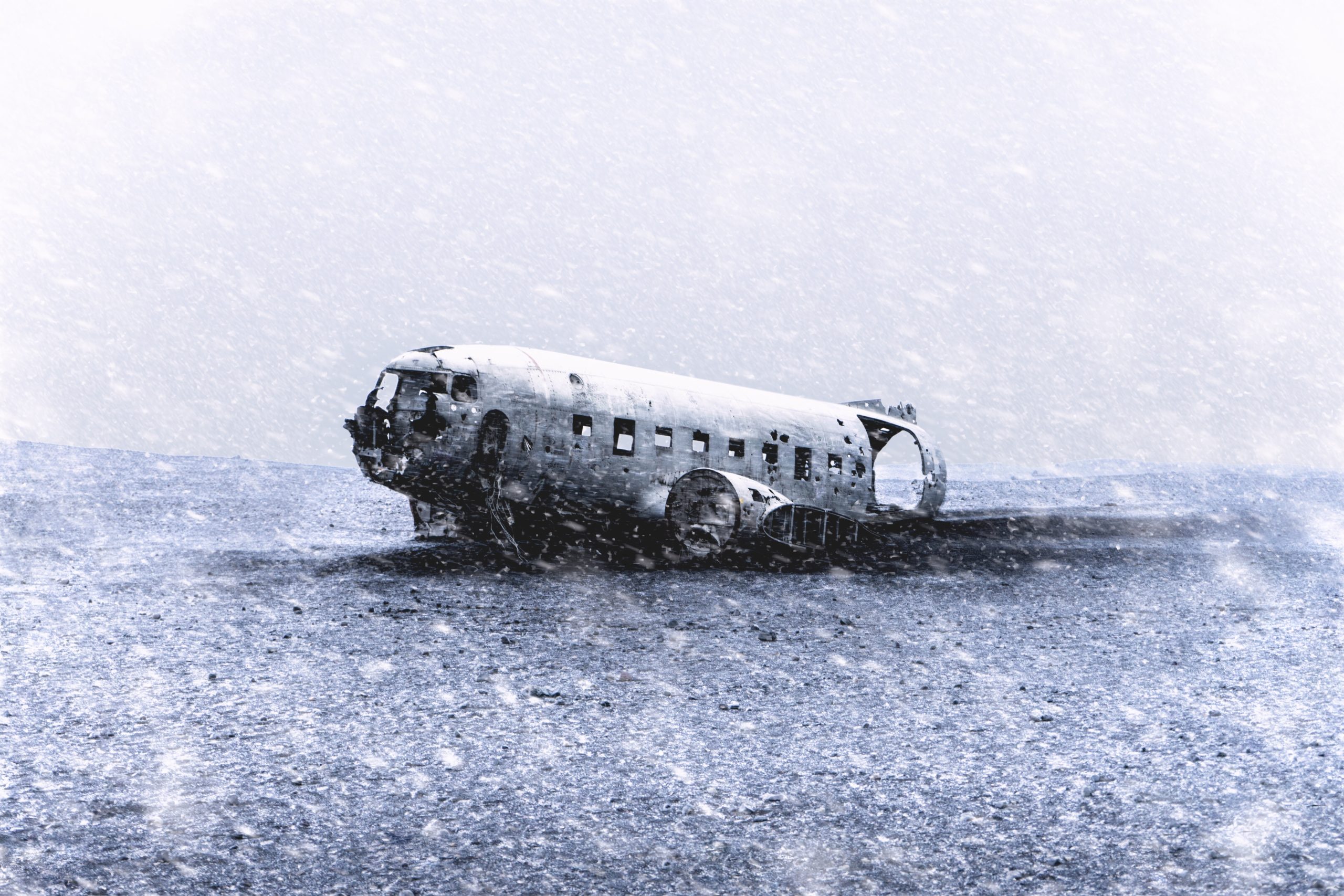
Despite being found in the desert, the DC Plane Wreck is only a short car ride away from many other natural attractions that make South Iceland famous. For those heading east on the Ring Road from Reykjavik, numerous delights await en route before even arriving at this novel crash site.
The waterfalls Seljalandsfoss and Skogafoss both make for exciting stops and can be easily accessed from the road. Watching glacial water plummet dramatically over the cragged lip of an ancient sea cliff is something that can’t help but stir some emotion.
Further along, guests driving 4×4 vehicles should pay a visit to the scenic promenade, Dyrhólaey, famous for its historic lighthouse and gargantuan rock arch. Looking from this promontory’s cliff sides, diverse with nesting seabirds, you’ll have fantastic views over the dark shorelines of the South Coast.
From Dyrhólaey, guests are also privy to Reynisfjara black sand beach, recognisable the world over thanks to its volcanic pebbles and the iconic basalt rock stack, Reynisdrangar. Most visitors will stop by here alongside the neighbouring village, Vik I Myrdal, which is a great place to browse souvenirs or grab a bite to eat.
After crossing the Solheimasandur desert, where the DC Plane Wreck lies, the towering, snow-capped peaks of Vatnajokull National Park will rise over the horizon before you. Within this lush glacial oasis, guests will discover Jökulsárlón
Glacier Lagoon and Diamond Beach’s exquisite aesthetic.
Beyond that is the Eastfjords, marking an end to the South Coast sightseeing route. Still, we’ve covered plenty for you to do in the meantime, of which visiting the DC plane wreck will surely be among the top priorities.
PLAN YOUR JOURNEY
Travelling to Iceland?
Check our overnight tours with a driver guide that includes a one night stay in a bubble.
*Starting from ISK 59.900 per person
27 Fun Facts About Iceland
26 Fun Facts About Iceland
By Michael Chapman
How much do you know about the land of ice and fire?
26 Fun Facts About Iceland
By Michael Chapman
How much do you know about the land of ice and fire?
Iceland is a place like no other. Boasting a natural beauty that is both homely and alien and a cultural history rich with fascinating titbits and quirks, this island draws such phenomenal interest that it has reached almost mythic status.
No wonder then that fun facts about Iceland articles are ten-a-penny…
But how much does one really know about this place besides being able to recognise it from widely-shared photographs and videos? What makes the Icelanders tick, and how has living in this strange and beautiful land shaped their national character?
Without further ado, let’s take a look at 26 fun facts about Iceland.
26 Fun Facts About Iceland
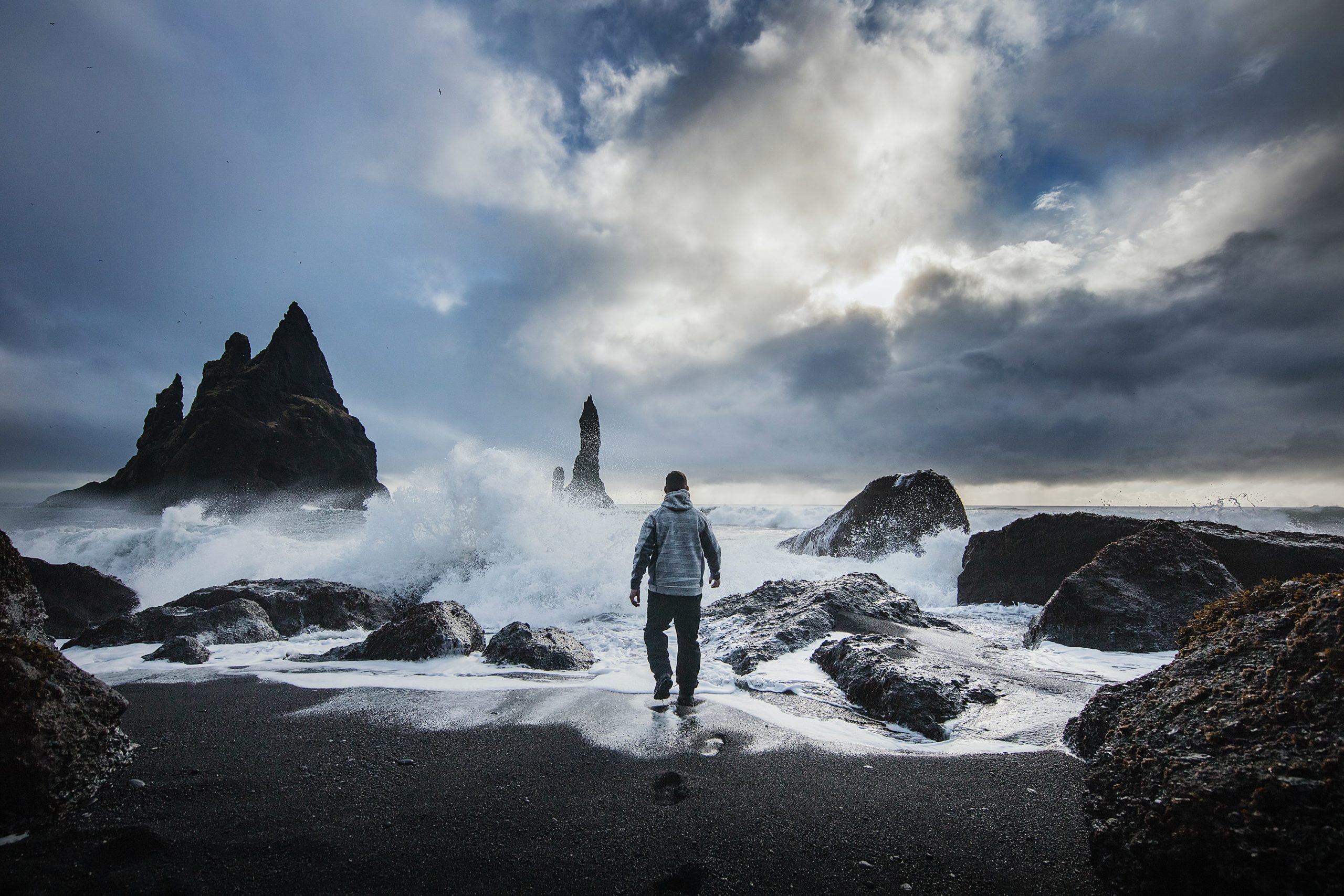
1) Iceland’s only native mammal is the Arctic Fox, thought to have crossed over from mainland Europe during a former ice age. Throughout this period, it is thought there were sufficient ice floats between the continent and Iceland so as to make migration population. Similar events sometimes occur with Polar Bears from neighbouring Greenland, though Arctic Foxes have long been able to sustain themselves on the island’s rich bird population.
2) The word Jólabókaflóð means Christmas Book Flood, and refers to that festive end of year period where Icelanders publish hundreds of new books, ready for reading over the holidays. Icelanders are incredibly passionate about literature, with roughly one in ten people will have published a book during their lifetimes.
3) Most local people can trace their lineage back to the Viking Age thanks to the Islendingabok, the Book of Icelanders, a meticulous online record of each generation. Thanks to a nationwide collection of surveys, obituaries and court documents, Icelanders can now trace their family back hundreds of years with a quick check of the internet.
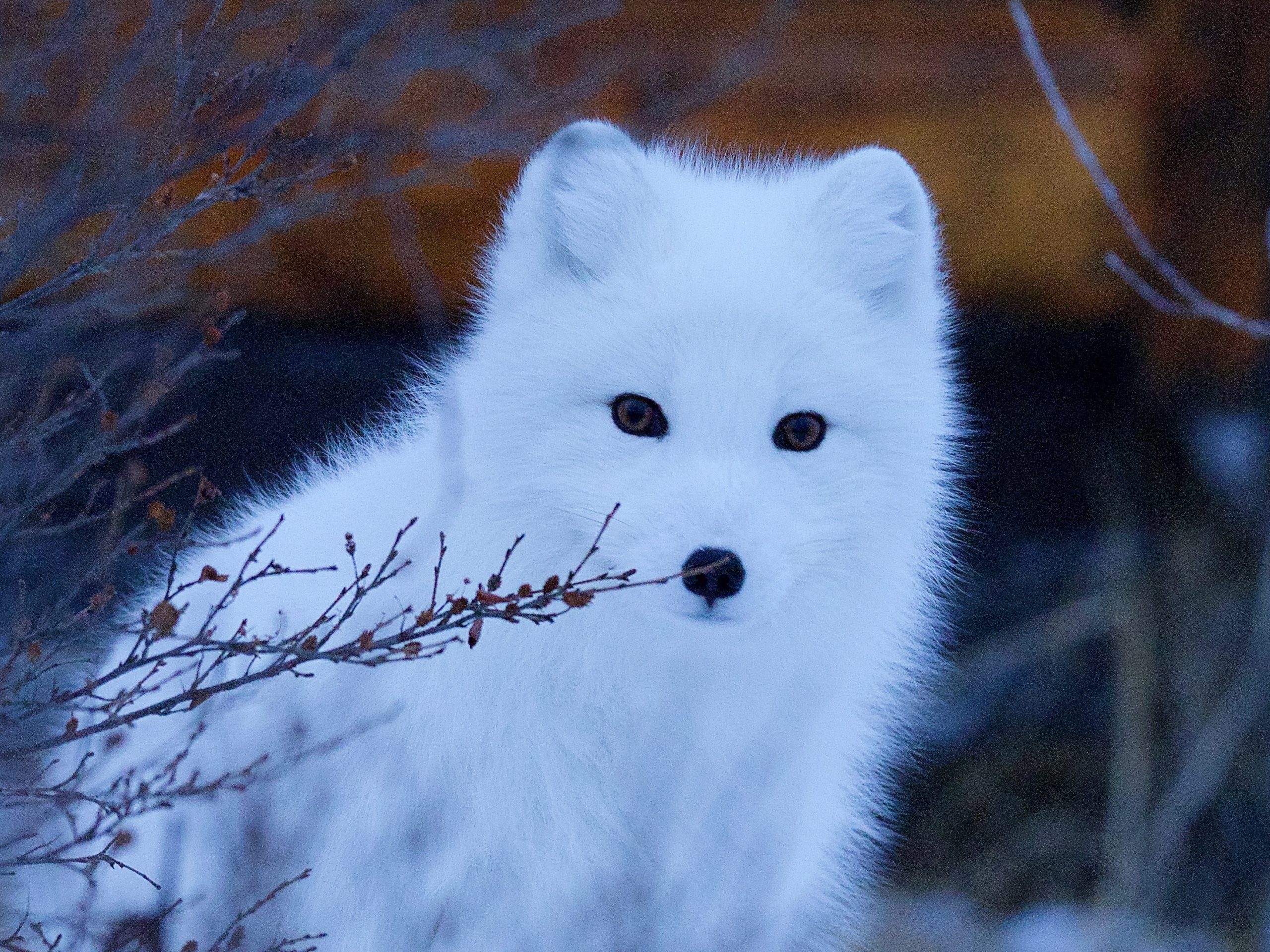
4) Iceland is a volcanic island with over 130 active volcanoes. The largest is Bárðarbunga, which can be found in South Iceland’s Vatnajökull National Park.
5) Any Icelandic horse that leaves the country is forever forbidden to return; such are the strict protocols that regulate breeding in Iceland. The Icelandic horse is among the world’s purest bred breeds, having been isolated for over 1000 years. Icelandic horses are small and muscular in stature and are capable of performing five unique gaits.
6) Beer was illegal in Iceland until 1989. While those abroad necked golden pints without ever considering doing otherwise, Icelanders were forced to make do with home-brewed spirits, as well as any other alcoholic treasure smuggled in.
PLAN YOUR JOURNEY
Travelling to Iceland?
Check our overnight tours with a driver guide that includes a one night stay in a bubble.
*Starting from ISK 59.900 per person

7) Iceland is said to have the world’s oldest parliamentary documentary, the Althing, which formed amid the lava rocks and exposed tectonic plates of Þingvellir in 930 AD.
8) Visitors can find Europe’s largest glacier in Iceland. Known as Vatnajökull (“Water Glacier”), this enormous force of nature covers approximately 8% of the country’s total landmass, swallowing valleys, mountains and volcanoes beneath its dense layer of ice.
9) Iceland does not possess an army, air force or navy, instead relying on the defence capabilities of NATO (North Atlantic Treaty Organisation). It does, however, have a coast guard which has previously seen action in a series of conflicts with the United Kingdom known as ‘The Cod Wars’. Iceland emerged as the victor of this dispute over fishing rights, and no one has dared challenge this fearsome Viking nation since.
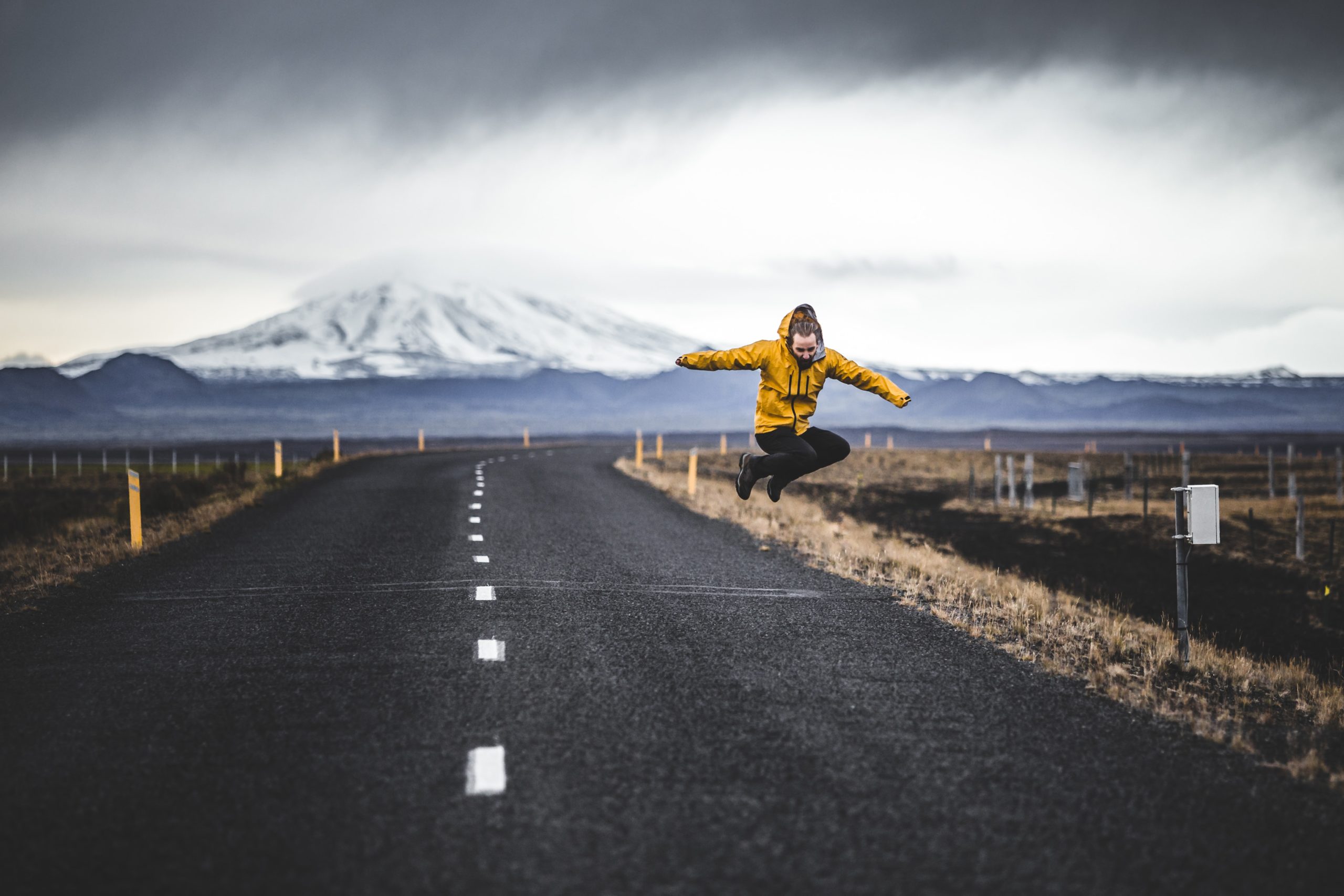
10) The Icelandic language is relatively unchanged from Old Norse, which has been spoken on this island for over a thousand years. Icelanders will often merge terms to describe new words, creating portmanteaus that are as striking as they are creative. For instance, the word for ‘computer’, which is tolva, can be translated to ‘Numbers Witch.’
11) There are only two places on earth that do not have mosquitoes; Antarctica and Iceland. There are also no snakes, scorpions or poisonous spiders, which can be some relief when weighing up where in the world to visit next.
12) Iceland is a popular shooting location for Hollywood productions. Ridley Scott used the waterfall Dettifoss in his Alien-prequel, Prometheus, while the black sand beaches of the south provided an interstellar backdrop for Star Wars: Rogue One. Game of Thrones also used several locations in Iceland, many of which can be found nearby South Iceland’s Golden Circle sightseeing route.

13) There is not a single McDonald’s restaurant to be found in Iceland. The most popular fast food here is Domino’s pizza, swiftly followed by KFC, though Subway operates more stores than any other franchise. Those who can’t imagine staying somewhere where beef patties aren’t readily available, Icelandic fast-food chains, including Aktu Taktu and Tommi’s Burger, can all help temper that craving.
14) According to the latest surveys, only 31% of Icelanders now believe in elves, or Huldufolk (“Hidden Folk”). With that said, the number of those who would not willingly speak out against Iceland’s elves is far more extensive. To this day, certain areas are still considered linked to the elves, so they must be avoided when laying roads and infrastructure.
15) Iceland had the first elected female head-of-state, Vigdís Finnbogadóttir, who held office as President between 1980 to 1996. Iceland was also where the first elected openly-gay prime minister, Jóhanna Sigurðardóttir, attempted to repair the fallout of the financial collapse that occurred one year prior to her taking the role.
16) Iceland is among the few places on the planet where one can witness the Northern Lights in action. According to local folklore, if two lovers conceived a baby beneath the auroras, then it would likely be born cross-eyed. (Just a word of warning for visiting couples looking to get close beneath this cosmic light show).
17) Most native Icelanders do not have surnames but instead have patronymic and matronymic last names. If you were to lookup an Icelandic person in the local telephone registry, you would have to rifle through the first and middle names to locate them. Parents can only choose their child’s name from a list compiled by the Icelandic naming committee, an issue that has caused some division in local politics in the past.
18) The towering rock faces of Látrabjarg, located in the remote and ancient Westfjords region, marks Europe’s tallest bird cliffs, as well as its westernmost point. Visitors can spot many species here including the Arctic Skua, guillemots and Atlantic Puffins.
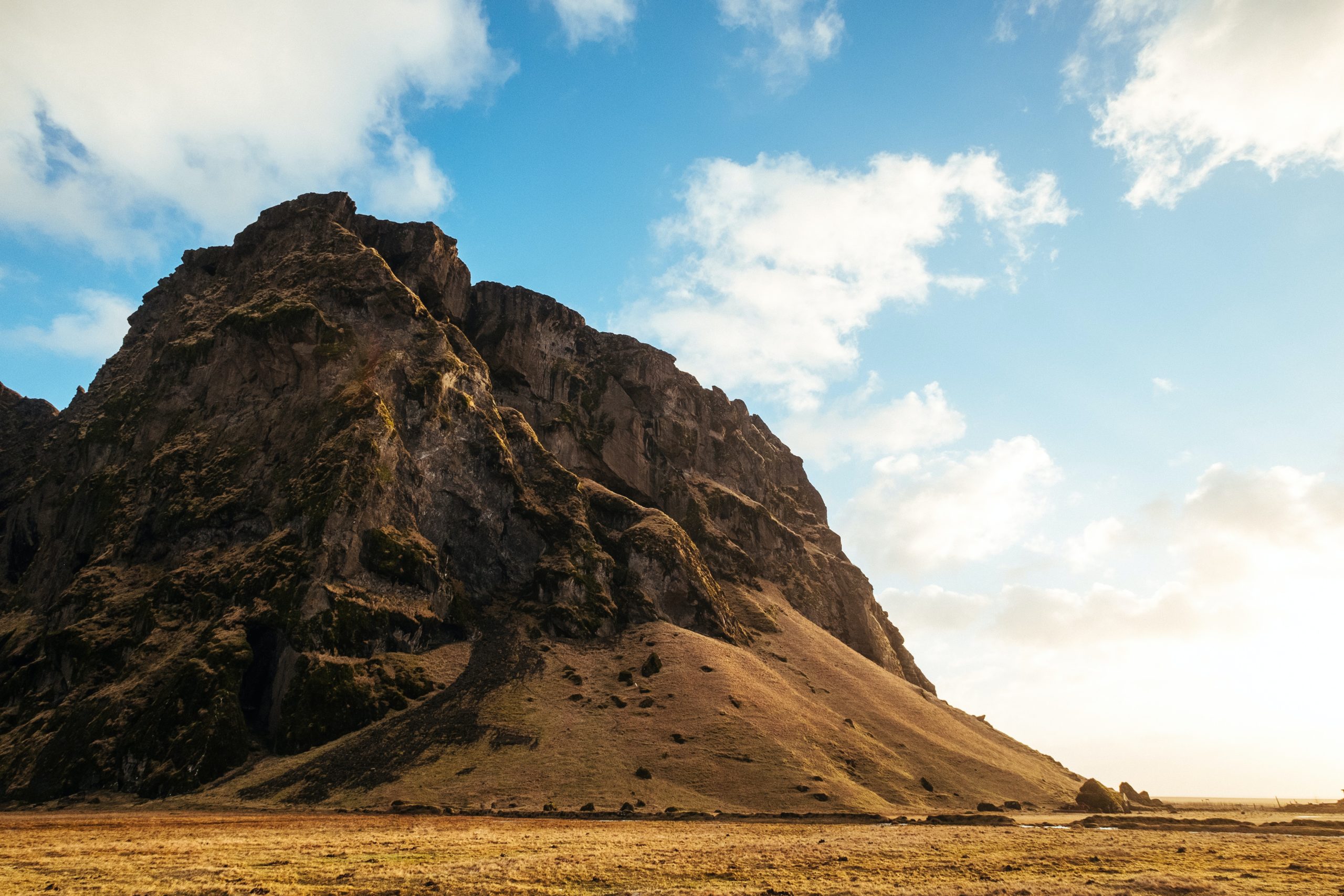
19) Icelanders have a long history of bathing in geothermal baths, and to this day, consider a visit to the swimming pool and saunas top among social activities. Beware; there are strict rules about showering naked before taking a dip, so the prudish among you should be wary. This is no joke; changing room guards regularly watch out for anyone trying to skip out on hygiene. Iceland’s oldest outdoor swimming pool, The Secret Lagoon, can be found as part of the Golden Circle sightseeing route.
20) Over two-thirds of Iceland’s 360,000-strong population live in the Capital Region. The vast majority of towns and villages in Iceland are located along the coast, with the Highlands left uninhabited. (How are these for some fun facts about Iceland?)
21) Iceland is considered at the forefront of sustainable energy, with most homes and buildings being heated through geothermal or hydro-electrical means.
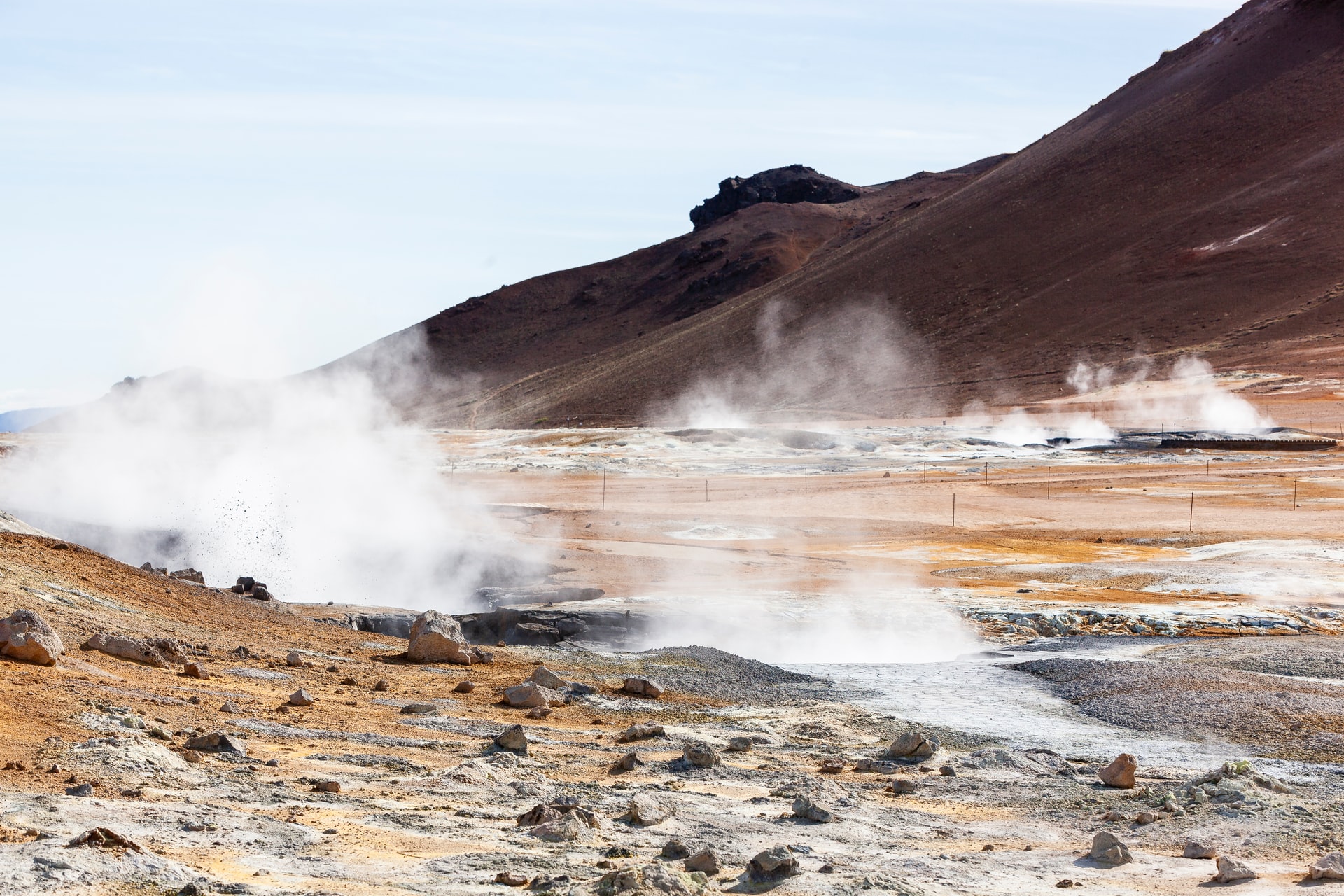
22) According to local Christmas traditions, there are 13 Santa Clauses called the Yules Lads, who bear somewhat unappealing names like “Sausage Snatcher” and “Window Peeper”. To make the holidays more uncomfortable, a giant Yule Cat stalks the countryside, ever on the hunt for children who have not been gifted clothes for Christmas.
23) Icelanders have a reputation for being beautiful specimens. The Miss World competition has seen four Icelandic champions in the run; Hólmfríður Karlsdóttir, Linda Pétursdóttir and Unnur Birna Vilhjálmsdóttir. Guðrún Bjarnadóttir, paved the way for those who would come after, having won Miss International in 1963.
24) Icelanders are also known for their strength. The World’s Strongest Man’s Hall of Fame has only six members as of 2020, with two of them from Iceland; Magnus Ver Magnusson and Jon Pall Sigmarsson. Another strong man of note is Hafthor Julius Bjornsson, who, aside from having won the World’s Strongest Man, famously played The Mountain in Game of Thrones.
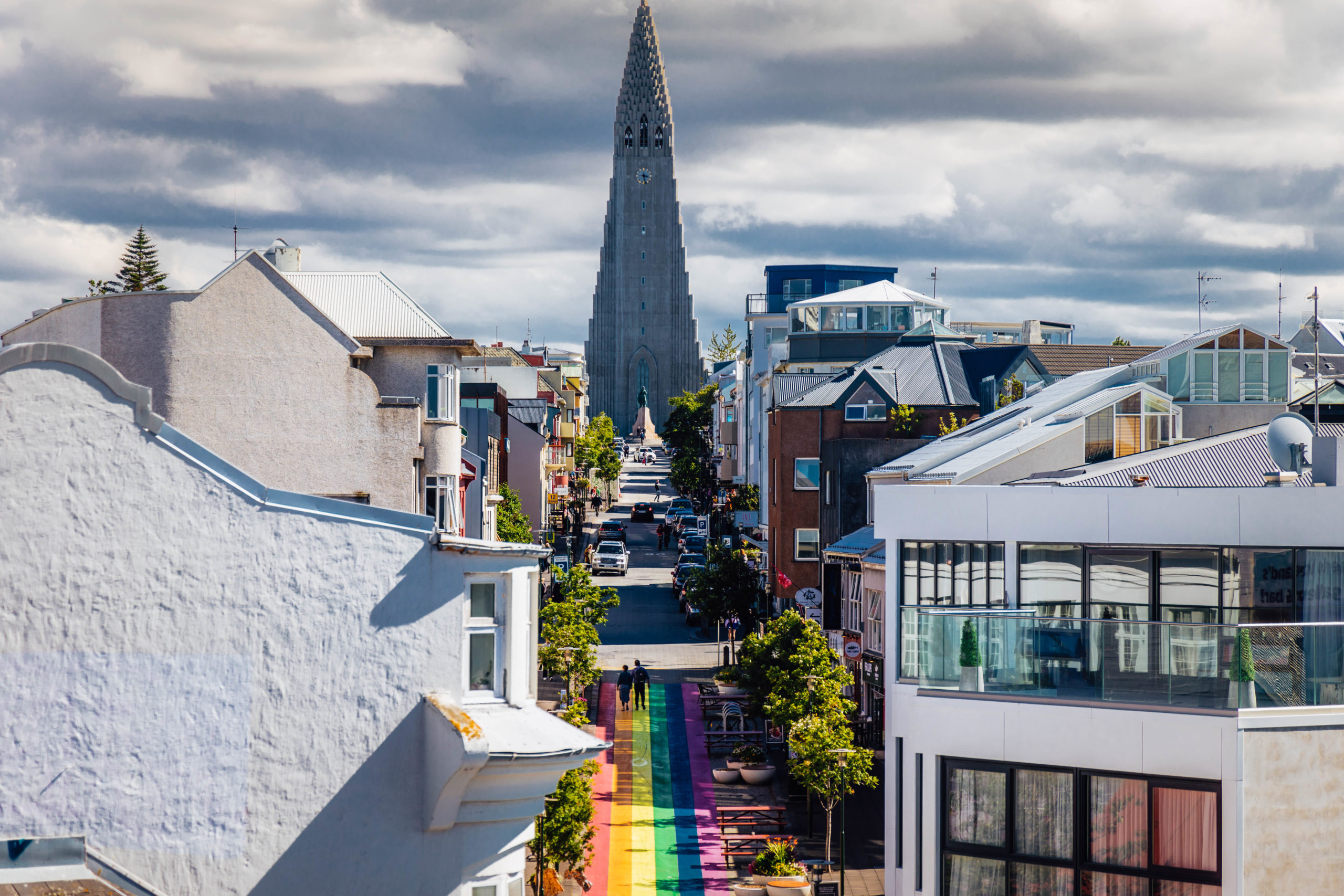
25) When counting only those of sovereign states, Reykjavik is the planet’s northernmost capital. The city is relatively temperate throughout much of the year, though the winter is often a different story altogether.
26) On the Westman Archipelago, south of the Icelandic mainland, guests can observe the world’s largest puffin colony. These tiny tuxedoed birds arrive en masse during the summer, leaving behind their solitary lives on the waves. There are an estimated 8 – 10 million puffins in Iceland throughout this period, which accounts for roughly 60% of the earth’s population.
27) During the summer, Iceland experiences up to 24 hours of daylight, courtesy of the Midnight Sun. Such a wealth of sunlight allows for guests to spend much longer on the road, as well as enjoy natural sites and attractions well into the night.
If you are looking to learn more fun facts about Iceland, we suggest checking some of our feature articles. Should, for instance, you be looking to know about the auroras, then The best places to see the Northern Lights in Iceland will surely be a fine companion.
Alternatively, if the sightseeing, or any other attraction in South Iceland, has piqued your interest, might we direct you towards The Golden Circle in Iceland | All You Need to Know. Even About Iceland’s Breathtaking Black Sand Beach has plenty of fun facts about Iceland worthy of reading!
Whatever side of this island has you longing to know more, nothing can substitute a real visit; appreciating the people’s friendliness, the drama and poetry of the landscape, the fresh air and wide-open spaces is all something that guests must experience first hand.
Fun facts about Iceland can only get you so far. Nothing compares to the real thing.
PLAN YOUR JOURNEY
Travelling to Iceland?
Check our overnight tours with a driver guide that includes a one night stay in a bubble.
*Starting from ISK 59.900 per person
Your Perfect Iceland Honeymoon | Stay in a Bubble
Your Perfect Iceland Honeymoon | Stay in a Bubble
By Michael Chapman
Connect with nature and each other at this novel accommodation choice in South Iceland.
Your Perfect Iceland Honeymoon | Stay in a Bubble
By Michael Chapman
Connect with nature and each other at this novel accommodation choice in South Iceland.
When two people fall madly for one another, it is said that they enter what’s called a ‘love bubble.’ Well, we have taken that concept and transformed it into one of the most alluring overnight stays guests can book when visiting this gorgeous country—a transparent bubble!
Newlyweds looking for the perfect Iceland honeymoon need look no further than our two prime locations in South Iceland. Each Bubble is inflated in much the same way as a child’s bouncy castle, then heated and decked out with a comfortable bed to make sure your shared stargazing is an experience to remember.
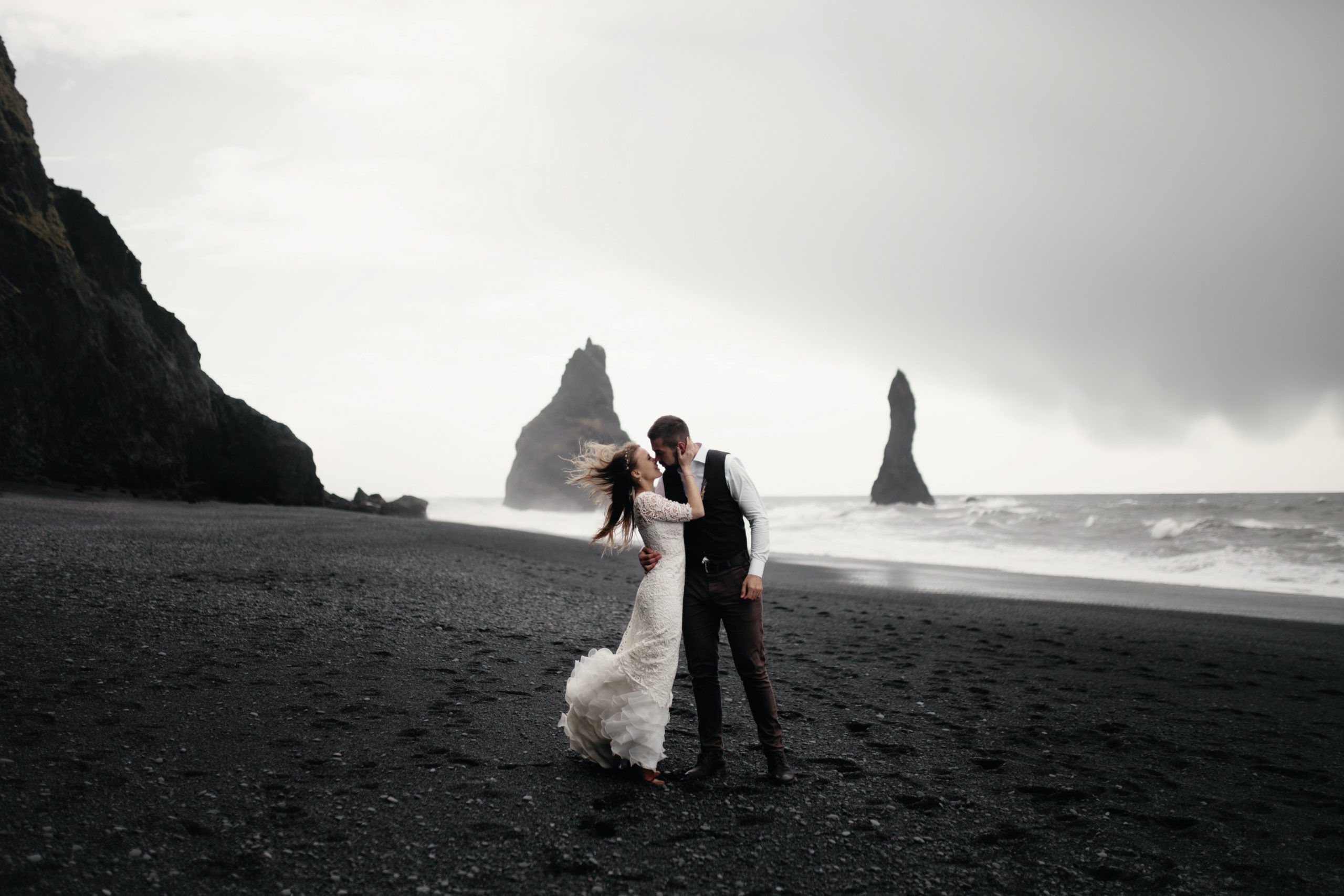
Just before arrival, you’ll both be informed where you are staying, leaving the element of surprise intact—important for any long-term relationship. With that, your Iceland honeymoon will be off to a flying start, the beginning of an adventure that will be remembered for years to come.
Whichever Bubble site is chosen for your Iceland honeymoon, your accommodation will be close by to the many attractions and activities that make the south so beloved by many.
Why choose Iceland as your romantic getaway?
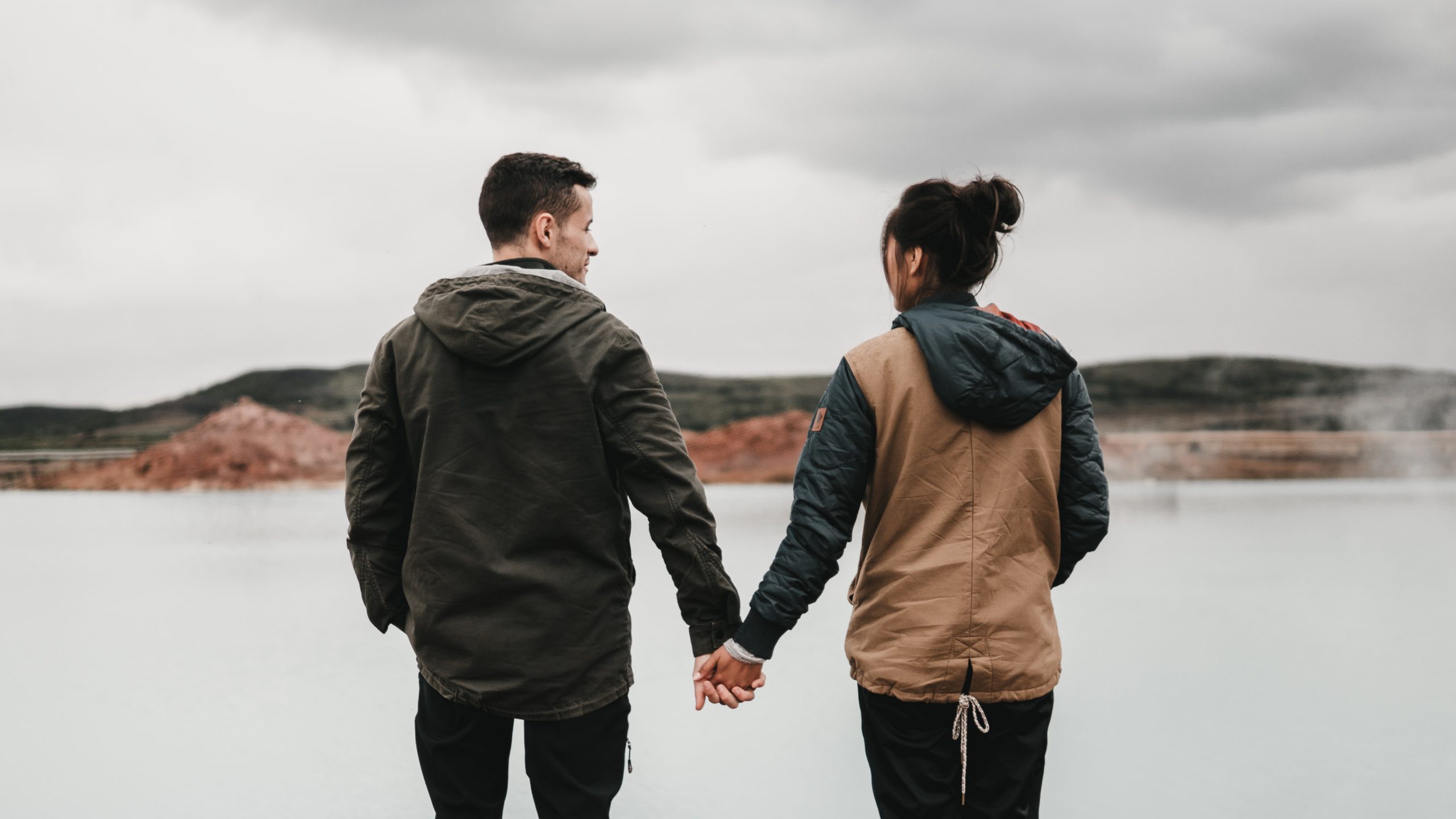
It goes without saying that Iceland is among the world’s most romantic destinations.
Enchanting waterfalls, lush valleys, bewitching black sand beaches and deserts; all await for those who seek them. Driving region to region, guests will discover how barren lava fields seamlessly merge into quaint farmlands and woodlands, all while remaining uniquely Icelandic in their character.
South Iceland, in particular, has become the favoured region for sightseeing, thanks not only to its plethora of enticing natural attractions but also its easy accessibility from the Capital Region. More than that, the south is diverse and full of life, a fantastic and eclectic region that would take days to fully explore with a partner.
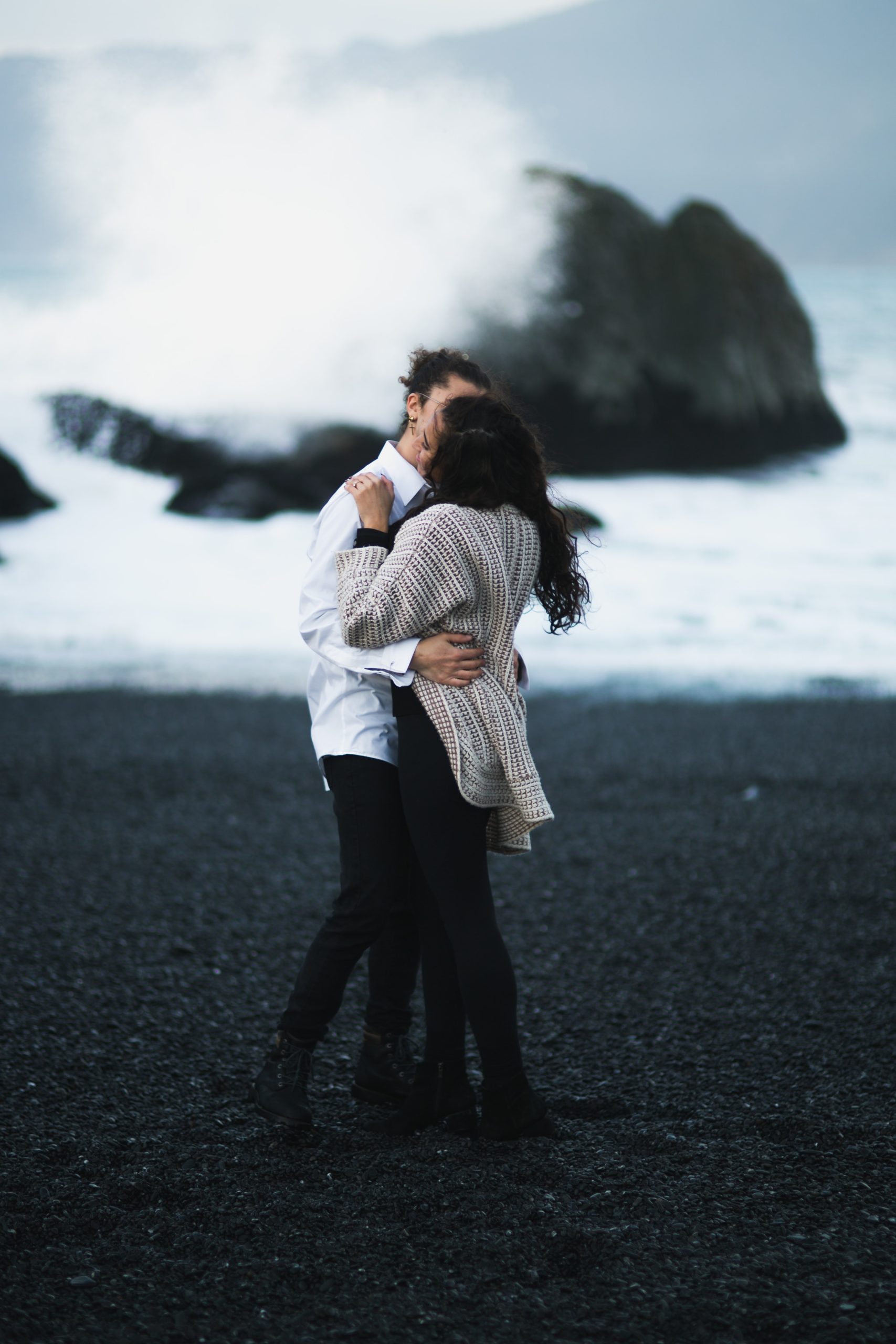
Spellbound, you and your better half will find no end of hidden secrets travelling through here. Glaciers lagoons, glittering beneath the Midnight Sun, or dark volcanic shorelines, bordered by tall cliff sides, both make for beautiful settings in which to fall in love.
So too does a vast field of moss-blanketed lava rock or a towering promenade that looks out over the Atlantic ocean’s crashing blue waves.
Whatever bend of the road one takes in Iceland, scenery and atmosphere culminate to create a destination perfect for adventurous lovers. No wonder so many people fantasise about their very own Iceland honeymoon, a fairytale getaway in a land straight out of a fantasy book.
PLAN YOUR JOURNEY
Travelling to Iceland?
Check our overnight tours with a driver guide that includes a one night stay in a bubble.
*Starting from ISK 59.900 per person
See the Northern Lights from a Bubble
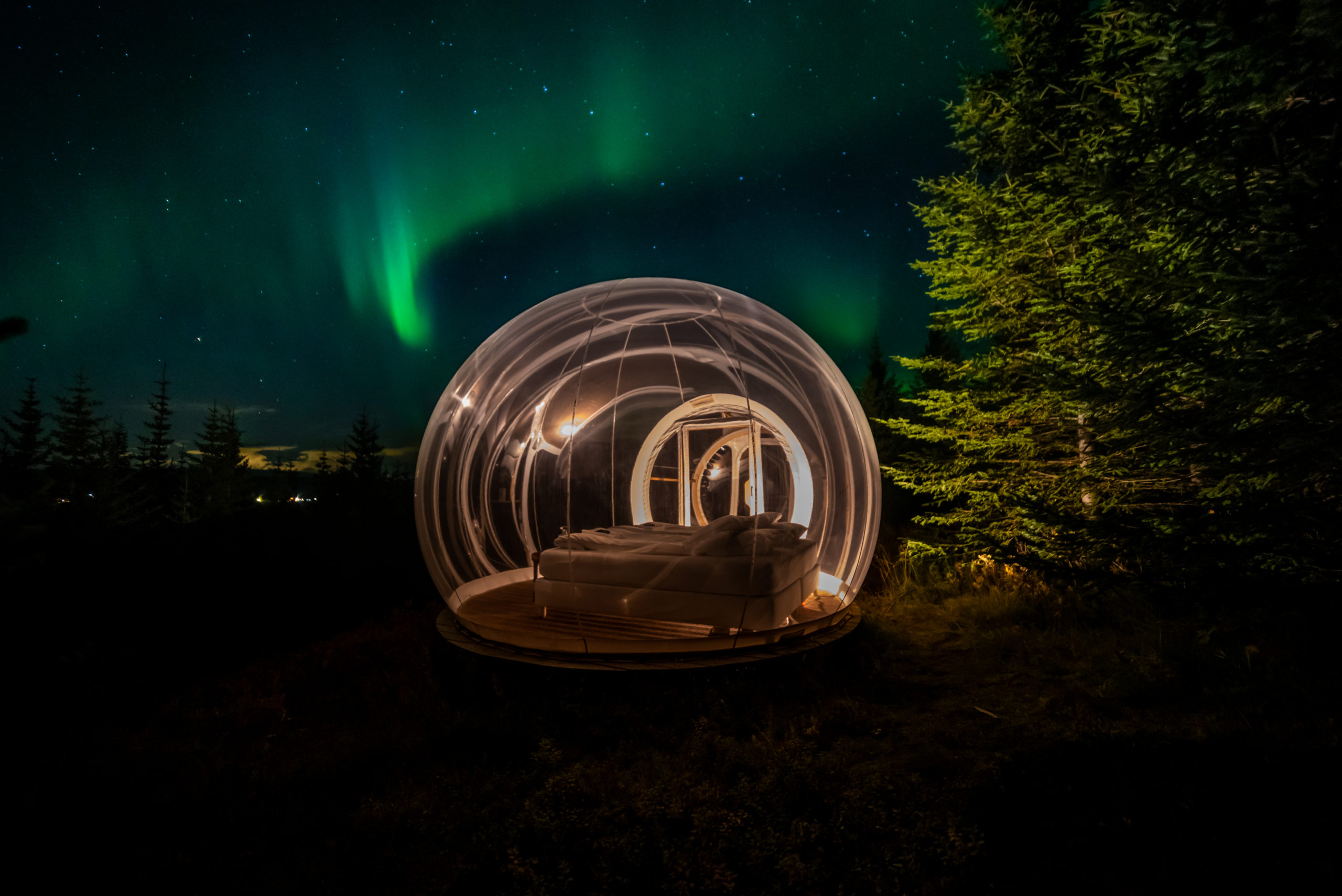
Don’t be under any illusions that Iceland won’t entrance you and your partner. In fact, it is impossible to describe that feeling of grateful connectedness that comes with experiencing this island’s nature, of which there is no more magical example than the Aurora Borealis.
Each Bubble is set some distance apart from one another to help your chances of witnessing the lights. Such positioning helps bolster the peaceful solitude of your Iceland honeymoon, maximising the silence and darkness around you.
It is at night when our Bubbles genuinely shine, offering cosmic sights that truly put it above and beyond any mere hotel or guesthouse!
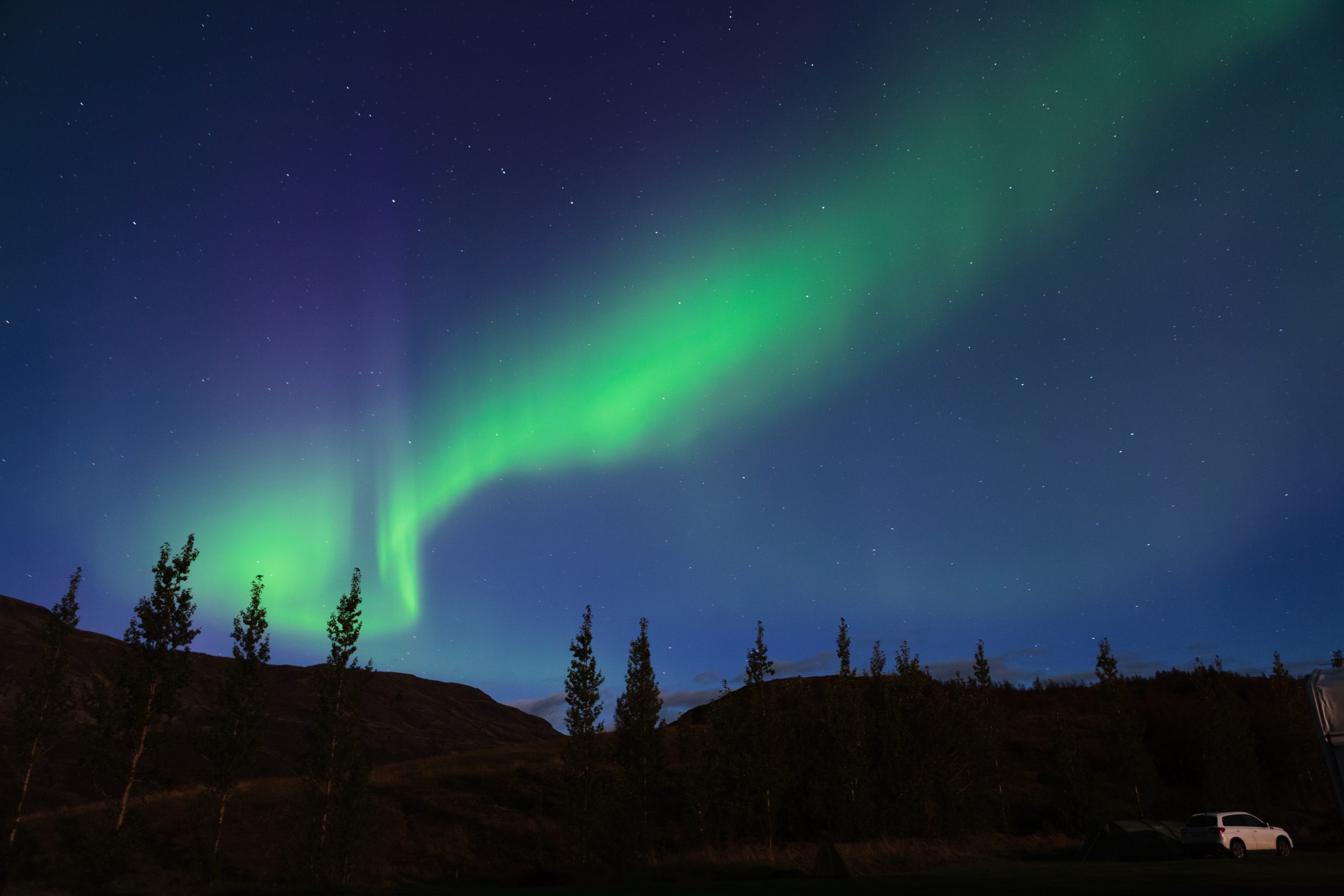
All those who have witnessed this miraculous occurrence can attest that seeing the Northern Lights is an experience like no other. In one of our bubbles, guests will have more time to observe the skies than they would if they were driving themselves or taking part in a guided tour, and that’s not to mention the cosy, comfortable surroundings of their stay.
Even on those unfortunate occasions when the auroras do not make an appearance, a vast blanket of twinkling stars will be on-hand to dazzle you; its constellations clear and mystical against the night’s jet-black sky.
They don’t call us the 5-million star hotel for nothing, after all!
Experience South Iceland’s Golden Circle sightseeing route
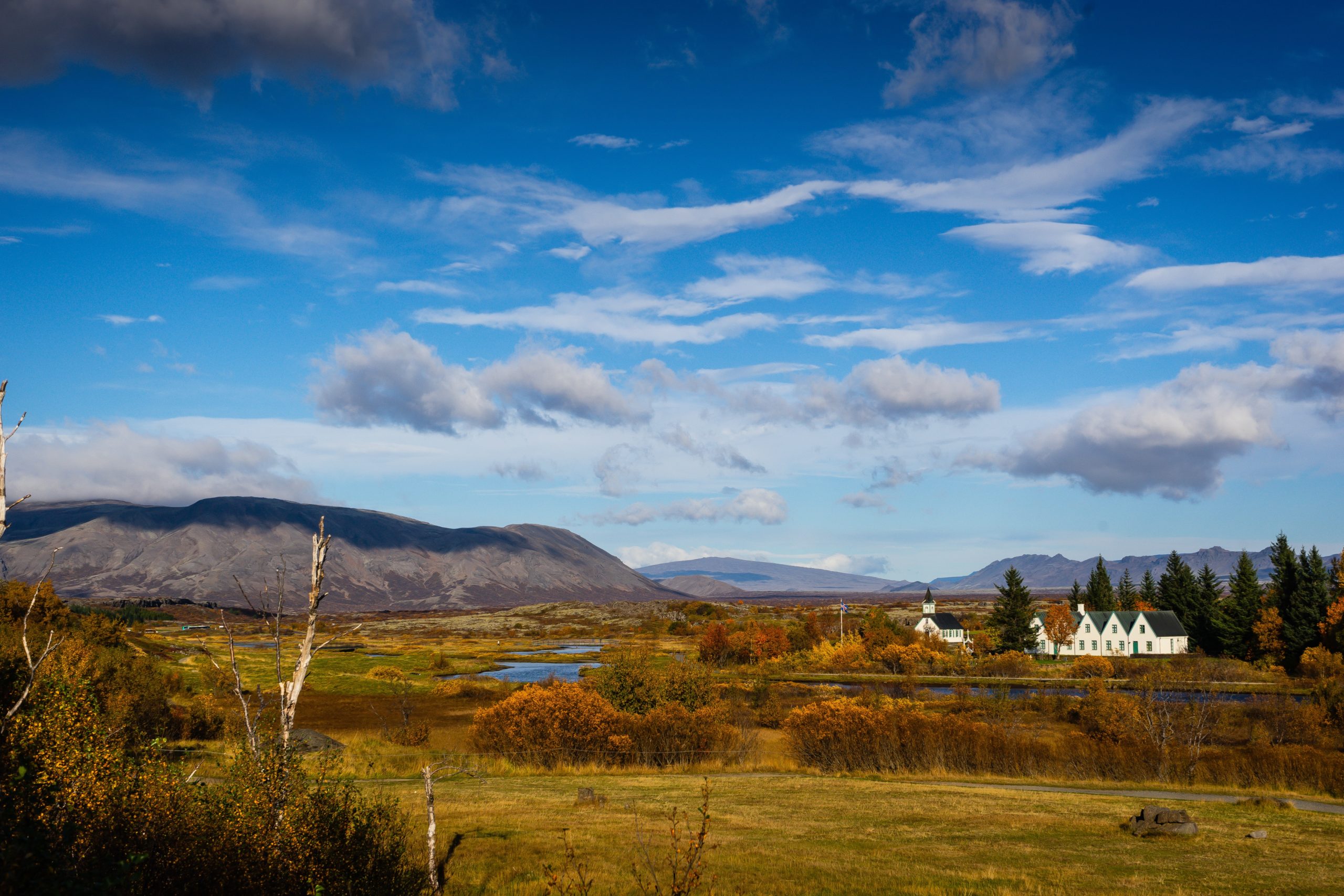
The Golden Circle is Iceland’s most famous sightseeing route, incorporating three major sites that draw visitors in their thousands. The first of these is the UNESCO World Heritage site Þingvellir National Park, a sweeping and unique region of gnarled volcanic meadows and crystal-clear glacial ravines.
After Þingvellir, guests travel a short distance to Geysir geothermal springs, a lively, steam-filled valley composed of sputtering mud pools and hissing fumaroles. Strokkur is, by far, the greatest spectacle here, erupting boiling water into the air every ten minutes, give or take a few.
Next up is the powerhouse, Gullfoss waterfall, marking the third and final part of the Golden Circle route. Dropping 32-metres into a mist-filled canyon, this epic features cannot help but inspire awe and admiration in all those who witness it.
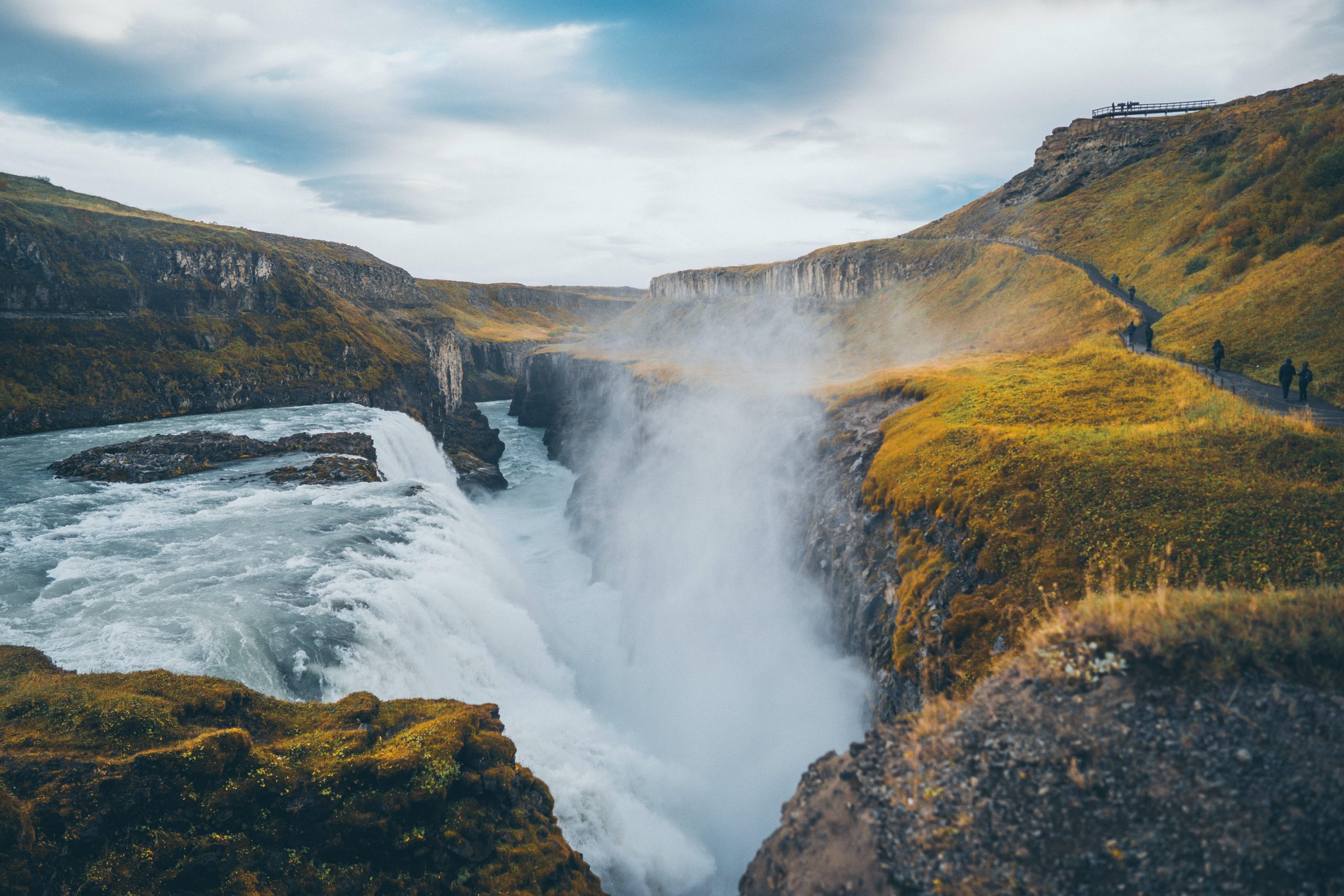
We recommend booking a Golden Circle bubble tour with us to experience all that this great region has to offer, plus bag yourself a night in one of our beautiful Bubbles.
During the tour section, our guides will lead you from one exciting stop to the next, sharing with you fascinating tidbits of information en route, as well as stopping for lunch at the fantastic Mika restaurant in Reykholt.
What does staying in a Bubble overnight offer guests?

New couples, honeymooners, or anyone celebrating many happy years together will all find something to treasure at our bubbles.
Perfect for two people, each Bubble offers comfort in the form of a 180-cm wide bed that sits centre of the floor. Minimalist in its design, but with an instantly knowable Scandinavian feel, you will be left free of distraction, able to focus on the skies above you and, of course, each other.
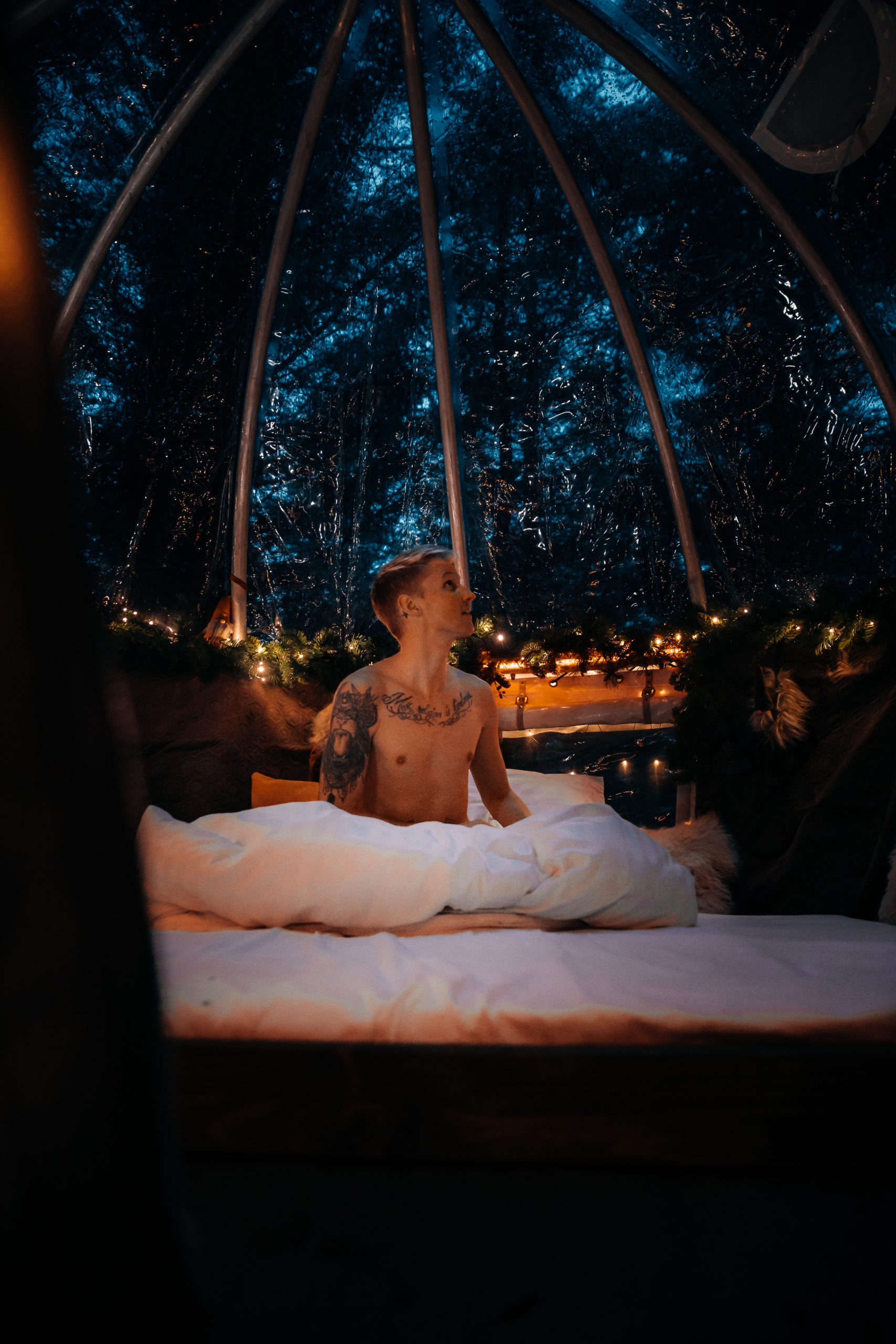
Laying back in on our plush mattresses, you will have the full scope of your surrounding environment. Birch trees enclose the Bubble itself, offering privacy and seclusion amid nature while rolling farmlands and distant hills make for fantastic views regardless of the season.
Those visiting in summer will be privy to all the delights the season has to offer; chirping birds and fluttering butterflies, berry bushes ripe with fruit, and clear blue skies decorated with puffy white clouds that saunter lazily overhead.
Given the Midnight Sun will provide extended daylight hours, we will provide you with a sleeping mask when it comes to time to drift off in one another’s arms.
Extra treats to make your Iceland Honeymoon special.

As if staying in a transparent bubble wasn’t enough, there are plenty of ways to take your Iceland honeymoon to the next level.
For a little extra, we will provide you and your beloved a delicious selection of culinary treats; bunches of grapes, plush strawberries, and, of course, a box of succulent chocolates will all be waiting for you upon arrival.
To wash it down, we’ll also leave a complimentary bottle of Prosecco, chilled and presented in an opulent leather box. Alternatively, we have a wide selection of non-alcoholic sparkling teas and even local craft beer from nearby Ölvisholt Brewery.
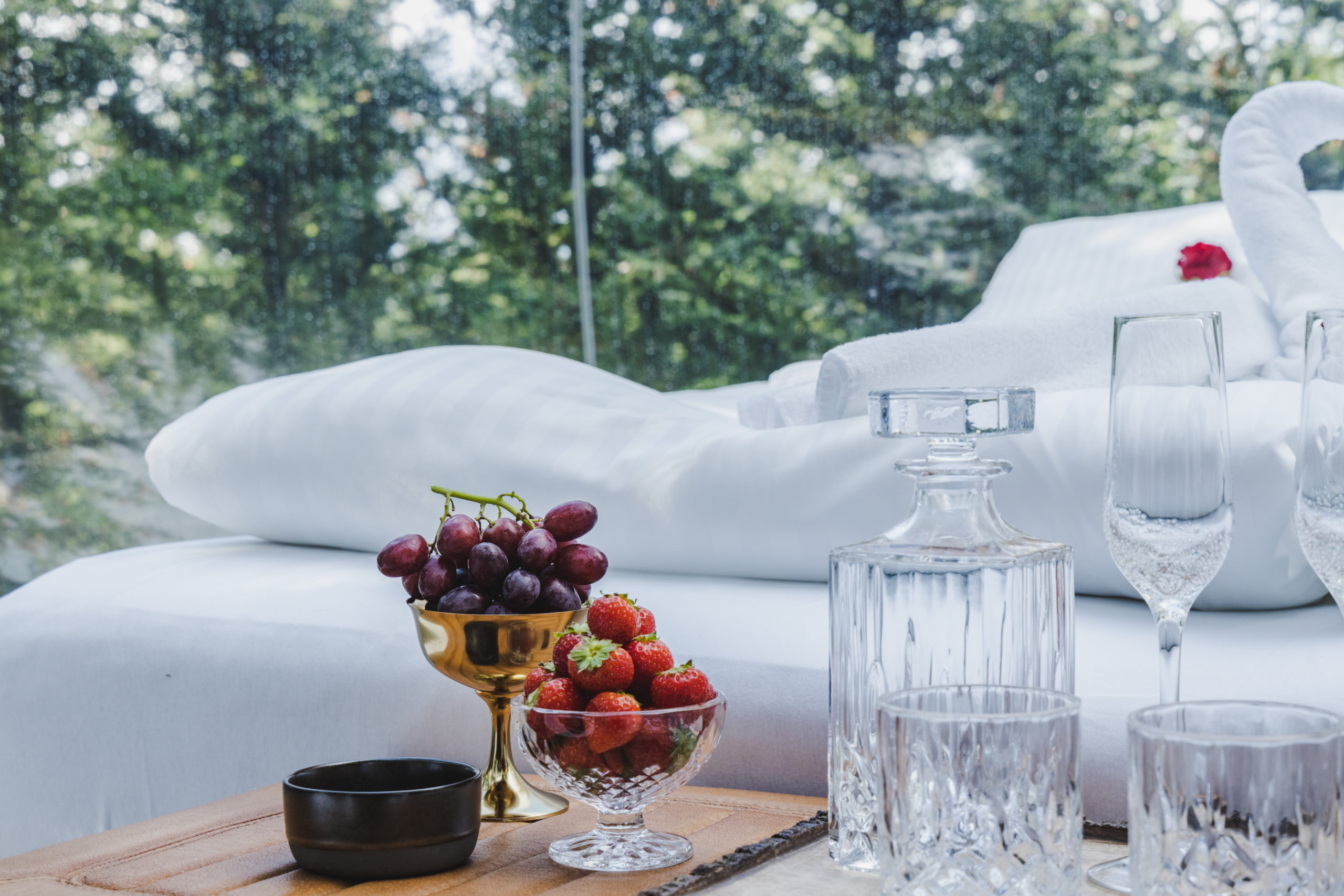
If you decide to take part in our Golden Circle bubble tour, you will also have the pleasure of being driven from site to site in a luxury Tesla SUV. These are the same vehicles used in the US President’s motorcade, so you can be sure of feeling valued and looked after from the comfort of the passenger’s seat.
Whatever your tastes, we’ll make sure you leave the Bubble satisfied, looking back on your Iceland honeymoon with fond memories and greater bonds with those around you. But more importantly than that, we want to throw fire on the furnace that is your love for another.
After all, what emotion but love could describe the feelings that come with soaking together in a bubbling hot tub, or dining opposite ends of the table at one of Reykjavik’s most intimate and applauded restaurants, or even setting off, hand in hand, to seek out Iceland’s best kept secrets?
PLAN YOUR JOURNEY
Travelling to Iceland?
Check our overnight tours with a driver guide that includes a one night stay in a bubble.
*Starting from ISK 59.900 per person
Dyrhólaey | Hidden Gems of South Iceland
Dyrhólaey
By Michael Chapman
Discover its birdlife, lighthouse and dramatic rock arch
Dyrhólaey
By Michael Chapman
Discover its birdlife, lighthouse and dramatic rock arch
Dyrhólaey is a scenic promenade that marks Iceland’s southernmost point. In former years, English seamen referred to Dyrhólaey as Cape Portland, celebrating its appearance as the final sign their voyage had come to an end.
Dyrhólaey reaches a total elevation of 120 metres, making for staggering panoramas over neighbouring Reynisfjara black sand beach. Thanks to its close proximity to Iceland’s Ring Road, most visitors will stop at Dyrhólaey in between this famous stretch of shoreline and the village of Vík í Mýrdal.
From Iceland’s capital, Reykjavík, Dyrhólaey is 174 kilometres away, which equates to a two-and-a-half-hour drive. This distance should not be in the slightest off-putting; the route is dotted with spectacular sights and points and interest from beginning to end.
Dyrhólaey itself boasts incredible views over the South Coast’s black sand shorelines, with clear days providing a full scope of the mountains and sea-cliffs that run parallel to Route 01. Looking north, visitors can witness the creeping ice of Mýrdalsjökull glacier, while to the east, the black totem stacks of Reynisdrangar point skyward like devilish fingers.
Dyrhólaey Rock Arch
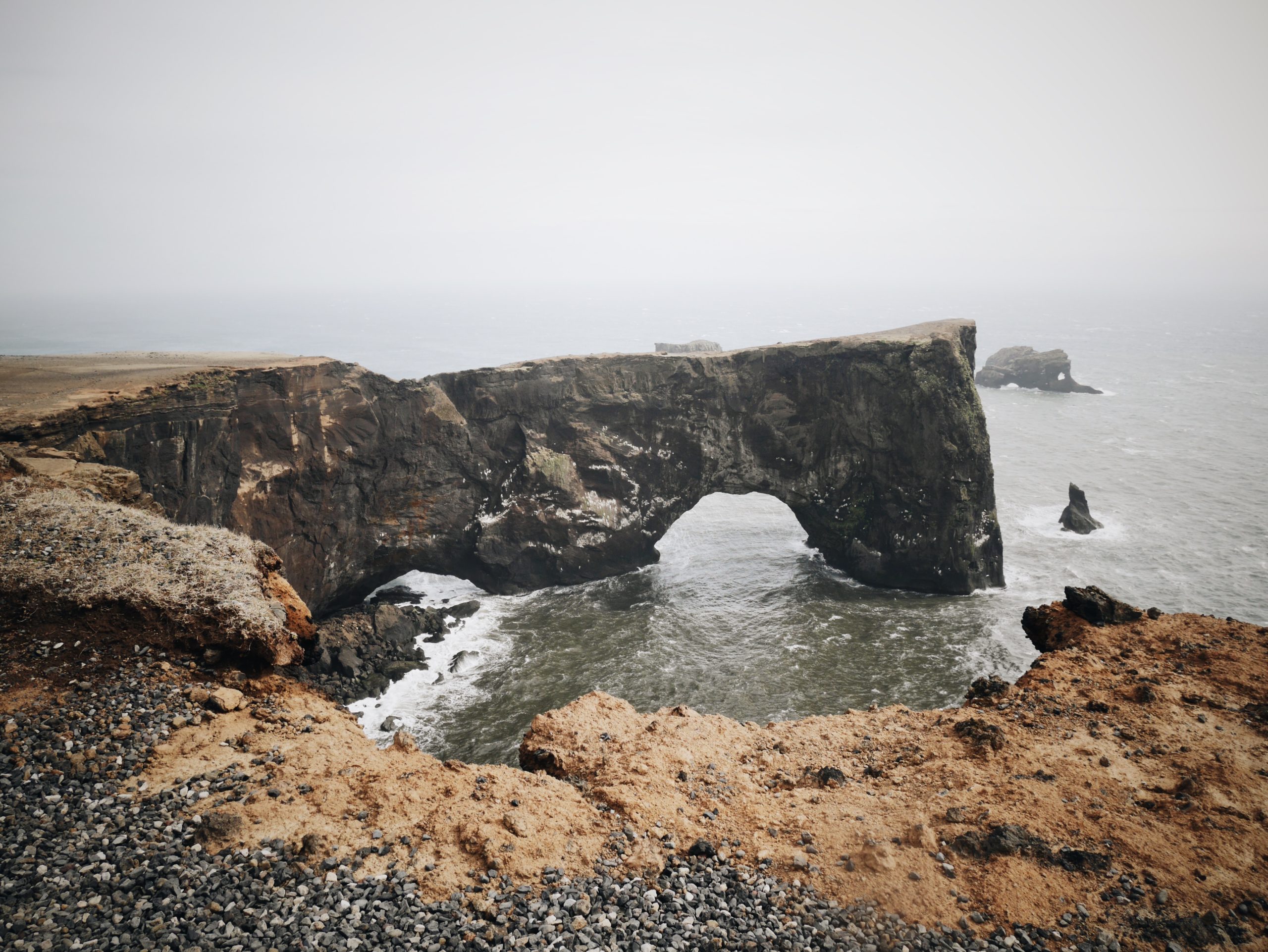
Upon arriving at Dyrhólaey, guests will instantly witness the enormous, naturally-formed rock arch that sits directly below the promontory. This 100-metre wide geological spectacle gave Dyrhólaey its name, Door Hill Island, which also hints at the cape’s past as a cut-off from the mainland.
Surrounded by soaring seabirds, its basalt legs hammered by the frothing white waves of the Atlantic Ocean, one must take a moment to breathe in this spectacular feature for all its worth. With salt circling the nostrils and wind in your hair, you’ll appreciate just how stunning it is, what elemental erosion can do to rock over thousands of years.
Dyrhólaey’s rock arch bores such a gaping hole that smaller vessels have no issue sailing beneath through it. In fact, a thrill-seeking pilot managed to fly both himself and a passenger through the rock arch using a small aircraft way back in 1993, only demonstrating the epic nature of this feature.
PLAN YOUR JOURNEY
Travelling to Iceland?
Check our overnight tours with a driver guide that includes a one night stay in a bubble.
*Starting from ISK 59.900 per person
Dyrhólaey Lighthouse
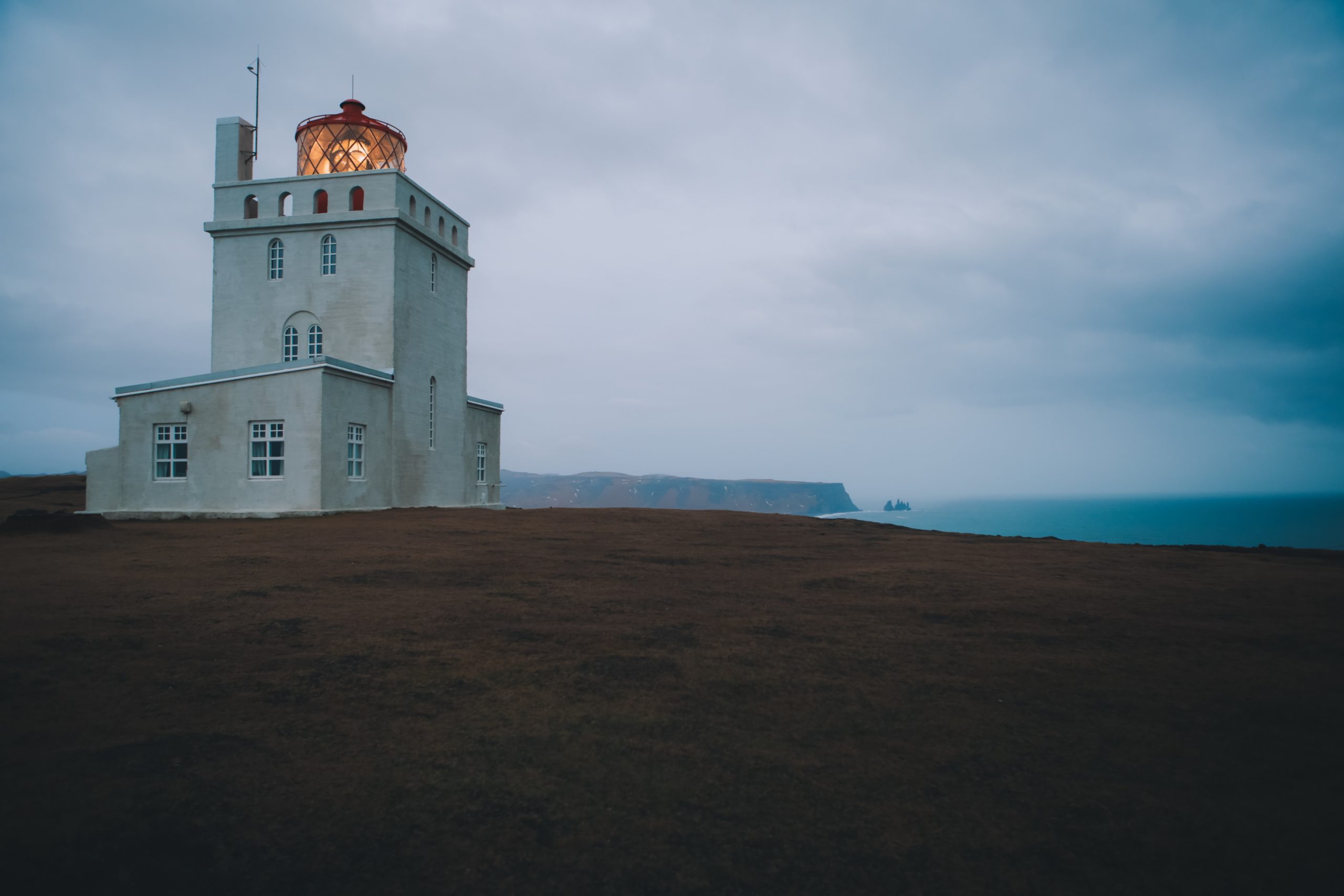
The cape is also known for its picturesque lighthouse. Dyrhólaeyjarviti, as it’s known in the mother tongue, is the second lighthouse built on-site, serving as a replacement to the steel edifice first constructed here in 1910.
Seemingly inspired by ancient Mediterranean forts, the lighthouse seamlessly integrates with the landscape around it, making for a great photography subject with its white paint-job and scarlet roofing. Many compare the structure to a castle with its open embrasures, though it only reaches a total height of 13 metres.
The lighthouse was designed by the Icelandic State Architect, Guðjón Samúelsson, who was also responsible for some of the Capital’s most iconic buildings; Hallgrimskirkja Lutheran Church, Sundhöll Reykjavík swimming pool, and the National Theatre, being just a handful.
See Atlantic Puffins at Dyrhólaey

Atlantic Puffins are migratory species, meaning they will only arrive in Iceland from around April-May. Their winters are spent alone, far out at sea, bobbing on the waves and pecking at the odd fish that shimmies by. Guests on whale watching tours out-of-season will often see these tiny birds floating alone, in between glimpses of this island’s larger marine wildlife.
When they return to land, they do so to nest and breed. The baby Puffins born here (known officially, and adorably, as Pufflings) will grow up to be part of the 8-10 million that routinely travel back and forth to this island.
Atlantic Puffins are monogamous animals and so will have one partner throughout their lives. This fact boggles the mind somewhat considering how these birds can find one another, year after year, despite the distances travelled and the sheer number of waddling lookalikes around them.
Dyrhólaey is just one place in Iceland that the Puffins like to summer, with other favoured spots being the tall cliff sides of Latrabjarg, in the Westfjords, and Heimaey, the largest of the Westman Islands.
Other birds commonly spotted at Dyrhólaey promenade include Eider Ducks, Arctic Terns and Skuas. Dedicated twitchers will want to bring their own binoculars for the best views of the birds in their natural habitat.
Speaking of Puffin watching, it should be noted that access to Dyrhólaey during the nesting season (May-September) is limited due to the risk of nest abandonment and environmental damage. However, guests are free to use the specified walkways between the hours of 7PM and 9 AM, as overnight visitors are considered less disruptive overall.
Safety tips for visiting Dyrhólaey
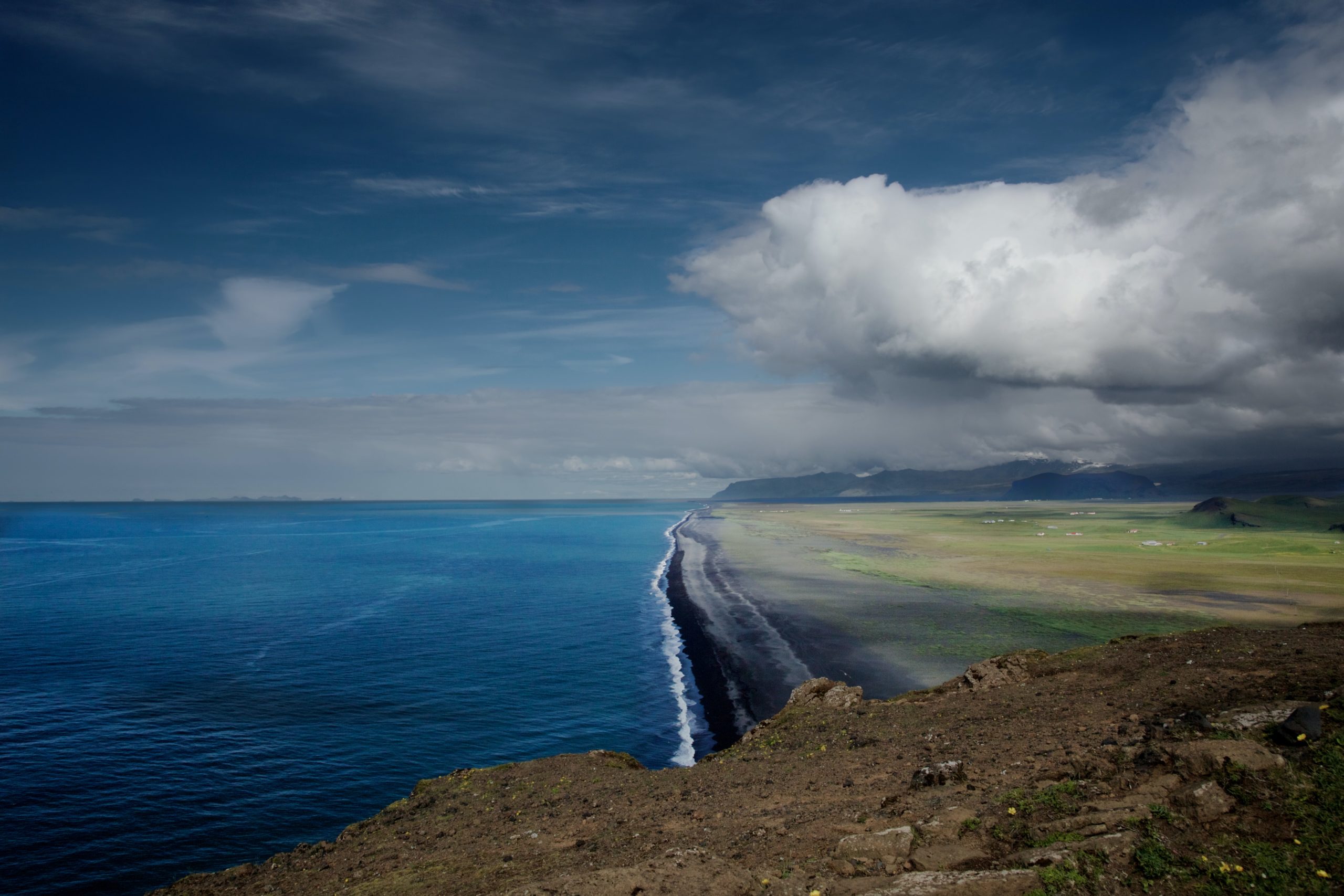
Iceland. However, there are a few other considerations to account for before cementing this as a surefire stop on your schedule.
Families with small children might want to consider that the cliff sides at Dyrhólaey have no safety boundaries, meaning it is, theoretically, possible to walk right up to the edges. If you are planning to visit with kids, it is essential that you warn them of the dangers of getting to close and keep watchful of them throughout your stay.
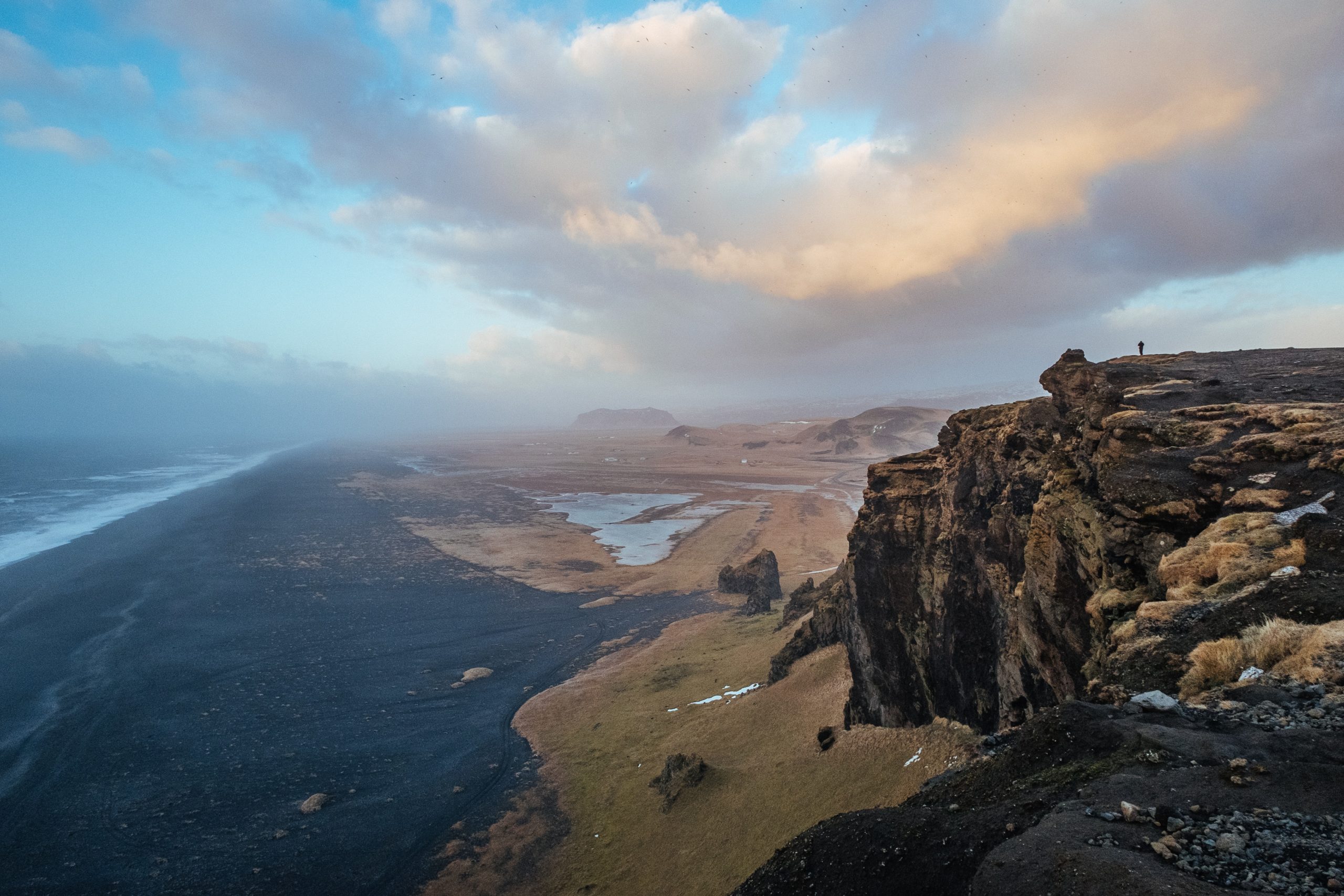
Another safety tip to keep in mind is that Dyrhólaey is totally exposed to the sea, meaning it bears the brunt of strong winds almost constantly. Driving up the steep and winding gravel road towards the lighthouse can be unnerving on windy days, so a 4×4 vehicle is always recommended. Even if that’s the case, easily-frightened visitors might consider skipping this in favour of interests further inland.
A quick glance over TripAdvisor will quickly inform you most people consider conditions at Dyrhólaey to be bracing. For that reason, you will want to make sure you are dressed appropriately in a wind and waterproof jacket, sturdy hiking boots, thick thermal layers and the other usual accessories (eg. hats, gloves and scarf).
Explore Dyrhólaey on Iceland's South Coast
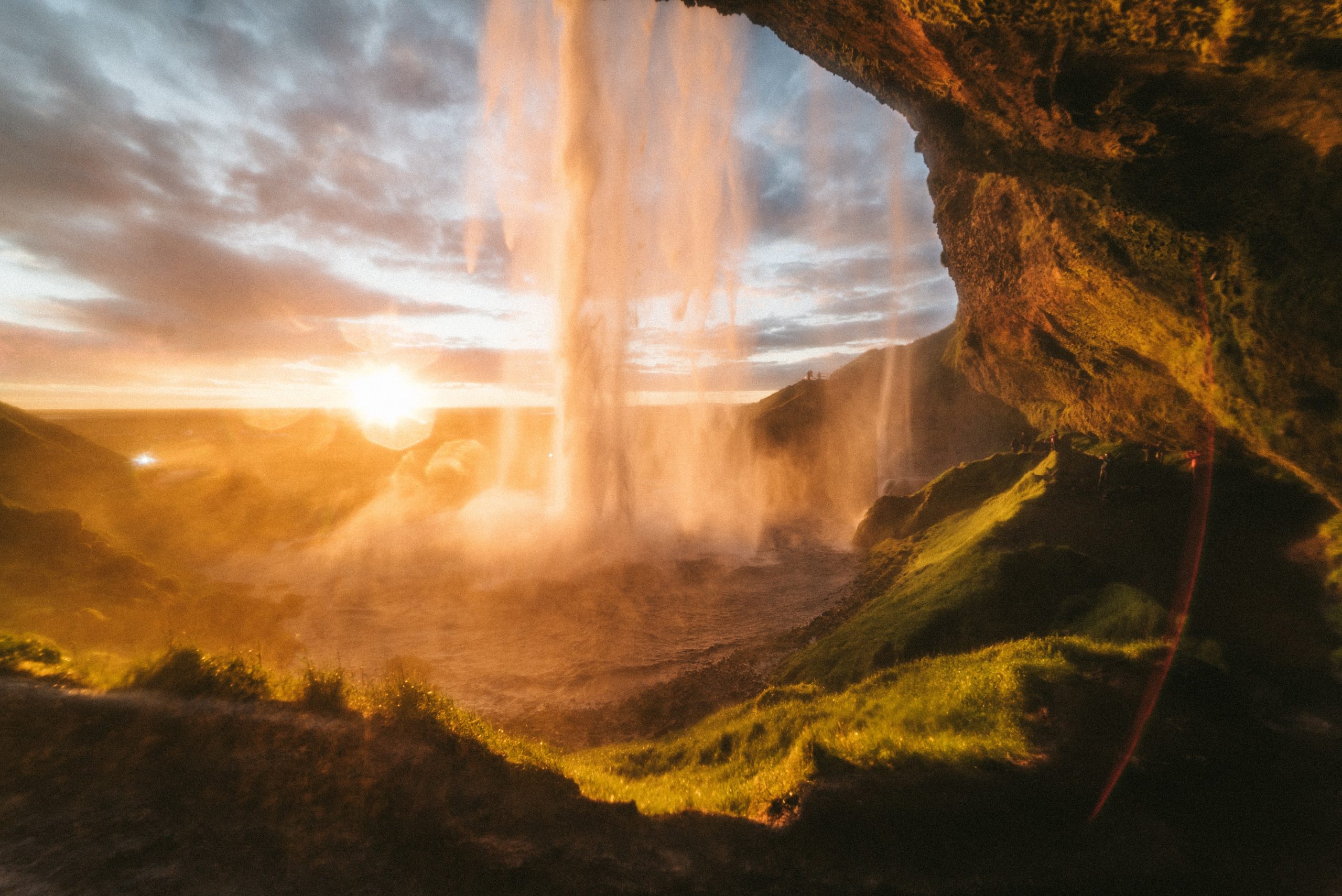
Of course, Dyrhólaey is just one of the many natural attractions located on the South Coast. Others that have become popular among visitors over recent years include the two stunning waterfalls, Seljalandsfoss and Skogafoss, and the widely-photographed DC-Solheimasandur plane wreck.
If you are interested in exploring this majestic region, make sure to book a South Coast Bubble tour with us. Not only will you bag yourself a guided trip that includes stops at all the major sites, but also an overnight stay in one of our cosy and transparent bubbles.

Such a novel accommodation choice is fantastic for a multitude of reasons. Throughout the winter night, you will be able to watch out for the elusive Northern Lights overhead, all while tucked up comfortably in bed. If the auroras are nowhere to be found, you’ll still have a blanket of starlight to send you soundly off to sleep.
On the other hand, summer guests will experience what it’s like to stay overnight in a luscious woodland bathed beneath the Midnight Sun. Nothing describes the inner peace and connectedness with nature that one feels the morning after such an experience.
PLAN YOUR JOURNEY
Travelling to Iceland?
Check our overnight tours with a driver guide that includes a one night stay in a bubble.
*Starting from ISK 59.900 per person
